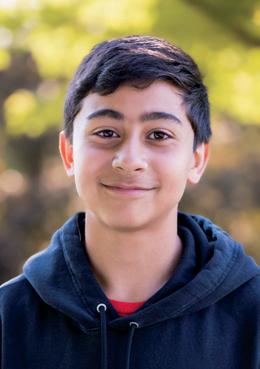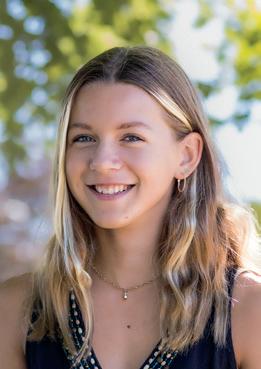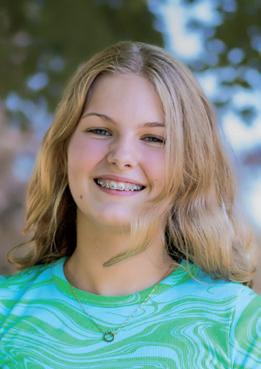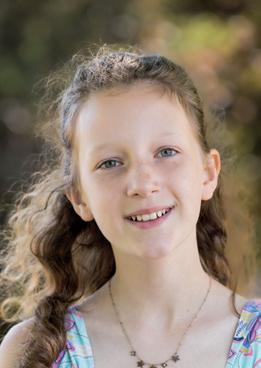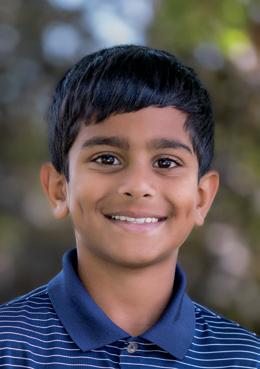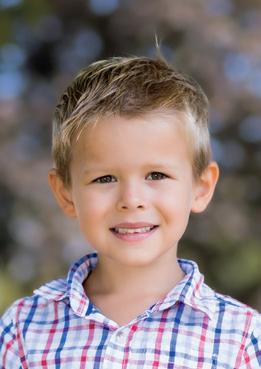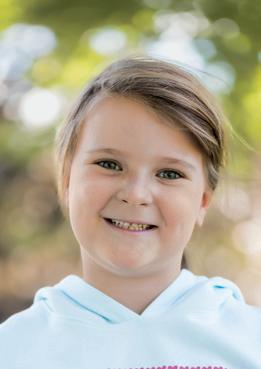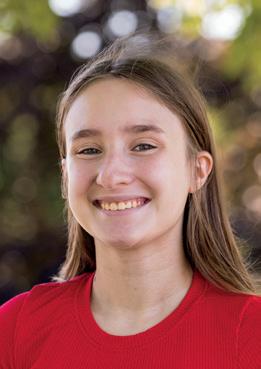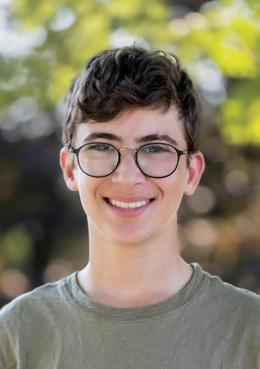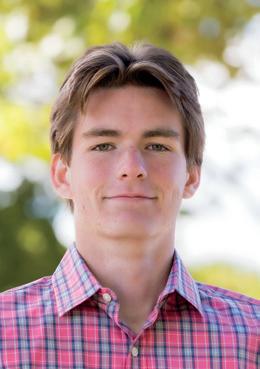What Does THRIVING Look Like?
Any chef can tell you what goes into a successful recipe: the right ingredients in judicious amounts, mixed properly, then cooked with care for just long enough. Too much salt, too little baking soda, too energetic a hand with spices and herbs, too hot an oven, and the dish fails.
Creating a successful school, one where students learn and grow beyond limitations and expectations—where they can thrive—requires similar care. It’s a challenge dear to the heart of every educator and staff member at North Shore Country Day.
They work to build a recipe composed of academic rigor and creative flexibility, as well as advising and support for every student. And that, they believe, will enrich the students with whom they interact every day in classrooms, hallways and
elsewhere on campus. It will, in short, help them thrive.
But just what comprises thriving?
For NSCD educators, it includes respect for the whole child, inclusion, a determination to meet students where they are— academically and socially, as well as mentally and emotionally—and the resolve to help them learn, both in and beyond their comfort zones.
Head of School Tom Flemma says school educators have focused on a skills curriculum, one aimed at equipping students with tools they can use in any situation, and in new environments. Those skills are integral to thriving, he adds. Beyond that, NSCD educators and staff “have a sense that we have to tend to all the various aspects of kids’ lives…and that we really work hard to do that when we build the school community.”
Lauren Collins, the school’s director of equity, inclusion and community engagement, says thriving comprises factors that are crucial to students’ lives, both in the classroom and their future lives. That includes their becoming resilient and adaptable, adventurous, and open-minded.
Assistant Head of Upper School Brian Frederick believes students thrive by finding the sweet spot between academic learning and learning in other ways; for example, discovering how best to become a team member, or a leader, with fellow students.
Engagement is key for Caitlin McLennan, assistant head of lower school: “The students, the families, are willing to get involved, and everyone recognizes that school is made up not only of academics, but social and emotional growth, too.”

acorn · Winter 2023 5 feature
Parents can define other parts of the NSCD recipe. John Bogie, parent of Lily ’27, sees NSCD as a place where “your child will not be left behind, will not be overlooked, will not just be a punch card.”
Cy Oelerich ’89, parent of Buckley ’23 and Dixie ’26, says teachers want to see the best in their students: “They’re dedicated to getting the most out of them.”
“I think middle school is the perfect time to make mistakes,” says Assistant Head of Middle School Rachel Sun. “It’s a middle schooler’s job to make mistakes and to learn from them. There will always
be something in their lives where they won’t excel. Knowing how to make a Plan B after you make a mistake; that’s a lifelong skill.”
Lauren thinks the vast majority of students at the school thrive because they have multiple on-ramps to learn what they are good at. She also says NSCD programs are intentionally curated to work with each child in their entirety, a practice she says is grounded in the school’s progressive pedagogical philosophy.
One of the keys to working with the whole child and helping each one thrive, she said, is helping them become ethical human beings.
“We have programs that talk about diversity, equity and inclusion. That means thinking about the person next to you, it means asking questions. What does it mean to be upstanding? What is social justice? How do I work with people who are different than me? How can I be inclusive? They don’t always get it right, because they’re children. But they are getting the message,” she says.
NSCD parents also value diversity, and the school’s dedication to it. Vanessa Colman, parent of Naia ’31 and Emmett ’33, and Molly Oelerich ’87, a parent and also a former school trustee, both say the school’s student population more closely reflects the real world than many other schools in the area.
Every successful recipe balances multiple ingredients in order to create a memorable dish. Assistant Head of School Mary Fielder says North Shore Country Day’s rigorous academic and academic-adjacent programs are core ingredients.
In lower school, that’s reflected in the specials classes—technology, visual arts, music, Spanish, physical education among them—taught by instructors other than students’ home room teachers.
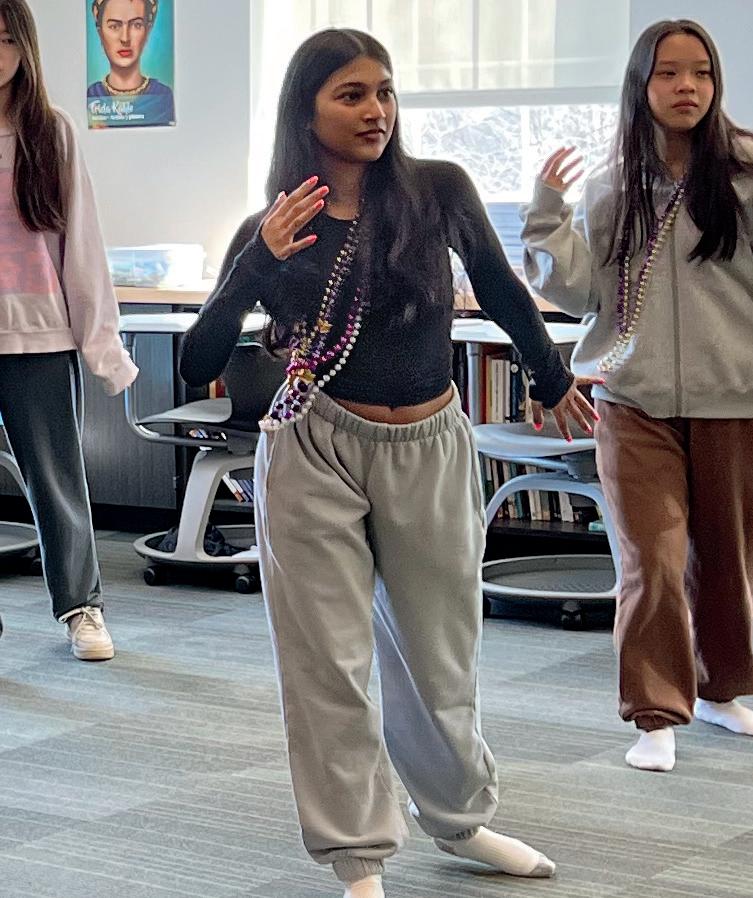

Middle school students face specific requirements, she says. They must take a yearlong arts class, and must make choices among a set of trimester-long performing arts, music, or STEAM (science, technology, engineering, arts and mathematics) classes, Mary says. They are also required to take physical education classes:

6 feature
NSCD programs are intentionally curated to work with each child in their entirety, a practice grounded in the school’s progressive pedagogical philosophy.
“We have more physical education than other schools. We believe kids need it.”

Mary says the tradition of robust education continues in upper school. In addition to core classes, students must take two years of art and play a sport for at least three years. And the requirement that upper school students take part in two theatrical productions, either onstage or backstage, “is distinct to us, I believe…it grows students’ confidence in ways that are extraordinary.”
Just as successful recipes incorporate ingredients creatively, North Shore Country Day incorporates creativity into the way students learn academically. One example is the math circles program available to lower and middle school students, says Graham Rosby, head of the NSCD mathematics department, and a middle and upper school math teacher.
In the informal gatherings, held once a month, as many as 30 students are introduced to mathematical concepts—often highly advanced ones—that are engineered for accessibility to young learners. It’s a way to help minimize students’ fear of the subject, Graham says.
“It’s all about having a sense of play about math. Students have a big fear about doing something wrong in math. They think that math is about getting the right answer, and they’re paralyzed by that. We turn that on its head and say math is about asking questions,” he says.
The school’s sense of community helps students at all levels thrive.
The school’s sense of community helps students at all levels thrive. For instance, lower school students have Friday gatherings where they can show each other what they have learned, or are learning, Caitlin says.
Each event is hosted by fifth grade students who work with teachers to create a hosting script; they take on the responsibility of leading the gathering, while students in a rotation of classes share activities or lessons they’re learning; first grade students have shared haikus they’ve

written while learning about poetry. Another time, a reading specialist might share a video featuring kindergarten students.
Every gathering includes announcements, but ends with jokes told by the lower school head—jokes that students can put in a special box. The gatherings are “a really important feature of bringing out students’ excitement and engagement,” Caitlin says.

Rachel believes the advisory program for students in the middle school is one of North Shore’s strengths. When they enter middle school, each student is assigned to an advisor. They have advisory periods during the week (two 15-minute sessions and one 45 minute session) during which they can interact with their advisor and with each other.
One advisory activity, known as open session, allows students to anonymously post about things they’re struggling with and need help on. It allows other students in the advisory (there are usually 13 or 14 students in each advisory group) to problem solve, Rachel says, adding, “It’s a great
acorn · Winter 2023 7
opportunity for the question asker to get advice from their peers. It also builds empathy.”
Sometimes, positive developments at the school can come from negative events, especially those like the coronavirus pandemic.
“One of the things the pandemic really highlighted for us, is how intensely relational learning is,” Tom says. The lessons learned during the pandemic highlighted concepts NSCD educators already believed, that physical, emotional, and intellectual health and wellness couldn’t and shouldn’t be untangled from successful learning.
Brian agrees, saying, “You’re not going to be able to be successful and thrive, if you don’t understand wellness, if you haven’t talked about mental health challenges. If you’re in crisis, if a friend’s in
crisis, if a family member is in crisis, who do you turn to? When I was in school we never talked about it, but it’s part of the full picture of any student.”
New upper school students benefit from an “Intro to Upper School” conversation with upper school counselor Terri Webb, who is also director of counseling at the school, Brian says.
The school also provides 10th grade students a daylong workshop run by the Northfield-based Josselyn community mental health organization, he says. They learn about mental health challenges, and how to talk about the ones they’re experiencing. They also learn how to recognize when their friends need help, and how to offer that.
“The feedback we get from students and parents [about the mental health first aid
How Students Define “Thriving” at NSCD
Students can also define what they think thriving at NSCD is. Some of them were invited to do just that.
DANIEL BECKER ’24: “The friendships and relationships … that’s a really important part of thriving…There are relationships you build with students, and that extends to faculty as well.”
AMELIA MILLNER ’27: “At North Shore, it looks like hands-on and fun learning. It feels like belonging in our community. It looks like taking chances that you’re not used to.”

OLIVER POWELL ’26: “It’s teachers and students in harmony.”
JACK RYAN ’23: “It means exceeding your own expectations.”
SOPHIA STORINO ’29: “I got involved in improv. It’s something I would never have done before, but I figured it could help me learn to think on the spot, I definitely failed a lot, but it helped…You have people who’ll support you. Because even if you don’t hit the target with your catapult, you still built a catapult.”
curriculum], is that this is important, that it shows our commitment to continuing to educate our community on mental health and supporting one another,” he says.
In upper school, lessons learned during the pandemic led to a reimagining of the club system, Brian says.
Previously, finding time for clubs outside of the regular school day was tough for students with busy schedules, so after the school returned to fully in-person classes, administrators decided to try something new and build a time for clubs into the schedule. “Club leaders would be able to work with teachers to create an agenda they could send out to students who would be interested,” he says. This also gave students the chance to exercise club-building abilities that remote learning made much harder practice, he adds.
NSCD found this kind of educational silver lining to the coronavirus pandemic; perhaps it’s because school educators have long valued what might seem a counterintuitive strength—failure. What’s more, parents and students agree with the idea as well.
“You can demystify failure,” Tom says. “It’s iteration, it’s improvement.”
Mary says students learn that not everything they do is going to go well, “and in this environment, the response of fellow students and of teachers isn’t ‘Clearly, that’s not your thing.’ They respond supportively. Students know they can try again.” Minimizing the fear of failure also allows students to take chances, to try things they’ve never done, and in doing so they may discover they have more than one passion, she says.
EDGAR ROMERO ’25: “You feel almost invited to come to North Shore. I thought it would be a little harder fitting in, since I was new. But I felt very welcome.”
KAI KESWANI ’31: “The school is amazing. It feels like a home. It feels like my home.”
What does Head of School Tom Flemma think of those evaluations?: “These are some pretty awesome kids!”
8 feature
While the school focuses its attention and effort on students, NSCD educators and parents know kids do best when the adults around them also thrive.

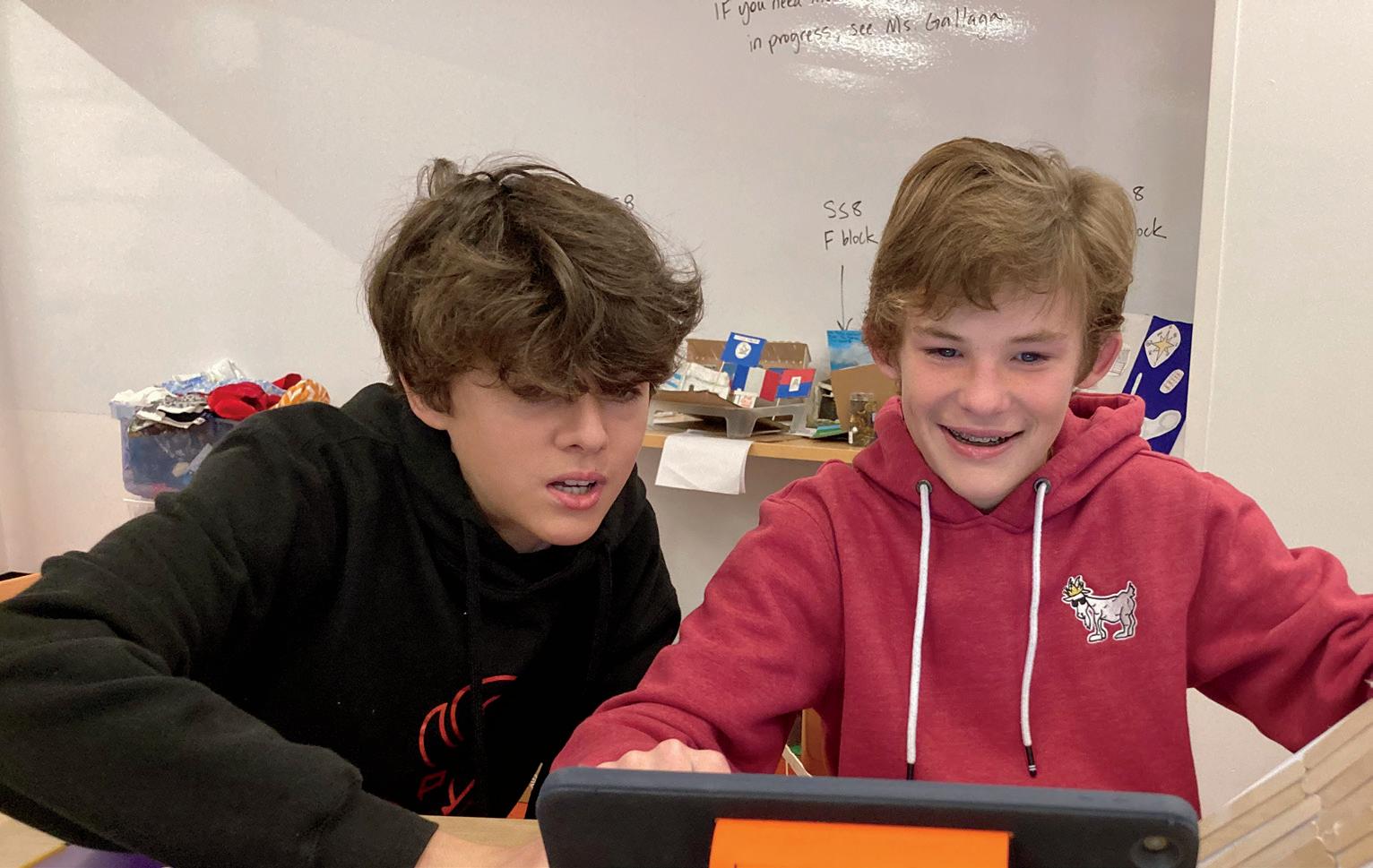

Lauren says that being part of a school community that’s willing to challenge the status quo helps her thrive. The administrative team “works on the basis of humanity, responding to the whole child. We also respond to adults that way.”
For Rachel, a key component of thriving, whether as a student or adult, “is feeling that you can show up as your authentic self, that you will be seen and heard and welcomed.”
Parent Susan Millner says daughter Amelia ’27 and her lower school siblings, triplets AJ ’30, Elliot ’30 and Sadie ’30, are all thriving. For her, that means, “North Shore sees kids as whole people, both who they are now, and as they can be in the future.”
Susan remembers the support she received from the Parents’ Association’s Helping Hands Committee when her family was going through some health challenges several years ago. Other parents—some of whom she didn’t even know—volunteered to assist with meals and help in other ways. It made such an impact on her and her family that she now heads that program. You don’t find that kind of community anywhere, she explains. People really care.
Any good chef can tell you how to create a recipe, but they know it takes a little extra to create something memorable. NCSD is proof of that in many ways.

Ashvini Keswani, parent of Kai ’31 and Kavya ’29, says the school feels “like a happy place” whose energy makes her glad her children are students here.
Components like joy, happiness, dedication and engagement are certainly ingredients in the NSCD recipe.
Rachel agrees. In the end, she says, “It’s a joyful place to be.”
NSCD educators believe that physical, emotional, and intellectual health and wellness couldn’t and shouldn’t be untangled from successful learning.
LIVING A LIFE OF SERVICE
DR. PAULA CASTILLO ’90
The therapy room where Dr. Paula Castillo ’90 sits to talk about her North Shore Country Day experience is comfortable and colorful. A large Guatemalan tapestry brightens one wall and opposite to it hangs a painting of a smiling Guatemalan girl. Both are nods to Paula’s heritage.

Snuggling next to her is Molly, her 15-year-old Jack Russell. Molly is a therapy dog who comforts patients during their therapy appointments at Centro Castillo for Personal and Family Wellbeing. Providing a safe and comfortable environment for patients to heal through psychotherapy has been a priority at the center ever since the NSCD alumna founded it 15 years ago.
Paula can draw a line between what she learned at North Shore and the center’s mission, which in part states Centro Castillo exists to “provide culturally sensitive services to men and women of color by recognizing and appreciating the impact that one’s heritage and language has on one’s view of themselves and the world around them.” She says North Shore’s “Live and Serve” motto “is a reminder that you’re supposed to be living a life of service. … That’s what we try to do here.”
Paula’s road to NSCD, and ultimately to Centro Castillo, began when her parents, Vilma and Gustavo Castillo, moved from Guatemala to Chicago in order to give their three children access to a higher level of education by removing some of the obstacles they themselves faced.
They had a memorable welcome to the city. Two months shy of age 7, Paula clearly recalls arriving in December during Chicago’s historic blizzard of 1978. The Castillo family settled in Chicago’s Albany Park neighborhood. Her parents enrolled their children in Catholic schools, instilling discipline and good study habits along the way. When it came time for her older sister Ana Castillo Blaze ’88 to attend high school, her brother Alejandro learned of a program called “A Better Chance,” an organization that places highperforming students of color into some of the nation’s best independent and public schools, and supports them on their journey. Each of the girls applied and was accepted to the program and to North Shore Country Day. Paula had a two-hour
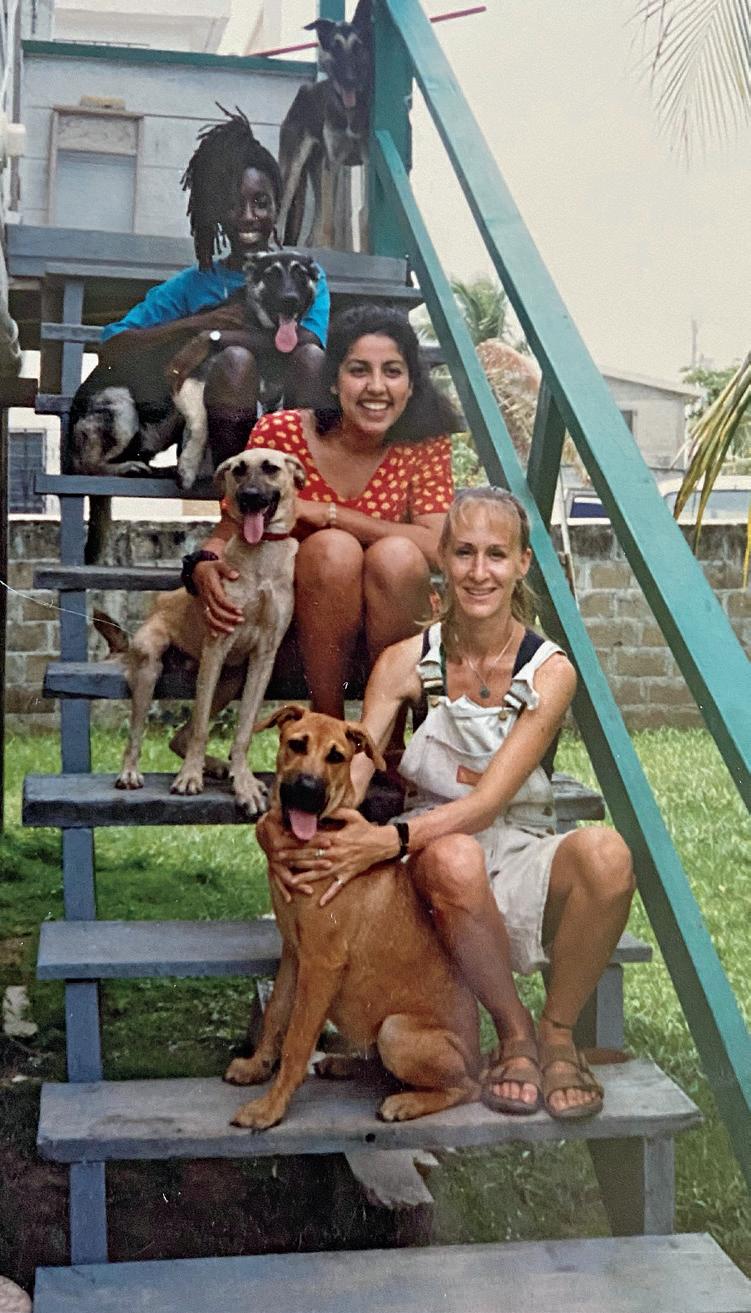
10
Peace Corps in Belize
Dr. Paula Castillo ’90 and her dog Molly
commute taking three CTA trains and one bus each way to get to school from Albany Park—a commute she willingly made, thanks to the strong value of education and goal-focus her parents instilled in her.
Paula says she had no idea what to expect of North Shore, but she quickly grew to appreciate what the school offered. “It allowed me a greater likelihood of taking part in a wide variety of activities.”
Paula took full advantage of that.
She was athletic, playing volleyball in the fall, basketball in the winter and swimming competitively in the spring. She says NSCD helped her develop leadership skills as well; she was class president in her junior year and vice-president of the student body in her senior year.
North Shore also nurtured her artistically. She took part in the school’s fall plays and spring musicals, and undertook choreography as dance captain. “Theater was what I thought would be my career,” she says. “Theater was my life.”
She remembers college counselor Sharon Cooper had to convince her to apply to other colleges in addition to New York University, which she had her heart set on so she could study theater. She did end up branching out and received many acceptance letters.
The seeds of her future career had arguably already been sewn. In senior year, she was expected to take part in the school’s science fair, but her family could not afford the type of materials needed for most science projects.
When she explained this to physics teacher Jan Migaki, the teacher offered her a creative solution. She challenged her to focus on psychology as a science, so Paula spent her spring break attending an all-male high school studying the effects of a female on male study habits. Paula acknowledges that Ms. Migaki did not make her feel bad but instead helped her to flourish.
She was accepted into the theater program at NYU’s Tisch School of the Arts, but again faced financial obstacles and had to withdraw her acceptance. She says her math teacher, Shirley Smith, found her crying in the washroom and took her to speak with Mrs. Cooper. “Mrs. Cooper called up Boston University right then and there … and asked if my acceptance offer was still available,” she says. “They activated my acceptance and financial packet, and thus I went to Boston University.”
By the end of her freshman year in college, Paula knew she had to decide between pursuing theater or the field of psychology. Junior year psychology internships abroad in Spain and London cemented her decision, she says.
“In the end, the choice came naturally, because listening was something that came naturally to me.”
After graduating in 1994 with a major in psychology and minor in Spanish literature, Paula joined the Peace Corps, serving from 1995 to 1997 as a health educator in Belize. In 1997 she resumed her studies, graduating in 2001 from the California School of Professional Psychology with her doctorate in psychology with an emphasis on multicultural community clinical psychology.
She returned to Chicago and after four years working with children of color and wards of the state, she transitioned to the private sector. However, she grew dissatisfied with the way she saw Latinos and other people of color being treated.
For instance, she said, a patient that one of her colleagues evaluated as having cognitive disabilities was actually clinically depressed, but since English was a second and nondominant language he could not communicate that well and thus was pathologized. She also saw instances of deliberate bias that convinced her to leave.
“I went to China for my 35th birthday and spent two weeks contemplating life.
I decided I couldn’t support a practice that used the community of color just to make money. When I came back, I resigned. And six weeks later Centro Castillo started.”
Today, Paula is clinical director with a team of 14 therapists, all Spanish speaking and from different Spanish-speaking cultures, providing 11,000 clinical hours a year at three Chicago locations. That is in keeping with Paula’s desire to live and serve for Chicago’s various Latino communities: It allows patients to receive help close to home, in the language of their choice, which makes the experience less daunting.
Paula says her team supports each other, adding, “There are two parts to the mission; we’re here to support communities of color, but also to support clinicians of color.”

Outside of work, she still focuses on service. She volunteers on an annual medical mission trip to Guatemala as a translator with a faith-based organization (also allowing her to visit her parents and her 102-year old paternal grandmother). Other passions include international travel, and during the pandemic got into sewing and gardening.
When Paula looks back at her time at North Shore, she remembers what she learned from people like theater director Roger Shipley, who instilled these words of wisdom: “All you need to know is what you don’t know,” he said, because then you focus your efforts on what you need to learn, and constitutional law teacher John “Jack” Ingram, whose tough lessons taught her to “keep on trying.”
“North Shore gave me a guiding light. I truly give North Shore credit for allowing me to flourish.”
acorn · Winter 2023 11 feature
Paula can draw a line between what she learned at North Shore and the center’s mission, which in part states Centro Castillo exists to “provide culturally sensitive services to men and women of color by recognizing and appreciating the impact that one’s heritage and language has on one’s view of themselves and the world around them.”
Medical mission in Guatemala
Dr. Becky Shares Tips on Becoming the Parent You Want to Be
More than 80 North Shore Country Day parents came to the Hall Library on October 7 for an exclusive discussion with parenting expert Becky Kennedy, Ph.D., who talked about some of the strategies featured in her new book, “Good Inside— A Guide to Becoming the Parent You Want to Be.”
Over the past several years, the clinical psychologist known to her followers as “Dr. Becky,” has been sparking a parenting revolution. Millions of parents, tired of following advice that either doesn’t work or simply doesn’t feel good, have embraced Dr. Becky’s empowering and effective approach, a model that prioritizes connecting over punishment. In her highly anticipated first book, Dr. Becky shares her parenting philosophy, complete with actionable strategies, that will help parents move from uncertainty and self-blame to confidence and sturdy leadership.

Oftentimes, parenting advice focuses on eradicating bad behavior and enforcing compliance at the expense of the
parent-child relationship. Rather than temporarily fixing bad behavior, Dr. Becky focuses on what’s under the surface in order to change the dynamics that motivate that behavior.
The discussion was hosted by the Parent Education and Family Action Network (FAN) committees of the Parents’ Association, and moderated by NSCD’s own Kristen Kaczynski, Director of College Counseling, Student Success and Institutional Research. Special thanks goes to current parents Pascale Dunaway, Alison Fitzgerald, and Frieda Molina for their work putting this event together, and FAN Executive Director Lonnie Stonitsch, a former NSCD parent.
While in Chicago, Dr. Becky also spoke at two larger public events, but thanks to the school’s longtime relationship with FAN, NSCD parents enjoyed a more intimate conversation especially for school families. Attendees and interested faculty and staff received a complimentary copy of her book.
Dr. Becky touched on the importance
of job clarity as it relates to effective parenting. “You can’t do your job well if you don’t know what your job is,” she explained. “A parent has three jobs: to set boundaries, offer validation and provide empathy. Kids have one job: to experience and express all their feelings—so we can teach them how to regulate them.”
She also talked about the power of repair in parent-child relationships. Parents are never going to be perfect. But how they respond in their moments of struggle can have a lasting impact on their children. “If you’re going to do one thing well as a parent, this is what it should be,” she said. “Repair is the process of going back to someone after a moment of disconnection and reconnecting. When you repair, you are opening up the book and rewriting the ending to that chapter. Memory changes when you infuse connection into a moment that didn’t feel good. We add in understanding, we add in connection, we add in compassion and it changes how those memories live in the body. It’s like magic.”
12 parents’ association
Jessica Shinn, Pascale Dunaway, Becky Kennedy and Kristen Kaczynski
Fall Divisional Gatherings
In November, the PA hosted parent gatherings for each division. Members of the administration, including Head of School


Tom Flemma, Assistant Head of School
Mary Fielder and Director of Equity, Diversity and Community Engagement
Lauren Collins were joined by divisional leadership to provide a lively panel discussion. Parents enjoyed refreshments while participating in this special opportunity to meet with administrators in a smaller group setting and discuss topics specific to their students’ division. Lower school leadership talked about the curriculum, highlighting new programs and STEAM collaborations. Middle school discussed parent-school communication, technology use and supporting student mental health. The upper school conversations focused on the college process and wellness, including mental health.
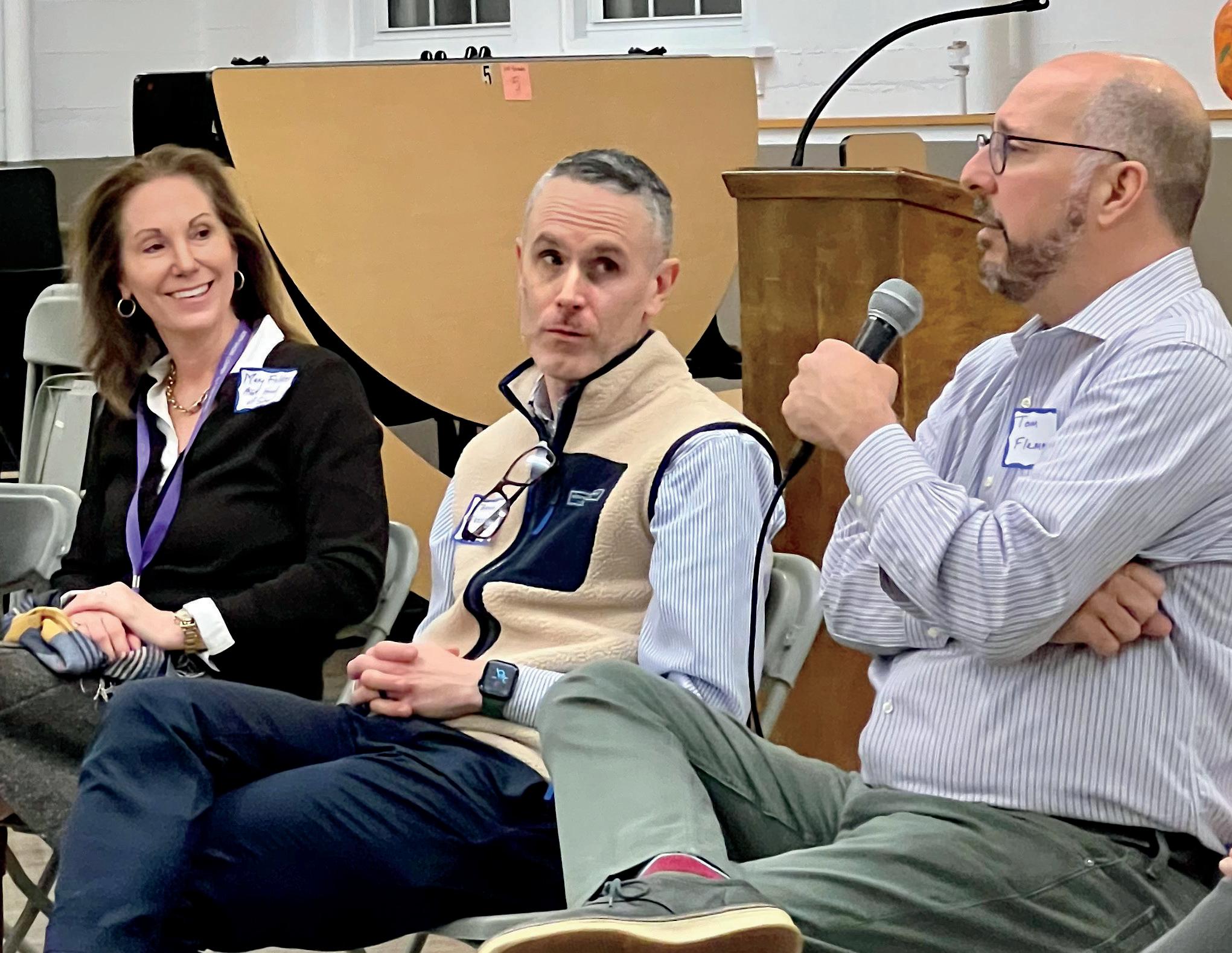
Teacher Appreciation
Our PA Teacher Appreciation Chairs
Lynn Ryan, Ellen Knight, Malessia Howland-Pickering, Janelle Wood, Bethany Schwartz and Kim Frezados, as well as the volunteers on their committees, have been busy behind the scenes, providing treats, meals and encouragement to our teachers throughout the school year. We truly appreciate their creativity, commitment and hard work! If you would like to help the PA recognize our amazing teachers and staff, please remember to contribute to this year’s Faculty/Staff Appreciation Gift. You should have received a letter and email inviting your family to participate. We are so grateful for the generosity of parents who recognize all of our wonderful faculty and staff. To contribute, you can send a check to the school to the attention of PA Treasurer Toya Chatman, or online via Venmo @nscds310 or via PayPal at PayPal.me/nscds.
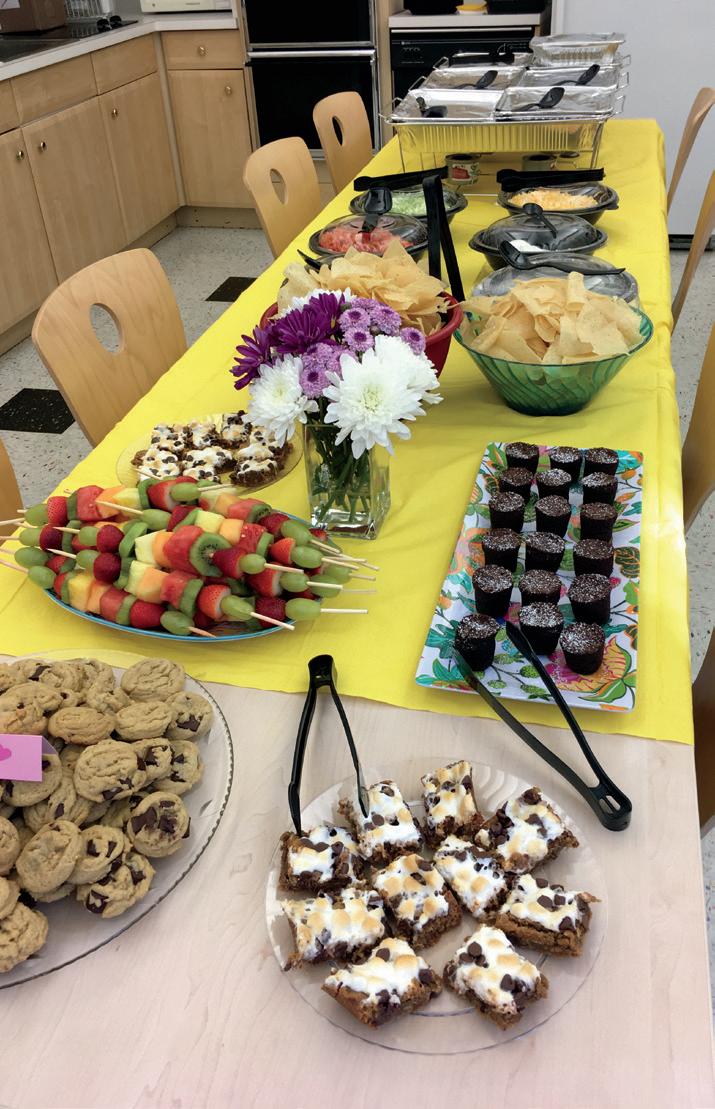
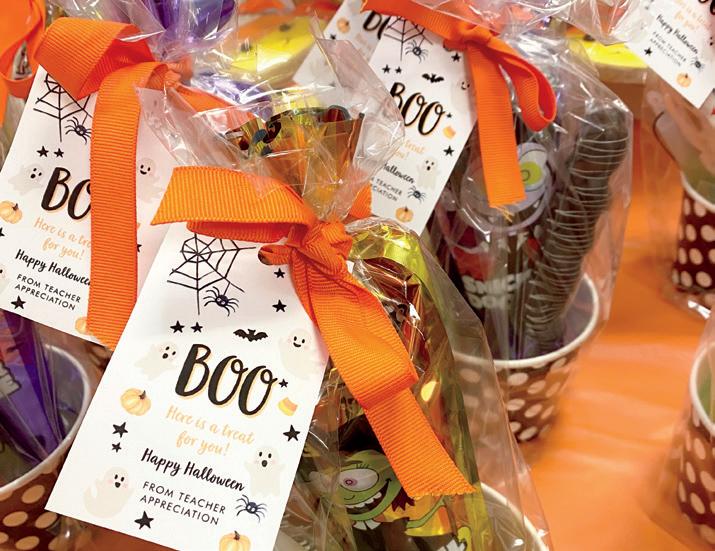
Thank You to the Athletic Council
A huge thank you to the over 70 volunteers and staff members who made Homecoming 2022 possible. Thank you to Athletic Council Programs Coordinator Bob Smith for his leadership and dedication. And we are grateful to our Athletic Council Co-Chairs: Stacy Ackley, Betty Fisher Wiggins ’93, Alison Fitzgerald, Susan Fortier, Deborah Greenberg, Ellen Knight, Jennifer Larsen and Peter Vanden Heuvel who worked tirelessly to make Homecoming a fun-filled weekend for all.
Betty Fisher Wiggins ’93 and Jennifer Larsen
Mary Fielder, Brian Frederick and Tom Flemma
Faculty Appreciation Committee efforts
Structured Word Inquiry
Lower School Reading Specialist Sharon Lieberman first heard about Structured Word Inquiry at a dyslexia conference she attended in 2019. She had been looking for ways to help students with their spelling and thought this might be just the thing.


Structured Word Inquiry, or SWI, is a pedagogical technique involving the scientific investigation of the spelling of words. Students start by exploring a word: What does it mean and how do you use it in a sentence? Next, they look at the structure of the word: What is the base, prefix and suffix? Then they look at the root of the word, using tools like the Online Etymology Dictionary, where they learn the history of the word—where it came from and how it was brought into our language. Then they look at relatives of the word and how the pronunciations can change.
Take the word heal, for example. You start with the base, H-E-A-L, pronounced with a long “E” sound. But then you add the suffix, -th, and it becomes “health.” Students have learned how E-A can sometimes have a long “E” sound like in “heal,” “tea” and “seat.” But other times it can sound like “eh” like in “health” and “bread.”

“They look at the meaning,” Sharon explains. “When you’re hurt you need to heal, and then once you’re all healed, you’re in good health. So even though the pronunciation changes, the meaning stays the same. In English, so much of our spelling is based on meaning.”
While SWI can be particularly helpful for students with learning differences like dyslexia (because it gives meaning to what used to feel like a jumble of random symbols) it is a useful tool for all students. This type of word study not only helps with spelling, but also with vocabulary.
“It’s so fun when you start digging into the etymology,” Sharon said. She shared about some fifth graders who discovered the English word “valetudinarian” when they were researching the Latin word “valere,” which means “to be strong, influential, healthy, of worth.” The students went up to the board and figured out how to break it down. “I asked, ‘What does this have to do with strength, influence, worthiness or health?’ And they explained, ‘It’s somebody who’s constantly worried about what’s wrong with them, why they’re not healthy.’”
NSCD piloted SWI during the 20212022 school year in SK, first, third and fifth grades. After only a year of implementation, teachers noticed that students’
vocabulary scores on assessments and standardized tests were the strongest they’d ever seen. This year, second and fourth grades were added into the mix.
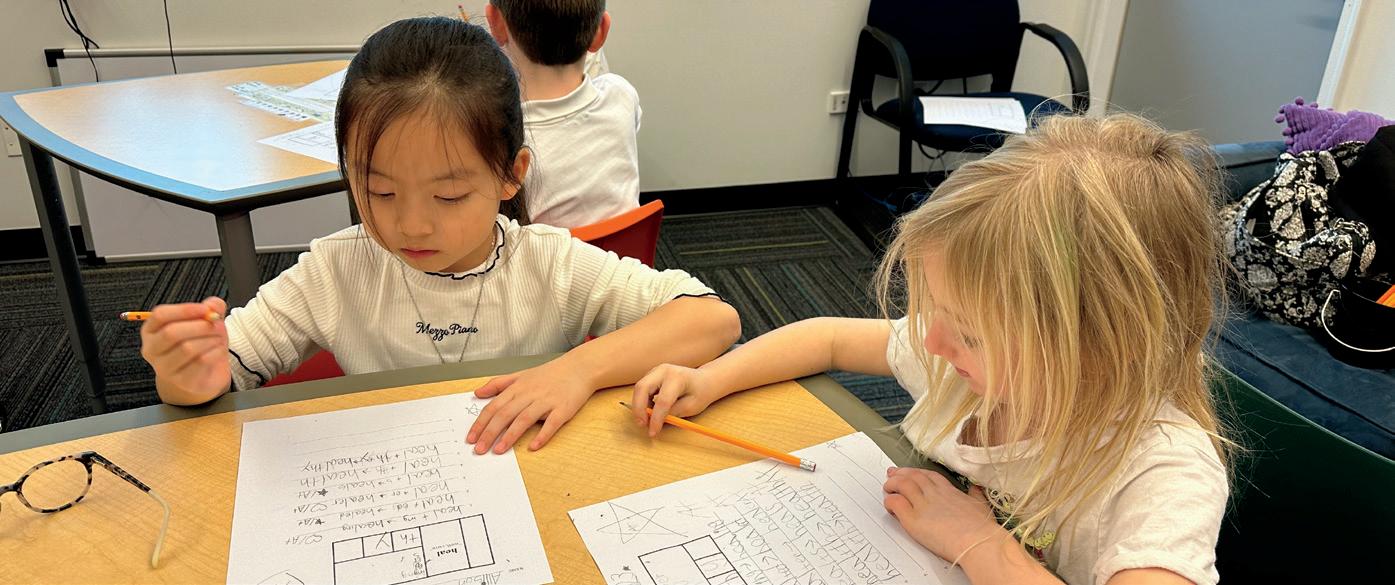
During these first few years, lower school teachers have been receiving ongoing professional development on how to implement SWI in their classrooms through an outside company. Once or twice a month, consultants from Language Insights spend the entire day in the lower school. Sometimes they model lessons, other times they observe and debrief. They move around to various classrooms throughout the day and then meet with the lower school faculty who are in their first year of SWI training after school for additional instruction. Eventually, SWI training for new faculty will move in-house.
“From the high-level professional development and support the faculty has received to the immediate impact in the classroom, this curricular initiative could not have been implemented better,” remarked Head of Lower School Tim Sheehan. “We are so fortunate to have such an amazing faculty who are always interested in new and better ways of teaching, and to be able to partner with Sharon Lieberman and her outside team of SWI teachers.”
14 academics
Pippa Nyamweya and Ahni Johnson ’34
Allison Jiang ’34 and Kit Collins ’34
Sharon Lieberman
SWI in action
Eighth Grade History: Chicago In the World
The eighth grade social studies curriculum got a complete makeover this year, with a brand new course: Chicago In the World. This yearlong class is intended to serve as a capstone experience, building on the foundations of sixth and seventh grade humanities.
Sixth grade humanities focuses on themes in global history, while seventh grade focuses on themes in American history, explained Middle School Social Studies Teacher Kirk Greer. “The purpose of Chicago In the World is to build on both of these foundations and show how Chicago’s founding and growth were deeply connected to world history as well,” he said. “We’re reintroducing Chicago as truly a global city.”
Eighth grade is really the first time middle school students experience separate English and history classes, taught by separate teachers. In sixth and seventh grade, students take two blocks of humanities taught by the same teacher. “To prepare for the expectations of high school and some of the more specific or advanced skills that are particular to each of the two disciplines, it makes sense to have two teachers specializing in those skills to make sure the transition to ninth grade and beyond is as smooth as possible,” Kirk explained.
Kirk has been working closely with Upper School Social Studies Teacher and
Department Head Kiernan Aiston, who currently teaches all of the sections of ninth grade history. They’ll be working over the coming year on scaffolding the skills and creating a seamless transition between eighth and ninth grade history.
The ultimate goal is to create a comprehensive interdisciplinary course for the students. “And that’s what we’re on the precipice of doing,” Kirk said. “I tried to lay the foundation for the history component, and then starting this summer I’ll be collaborating with the eighth grade English teacher to create an eighth grade humanities curriculum based on Chicago’s history, arts and literature.”
Kirk, who is new to NSCD this year, said one of things he appreciates most about the school is the freedom and support he has to develop really creative, innovative, performative assessments for his students.
The first unit in the course examined the global forces that led to the founding of Chicago. At the conclusion of the unit, students worked in the Live+Serve Lab to develop their own work of public art to commemorate Jean Baptiste Point du Sable and his Potawatomi partner Kitihawa.
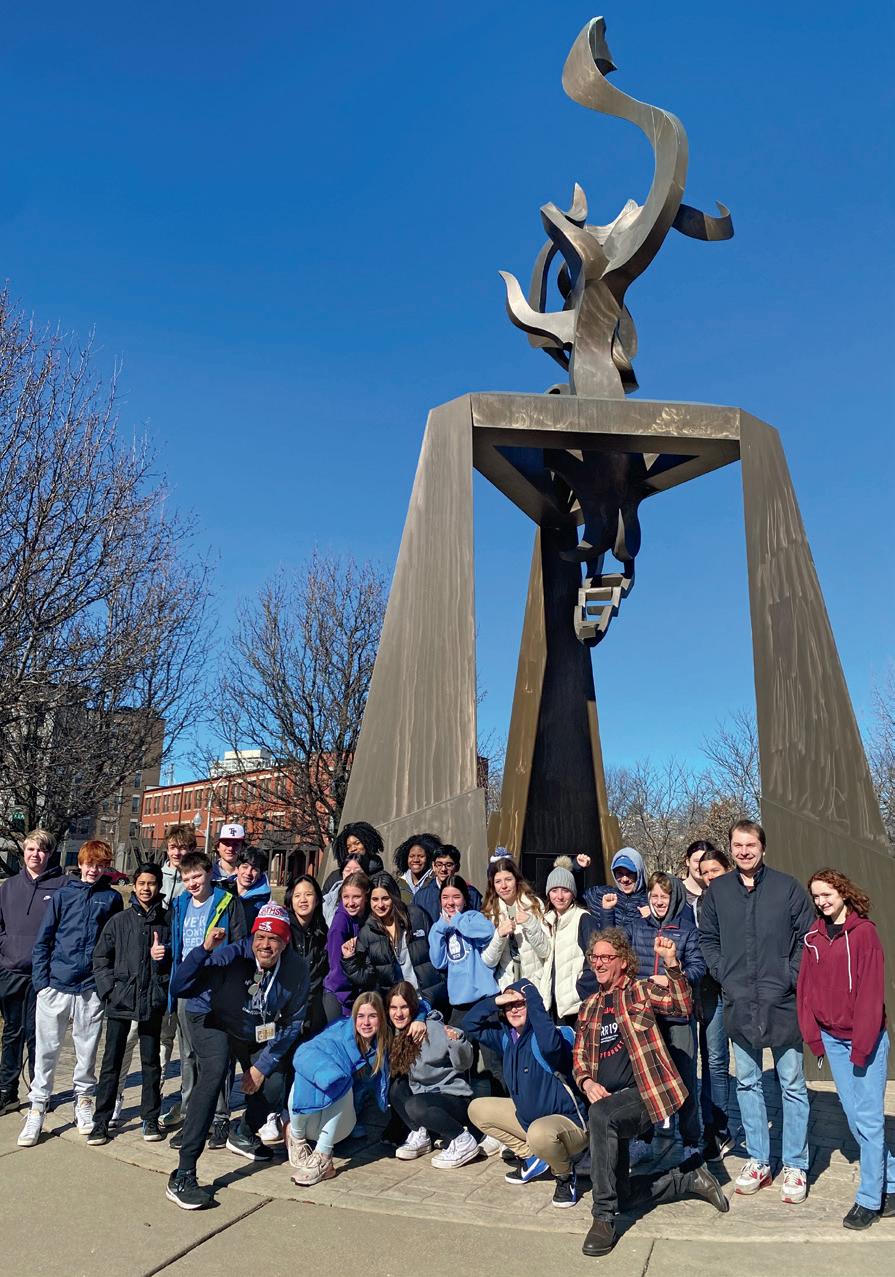

For their unit on industrialization and labor conflict, students took on the roles of prosecutors, defense attorneys, defendants, witnesses, judge and jury, and participated in a simulation of the infamous 1887 Haymarket Trial.
Another unit explored the local and global causes for Chicago’s racial violence and resistance during the summer of 1919. Under the guidance of Peter Cole of Western Illinois University and Franklin Cosey-Gay of the University of Chicago, two professors who are leading the city’s efforts to remember 1919, students spent a Saturday touring some of the neighborhoods in Chicago where these tragic events occurred. Later, students will have a chance to create and perform poetry, short stories or a work of art to honor the victims. They’ll also examine the city’s official report, published in 1922, and analyze the progress over the past century.
“When the students had a chance to go into Bronzeville and Bridgeport to see the actual city blocks we’ve been studying where all these significant historical events happened, it really locked in their understanding of the unit and made it come alive,” Kirk explained. “As this curriculum builds and unfolds over the next few years, I’m hoping we will be able to travel into the city each and every unit so the students can benefit from that firsthand, sensory learning. It really gets the students to understand Chicago in a much different way—deeply connected to where we live on the North Shore, but also deeply connected to world history.”
acorn · Winter 2023 15
Ida B. Wells National Monument in Bronzeville
Laina Rai ’27, Lauren A’Hearn ’27 and Jack Ford ’27
FIRST LEGO League
When Charlotte Graham ’25 came to North Shore Country Day as a freshman, she was surprised to learn the school did not have a FIRST LEGO League program established in the lower or middle schools. FIRST LEGO League is a global program that introduces science, technology, engineering and math to students through hands-on learning and robotics. Charlotte had participated in the program at her previous school from third to seventh grade, and it had a tremendous impact on her. So she asked upper school administrators what it would take to start the program here.
“I learned an extraordinary amount about not only coding and robotics but also teamwork, problem solving and public speaking,” Charlotte said. “I kept thinking how it would be a perfect fit for our lower and middle school students. I wanted our students to have the same opportunity I did to be immersed into the wonderful world of FIRST LEGO League to grow in their many skills.”
Upper school administrators connected Charlotte with Lower School STEAM Integrator Julie Tuten, who had always wanted to start a FIRST LEGO League
program. Together, they piloted the program with a team last spring. This fall, they fielded two teams: the Robo Raiders, made up of mostly fifth and sixth graders with a few fourth graders, and the Raider Gators, a team of all fourth and fifth graders.
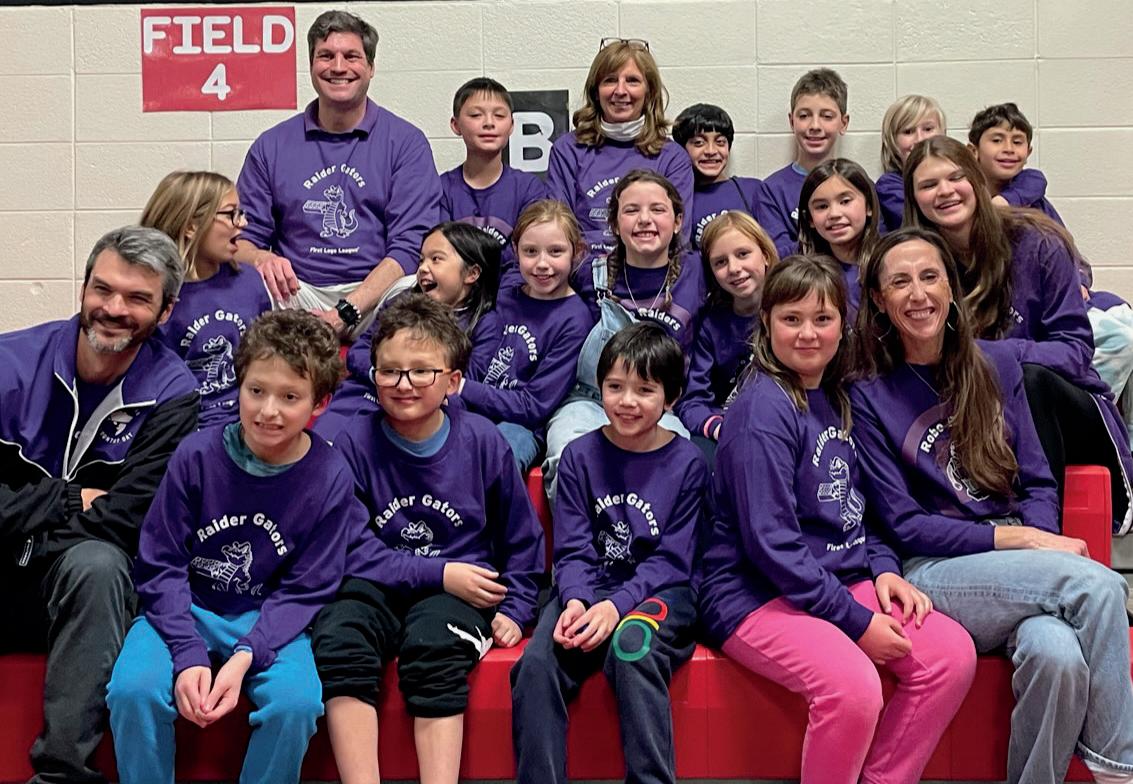
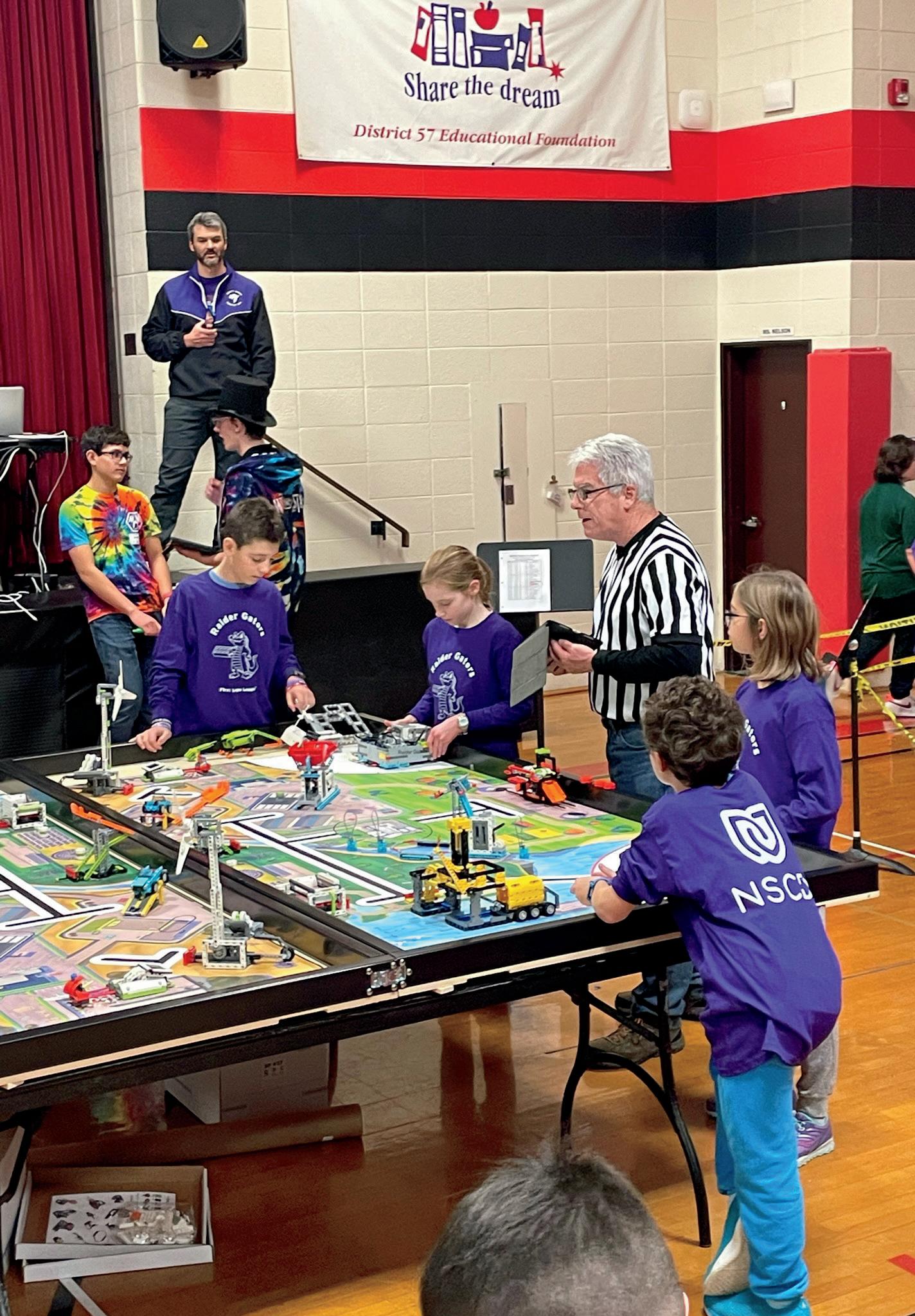
The teams committed to weekly practices before school from 7 to 8 a.m. to prepare for their first competition in December, as well as some extra practices leading up to the big day. Throughout the season they also had to complete an innovation project based on this year’s theme “Superpowered,” which was all about sustainable energy. The Robo Raiders worked with Lower School Science Teacher Annie Collins to design and build a humidifier for the school’s greenhouse. The Raider Gators, inspired by a book in social studies about the global water shortage, researched how much water is used in a typical home and designed a prototype for a plumbing system that used stored rainwater to reduce water usage.
On the day of the competition, they presented their projects and also had to build and code a robot to complete as many challenges as possible in two and a half minutes. After the first round, one of the
students broke down because he thought he had made a big mistake, but his teammates rallied around him and gave him a big pep talk, assuring him that it was OK to fail and to keep going.
“He came back in the second round and nailed it,” Julie said. “It was an amazing life experience of failure and perseverance—which is what we emphasize in and out of school. We fail all the time. We make mistakes all the time. AND it’s not only OK but it’s how we learn!”
Both teams did an incredible job demonstrating FIRST LEGO League’s core values of discovery, innovation, impact, inclusion, teamwork. The Robo Raiders brought home the “Core Values Award” and Charlotte was named the “Outstanding Coach/Mentor” out of the 36 teams who competed.
“I had never been so proud, watching how far these kids had come and how close they had grown as a team,” Charlotte said. “Whether it was sitting in the judging rooms watching (and trying my best to be silent), or coaching them during table runs, my heart filled with joy as their hard work paid off. I was so honored to be able to work with such an amazing group of kids.”

16 academics
The Raider Gators
FIRST LEGO League
Upper School Interim Week
For the first time since 2019, upper school Interim Week was back at full capacity, complete with international and domestic travel opportunities, as well as a number of community engagement offerings.
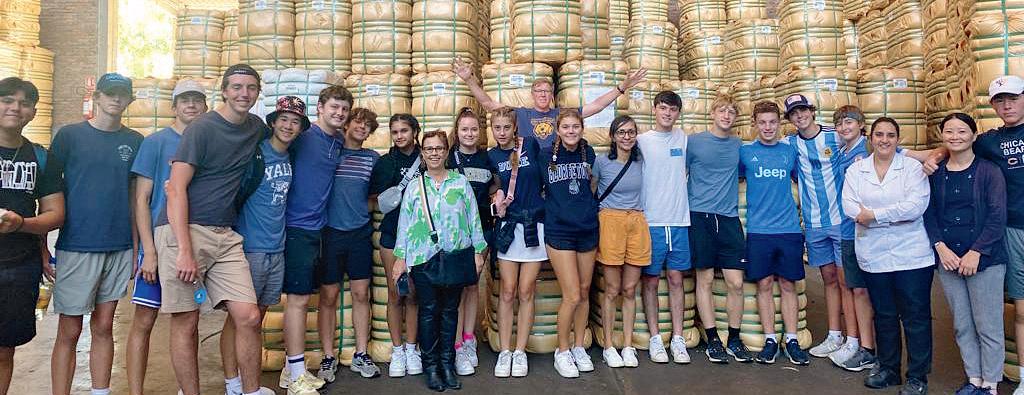
This year, students had the opportunity to choose one of four travel-based Interims: an exchange program living with a host family in St. Malo, France; a language immersion trip to Uruguay with a focus on alternative energy and sustainability; an unplugged road trip up the coast of California; or a week of Broadway shows in New York City.
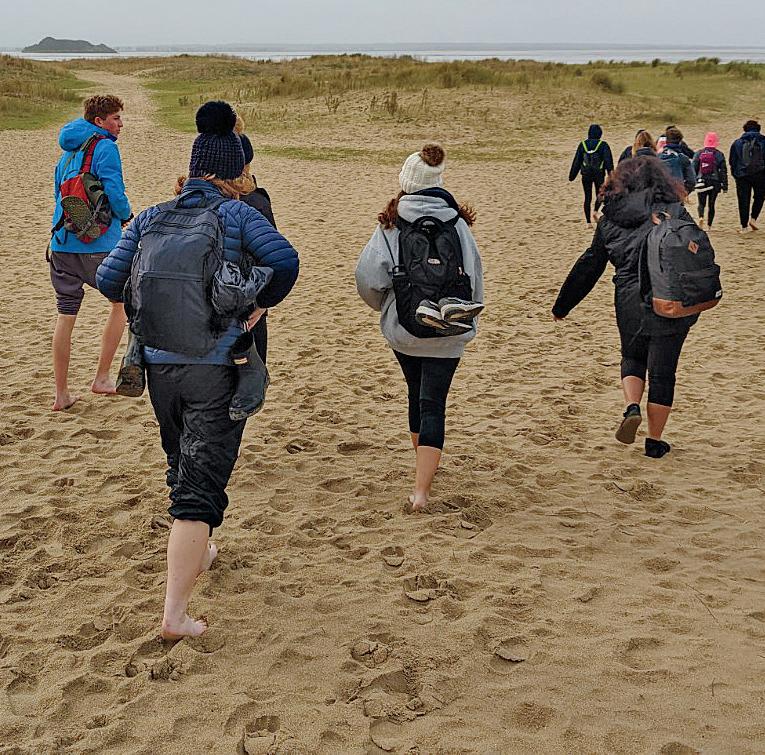
Students who wanted to stay closer to home could choose from a selection of 13 local experiences. A few students also completed internships during this time. Highlights included rock band lessons at School of Rock, learning how to make paper by hand, glassblowing and firework, and a number of opportunities to explore different Chicago neighborhoods through food, art and culture.
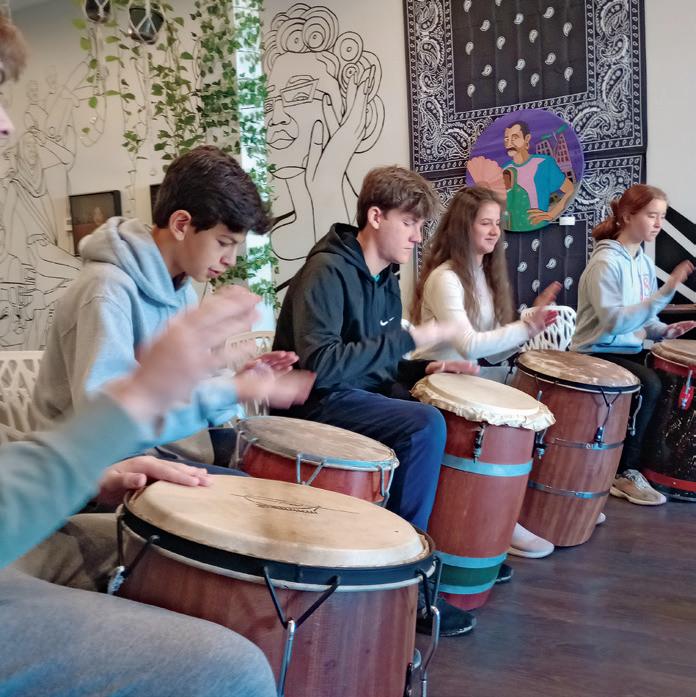
Avery Erwin ’24 spent the week at Firebird Community Arts, which strives to empower and connect people through the healing practice of glassblowing and ceramics. “I was super excited when I found out I was placed in this Interim because I had never done anything like this before,” she said. “At first I didn’t understand how glassblowing and flamework could be used as therapy or as a calming activity, but after my time there I realized it’s very true. The shaping of the glass and glow of the fire had a relaxing effect on me while I did it. Overall, I really enjoyed my time there and wish I could have stayed longer!”
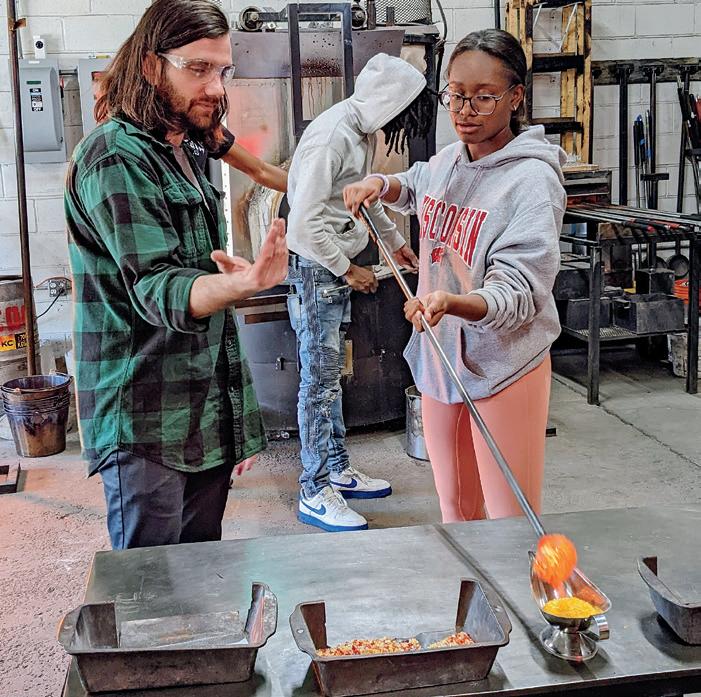
At least once in four years, students are required to participate in a Community Engagement Interim, projects that connect students to an outside community that is different from NSCD in at least one significant way, by virtue of location, identity of participants, community composition or some other factor. At the conclusion of Interim, students are able to consider how the experience impacted or challenged their thinking, their feelings, their sense
of self and their values. This year, eight of the 13 local options were Community Engagement Interims.
Since 1976, Interim Week has provided transformational experiential learning for NSCD students. It’s a unique opportunity to explore new ideas, concepts and activities students would not be able to encounter independently or in a typical classroom environment, and it’s a crucial component to the North Shore upper school experience.
Faculty and administrators work hard to create Interim offerings that reflect the origin of the word “educate”—to lead out into the world at large—taking advantage of the many resources available. Students engage with and reflect on new ways of approaching relationships, communities and society. Ideally, the Interim experience challenges students to extend beyond their existing comfort zone.
To learn more about this year’s Interim experience, visit bit.ly/Interim-2022.
acorn · Winter 2023 17
Bites, Rhythm and Art
Exchange program in St. Malo, France
Glassblowing at Firebird Community Arts
Language immersion trip to Uruguay
Jonathan Strong ’62 Receives Stanton Recognition
Author and educator Jonathan Strong ’62 received the 41st annual Francis R. Stanton ’27 Recognition on Saturday of Homecoming Weekend.
Growing up, Jonathan described NSCD as “almost a mythical” place. Both his parents attended the school, and he recalled flipping through old yearbooks and seeing pictures of his parents and their friends as teenagers. One of his earliest memories on campus was when his parents brought him to see the Gilbert and Sullivan operetta “Patience” when he was in first grade—his first ever theatrical event. He officially became a Raider in sixth grade.
As he accepted the honor, Jonathan reflected on his experiences at North Shore Country Day and shared about some of the teachers who made an impact on him.
He talked about his eighth grade English teacher, Mrs. Joy Humes, who required a free composition every week. “I think it was my first experience being able to write whatever I wanted to write, and have someone look at it and comment on it and take it seriously,” he said.
He recalled how his French teacher, Madame Simone Valvo, and his German teacher, Dr. Karla Landau, had a way of stretching him and not settling for “just OK.”
He told a story about a piece he wrote and published in the school newspaper. He was so proud of it, but Dr. Landau called him out.
“It wasn’t my voice—it wasn’t me. I was trying to be something else. And that
lesson stuck,” he explained. “The idea of helping students find their voice became my mission as a teacher. It’s not just their identity, it’s the territory they’re familiar with, the words that come naturally, the phrasing that comes naturally. And that started here.”
Jonathan spent the day before the presentation meeting with middle and upper school students, faculty and staff. On Saturday, former classmate Tom Geraghty ’62 presented Jonathan with the official citation.
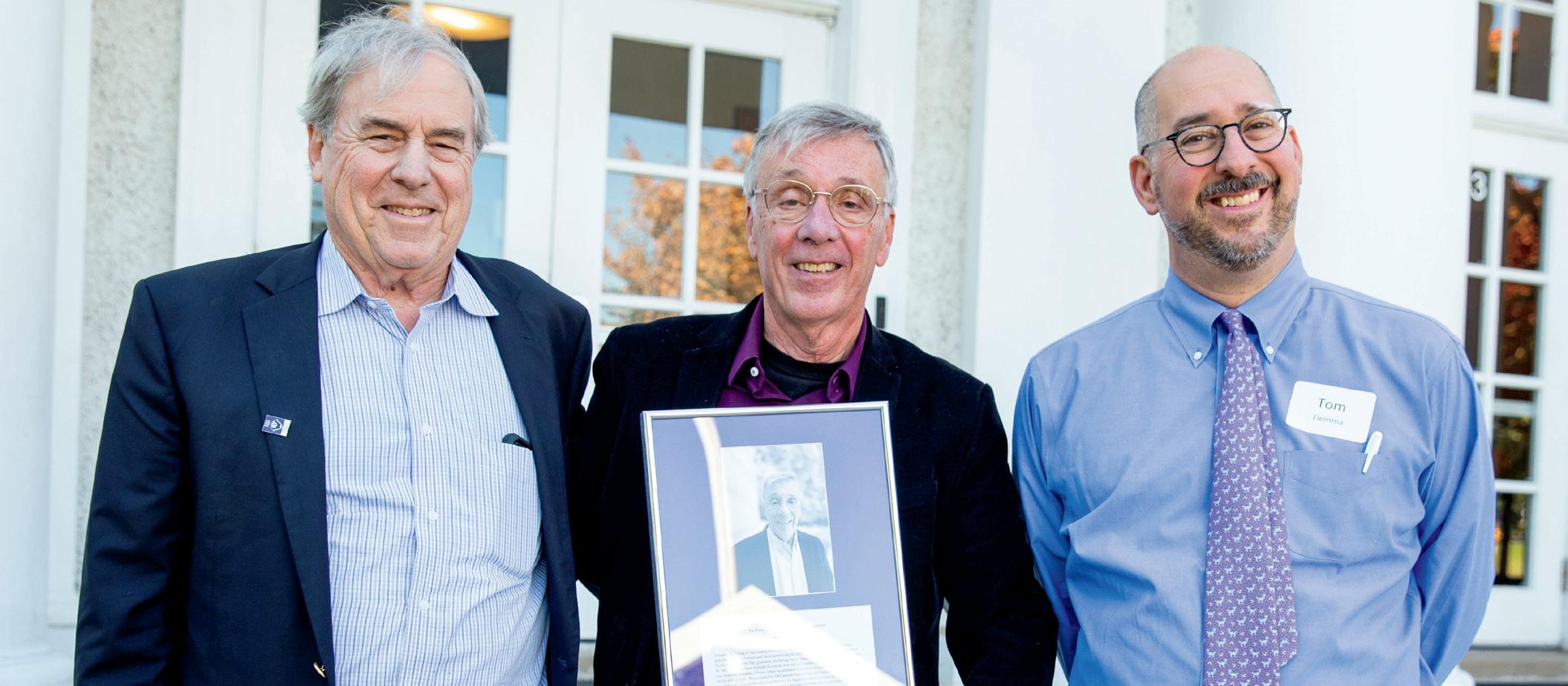
CITATION
Jonathan W. Strong Jr. has made a tremendous impact as a well respected fiction writer and published author of novels and short stories over the past 50 years. Coming from a long line of North Shore Country Day graduates, the Strong legacy began with Jonathan’s parents, Jonathan W. Strong Sr. and Anne Malinda Burnham, who met as members of the Class of 1934. Jonathan was raised in Winnetka, Illinois, where he attended North Shore Country Day, as did his aunts, uncles and cousins. He graduated in 1962 and enrolled at Harvard University where his writing career began. After graduating from Harvard, he began his career teaching fiction writing at Tufts University, where he remains a longtime lecturer. Jonathan also taught at Harvard College, Wellesley College and University of Massachusetts.
By the time Jonathan was 25, he had graduated from Harvard, won a grant from the National Endowment for the Arts, had twice won O. Henry Awards for his short
fiction stories, “Supperburger” and “Patients,” and won the Rosenthal Award from the National Institute of Arts and Letters for his first novel, “Tike and Five Stories.” Jonathan’s first short story, “Supperburger,” has since been anthologized and according to literary critic James Morrison, it has become a “classic in gay fiction.” Jonathan then went on to write and publish over the next four decades and is the author of 17 novels.
In addition to writing, Jonathan has an abiding interest in 19th century opera and has written four adaptations of Gilbert and Sullivan works performed in New England. Most notably, Jonathan conducted several alumni in the summer of 1963 in a production of Gilbert and Sullivan’s last opera, “The Grand Duke.” The performance filled 300 seats at the Winnetka Women’s Club, and Mac McCarty said, “it was the best opera ever!”
In 1998, Jonathan was Writer in Residence at Northwestern University, another distinct honor. For the occasion he wrote an essay entitled, “Home Turf, Where a Writer Feels Familiar.” The essay was written on his manual typewriter and beautifully describes how unexpected events in life can bring us together.
His impressive career, deep commitment to the literary community, and his dedication and advocacy in his writing with equity and inclusion exemplifies the school motto of “Live and Serve.” North Shore Country Day proudly presents the 2022 Francis R. Stanton ’27 Alumni Recognition to Jonathan W. Strong Jr. ’62.
18 distinguished guests
Tom Geraghty ’62, Jonathan Strong ’62 and Tom Flemma
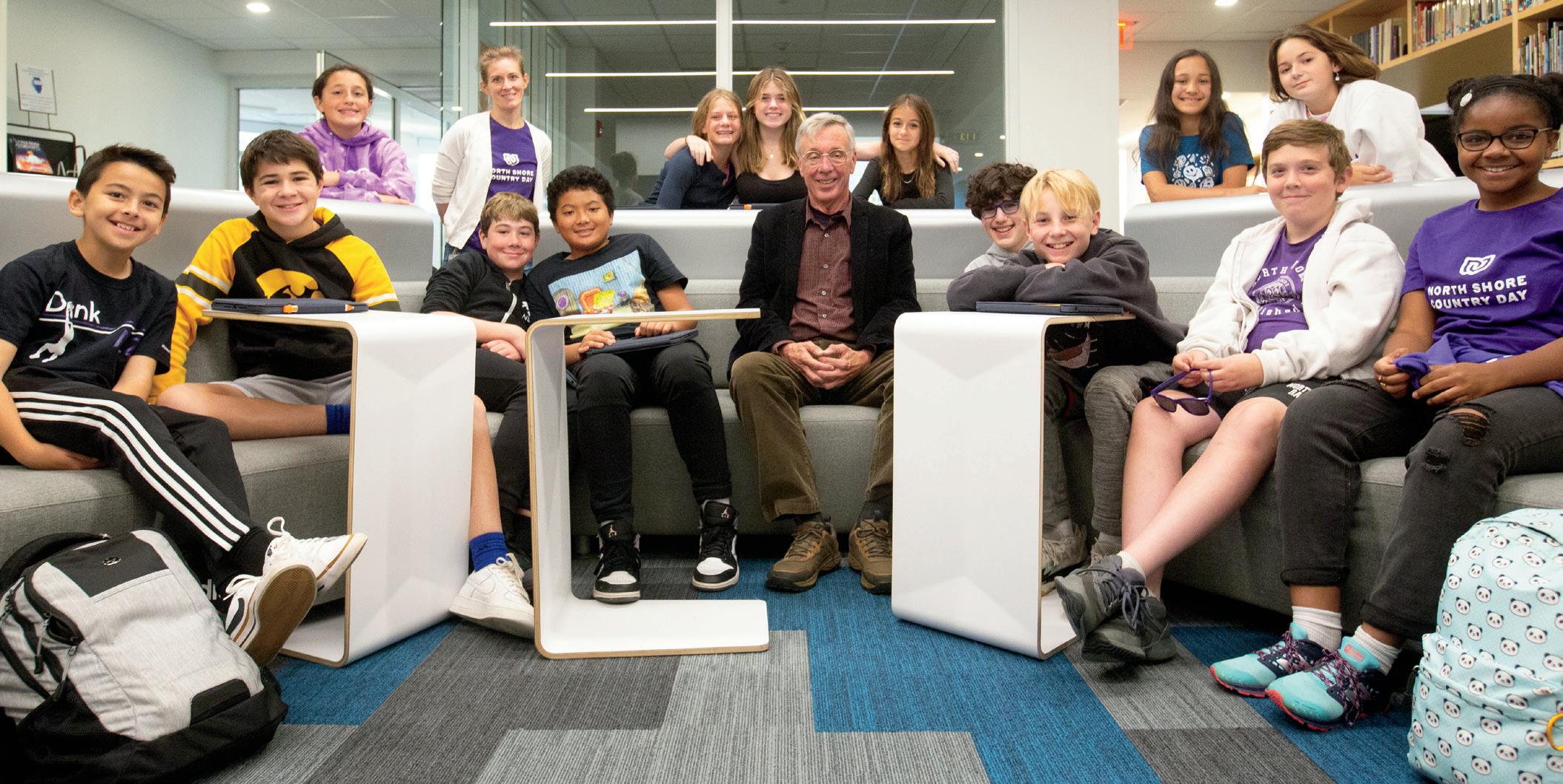
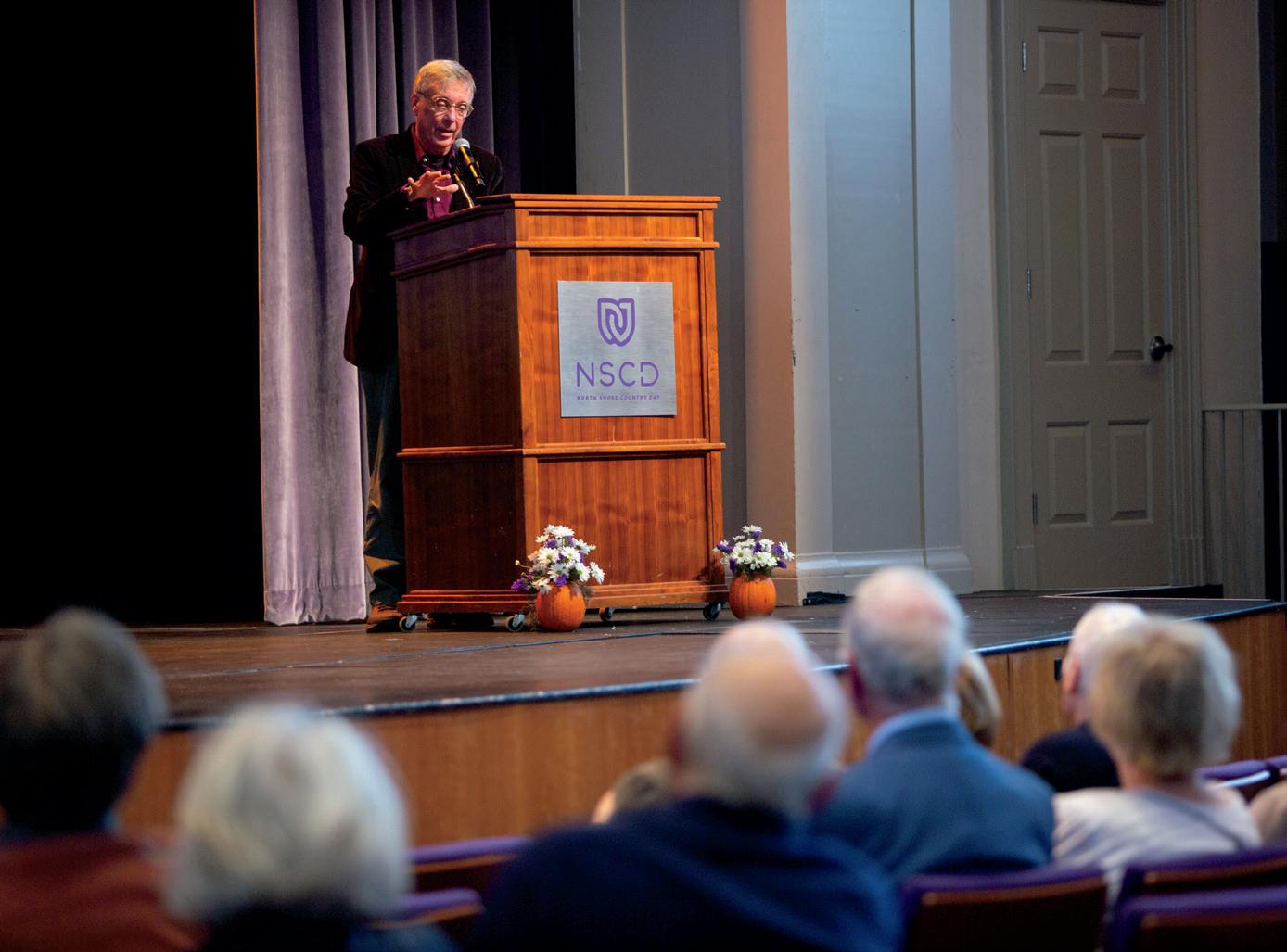
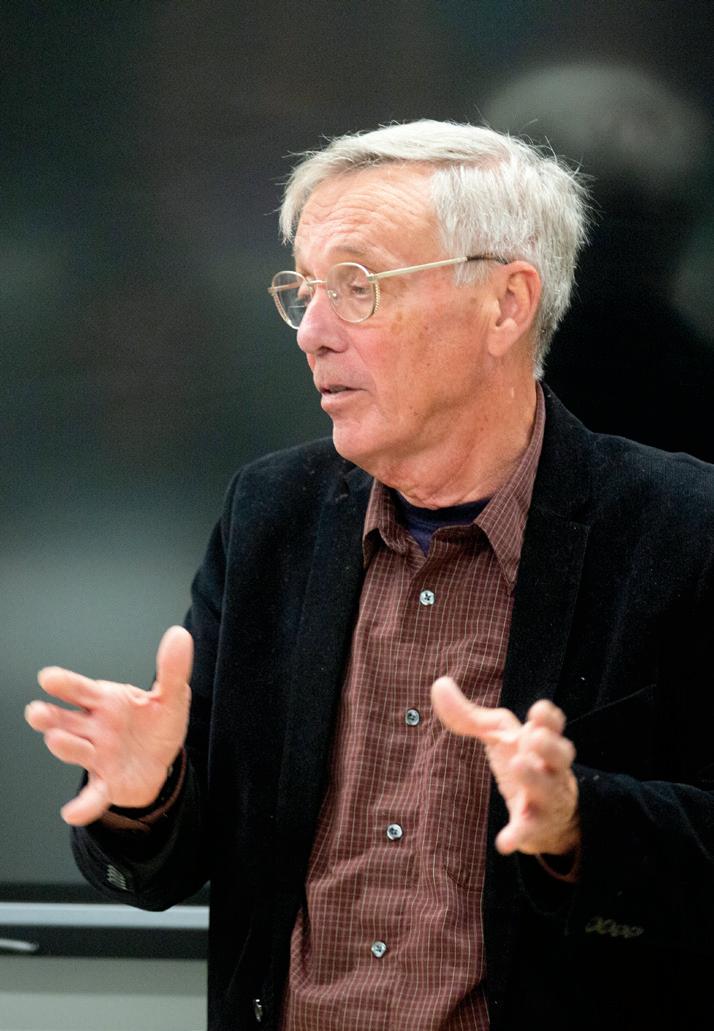
 Jonathan Strong ’62
Joel de la Fuente ’87, Susie Brew Schreiber ’58, Tom Geraghty ’62 and Jonathan Strong ’62
Jonathan Strong ’62 with seventh grade humanities students
Jonathan Strong ’62
Joel de la Fuente ’87, Susie Brew Schreiber ’58, Tom Geraghty ’62 and Jonathan Strong ’62
Jonathan Strong ’62 with seventh grade humanities students
North Shore Country Day welcomed Dr. Anton Treuer (pronounced Troy-er) as the 2022 Harold Hines Visiting Fellow on November 30. Anton is a prolific author and Professor of Ojibwe at Bemidji State University in northern Minnesota.
During his time on campus, Anton gave a Morning Ex presentation about how Native Americans changed the world. He also met with several classes and small groups of students in all three divisions.
In lower school, Anton spent time with both fourth and fifth graders, in conversation with students about language, the Native experience in the United States and his own journey to academia. He also connected with seventh grade humanities classes, and upper school Mandarin, Spanish and history classes, where he shared his perspective on language, history and culture. Anton then ended his day with a powerful presentation to faculty around the incorporation of Native voices and narratives in classroom curriculum.

This year, the Hines Fellowship also aligns with NSCD’s Franke Fund project, which aims to center Native voices and provide a way for NSCD students and the schoolwide community to engage with and learn from members of Chicago’s robust Native community.
Anton has dedicated more than 30 years of his life to Ojibwe preservation and is currently working on two projects to
continue that work. He is co-editing a set of five illustrated children’s books in a partnership between the Mille Lacs Band of Ojibwe and the Minnesota Historical Society, and he is working with the Mille Lacs Band and Rosetta Stone’s Endangered Languages Program to produce a series of lessons that will “conserve the tribe’s authentic dialect and heritage.”
Anton, who holds a B.A. from Princeton University and a M.A. and Ph.D. from the University of Minnesota, has published 19 books including “Everything You Wanted to Know About Indians But Were Afraid to Ask,” “The Language Warrior’s Manifesto: How to Keep Our Languages Alive No Matter the Odds,” and “Warrior Nation: A History of the Red Lake Ojibwe” (winner of Caroline Bancroft History Prize and the American Association of State and Local History Award of Merit).
He has sat on many organizational boards including the United Nations Technical Working Group on Sustainable Development Goals through Inclusive, Just Energy Solutions and the governing board for the Minnesota State Historical Society and has received more than 40 prestigious awards and fellowships. In 2018, he was named Guardian of Culture and Lifeways and recipient of the Pathfinder Award by the Association of Tribal Archives, Libraries and Museums. His equity, education and cultural work has put him on a path of service around the nation and the world.
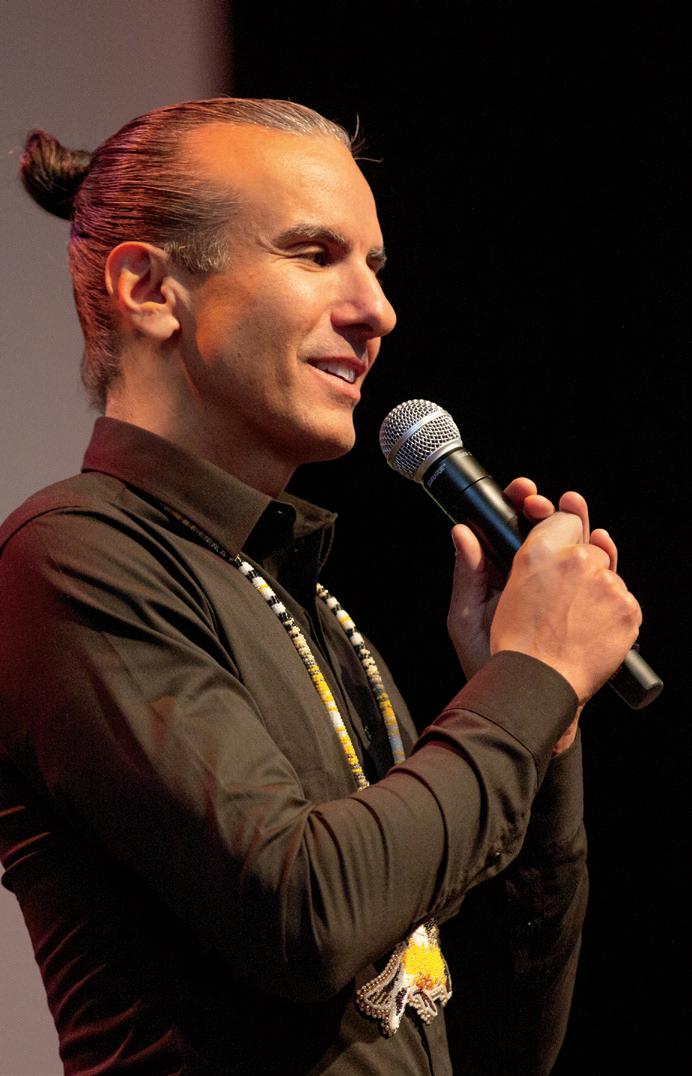
The Harold Hines Visiting Fellowship was established in 1986 in memory of longtime trustee Harold H. Hines Jr. Hines provided exceptional leadership to North Shore as a trustee, having chaired numerous Board committees, including the Long Range Planning Committee and the 50th Anniversary Endowment Fund Campaign, as well as serving as Board Chair from 1971-1973. In addition, his three children graduated from North Shore as “Lifers” and his wife, the late Mary Pick Hines ’49, was a distinguished alumna of the school and served as a member of the Alumni Board, Benefit Board and Board of Trustees.
The Fellowship has brought distinguished individuals to NSCD who have exemplified the school motto, “Live and Serve.” There’s a special emphasis on the ethical consideration of societal issues, giving students the opportunity to define their responsibility to society. Past Harold Hines Visiting Fellows include former president of Yale University and Commissioner of Major League Baseball, the late A. Bartlett Giamatti; Dr. Jane Goodall; Chinese dissident, the late Harry Wu; founder and president of Habitat for Humanity, the late Millard Fuller; awardwinning poet, essayist, fiction writer, activist and professor Marjorie Agosin; and Georgia Congressman and civil rights icon, the late John Lewis with Andrew Aydin, co-author of the award-winning graphic-novel series March.
20 distinguished guests
Dr. Anton Treuer
Dr. Anton Treuer: 2022 Harold Hines Visiting Fellow
Twenty years ago, Lower School Music Teacher Linda Kiracibasi heard a song called “Give Us Hope,” and she knew she had to teach it to her students. She loved it so much that she emailed the composer and asked him to come to campus and do a songwriting workshop with the Lower School Chorus. Two decades later, that partnership is still going strong.
The composer of that song was Jim Papoulis, and he has come to North Shore Country Day 10 times over the past two decades for a weeklong songwriting residency with the Lower School Chorus. An NSCD grandparent generously donated funds to make that first workshop possible. And that first song they wrote together, “There is Peace,” has been published and performed by choral groups across the world.
“So many people have had the opportunity to sing the notes that these North Shore children wrote,” he said. “And it’s such a beautiful message—‘There’s peace in my heart.’ I just love that.”
Jim, who is based in New York City, composes, orchestrates and conducts music for dance, film, ensembles and choirs all over the world. He’s been to 71 countries and works with all kinds of youth—from professional choirs like the London Boys Choir to children in rural Africa to incarcerated teens. No matter who he is working with on a given day, he always starts his workshops off the same
way: with a blank piece of music paper. “I tell them, ‘The song we’re going to write, I have right here,’ and I open up my notebook,” he said. “The bottom line is that I have no idea what kind of a song it’s going to be. It’s a blank slate.”
names
He spends the first part of the workshop getting to know the children. He asks them about what kind of music they like, what they don’t like and what makes them really love a song. “The most important part about songwriting, especially with children, is to make them feel safe and accepted and listened to,” he explained.
Then questions shift and begin to go deeper. He starts asking what they might want to sing about? What do they think is important for the adults to hear from them, from their perspective? What do they think makes a good person? If they could improve the world in some way, what might it be?
During this visit, Jim worked with the Lower School Chorus to write the song, “Every Day Is a Chance,” about the many opportunities people in the world have to try to be a better person. “We all have a chance every day to make a difference in someone’s lives, to be accepting, to understand our voice, to believe in ourselves and then share it with others, to listen to others,” Jim explained. “It’s about the importance of being a kind person who is aware of others. A lot of times when we get caught up in the world, we
forget about that. But every moment is a chance to do that.”
Once they hashed out the lyrics, they worked on the flow and the melody. Eventually they even incorporated some harmonies, and before they knew it, they had written a song. On the fourth day, the students took a field trip to a recording studio in Chicago and spent the morning recording the vocal tracks.
The students premiered their new song at a community concert in the arts center, including the Singing Raiders, Lower School Chorus, Middle School Chorus and Upper School Chorus—the first crossdivisional in-person choral performance since December 2019.
“What I most appreciate about Jim Papoulis is his faith in third, fourth and fifth graders to dream, believe and create beautiful and thoughtful music that they sing from their hearts,” Linda said. “We learn several of Jim’s pieces before each residency that the chorus sings in the final concert, and sometimes those pieces are quite poignant and serious. One of the chorus’s favorite songs (and mine), ‘I Ask For One Day,’ has lyrics written by a young girl who lost her older brother in a military conflict. She asks for ‘one day where I don’t have to think about pain.’ Jim wrote a beautiful melody, and the children communicate the emotion in the song with great care and artistry. Young artists are capable of amazing things!”
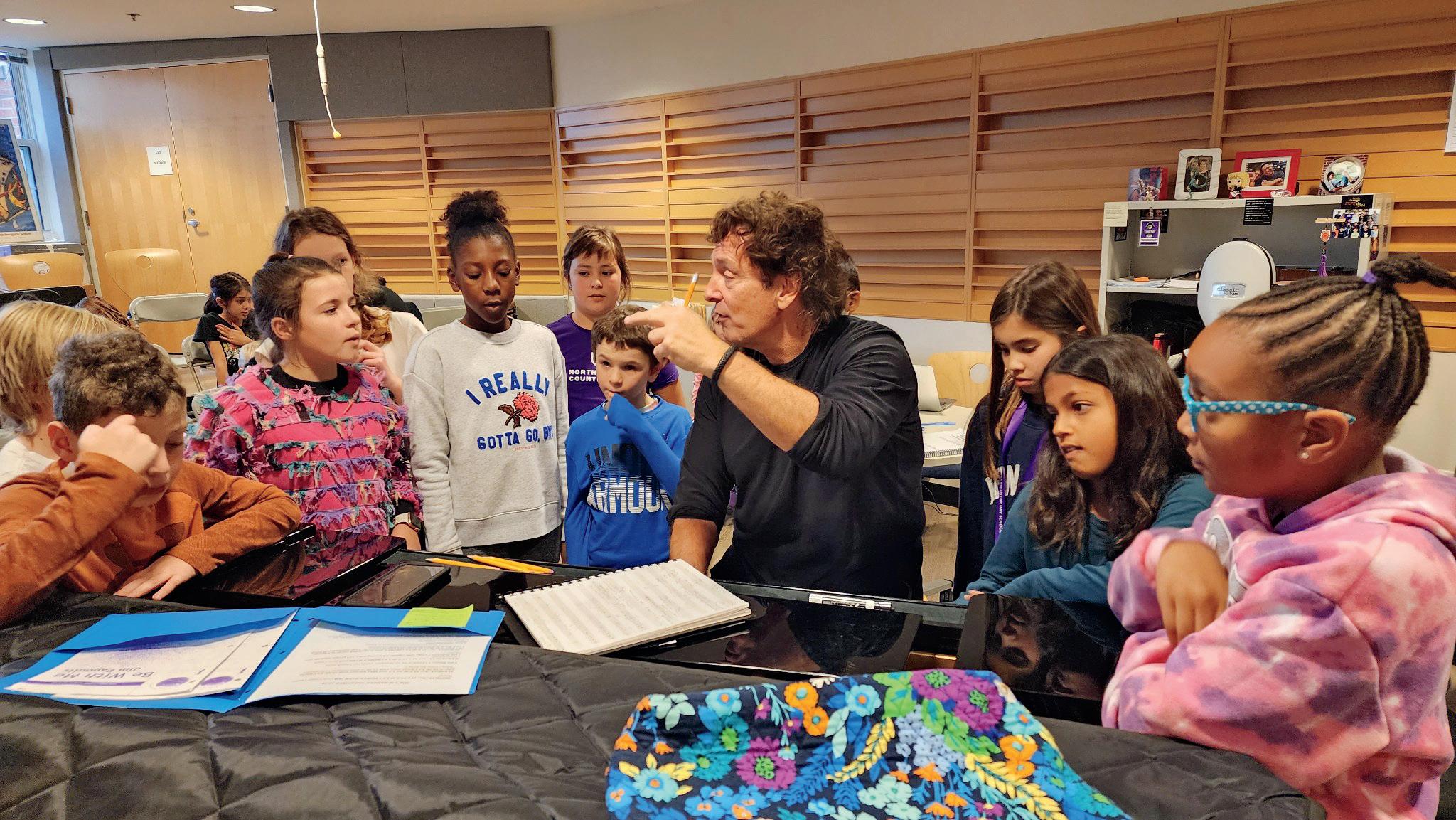
acorn · Winter 2023 21
Jim Papoulis with the Lower School Chorus
Jim Papoulis: Artist in Residence
Homecoming
About 200 North Shore Country Day alumni and many more students, parents, faculty, staff, friends and neighbors returned to campus September 30 and October 1 for a packed Homecoming weekend. After several years of less-than-ideal weather, the blue skies, warm sunshine and moderate temperatures—as well as the return of some beloved traditions— made this year’s events feel extra festive.
Friday afternoon kicked off with a student pep rally, followed by a fun run open to the entire community. The Parents’ Association and the Athletic Council once again teamed up to put on a familyfriendly carnival, complete with inflatables, a temporary tattoo station, a free Kona Ice truck and a live DJ. Local restaurants Fat Shallot, Soul & Smoke and Rio Bamba Latin Kitchen also set up food trucks by the tennis courts.
Alumni from across the United States and Canada returned to campus with their


friends and families to reconnect with former classmates, faculty and staff. The oldest alumnus in attendance was Pete Henderson ’47, who was celebrating both his 75th reunion and 92nd birthday.

Various formal and informal reunion class dinners and gatherings were held off campus, and alumni and their guests were invited to a Friday evening reception with current and former faculty and staff on campus in the Hall Library.
On Saturday, alumni, parents of alumni and former faculty gathered in the auditorium for a program that included an update from Head of School Tom Flemma, a panel discussion with current students and the Francis R. Stanton ’27 presentation to author and educator Jonathan Strong ’62. (See story, page 18.) The Stanton recognition is given each year to an alum whose life work exemplifies the school’s motto, “Live and Serve.” The program also recognized members of the Jay Bach Iron Raiders Society—alumni who
participated in 12 consecutive seasons of athletics during upper school. It concluded with a special recognition of lower school music teacher Linda Gibson Kiracibasi, who will be retiring at the end of the school year after 45 years of service.
Throughout the weekend, guests also had the chance to view the latest exhibition in the John Almquist Gallery, “RE:Solving Permeated Perceptions.” As in past years, the Little Raiders field hockey clinic Saturday morning gave children aged 4 and up an opportunity to learn the basics of the game from NSCD players and coaches, and practice their shooting and passing.
NSCD varsity and junior varsity athletic teams celebrated on-campus victories throughout the weekend, winning four of their eight home games. The varsity field hockey team defeated Lake Forest Academy (3-0) and the varsity boys soccer team defeated Lisle Senior High School (2-0).
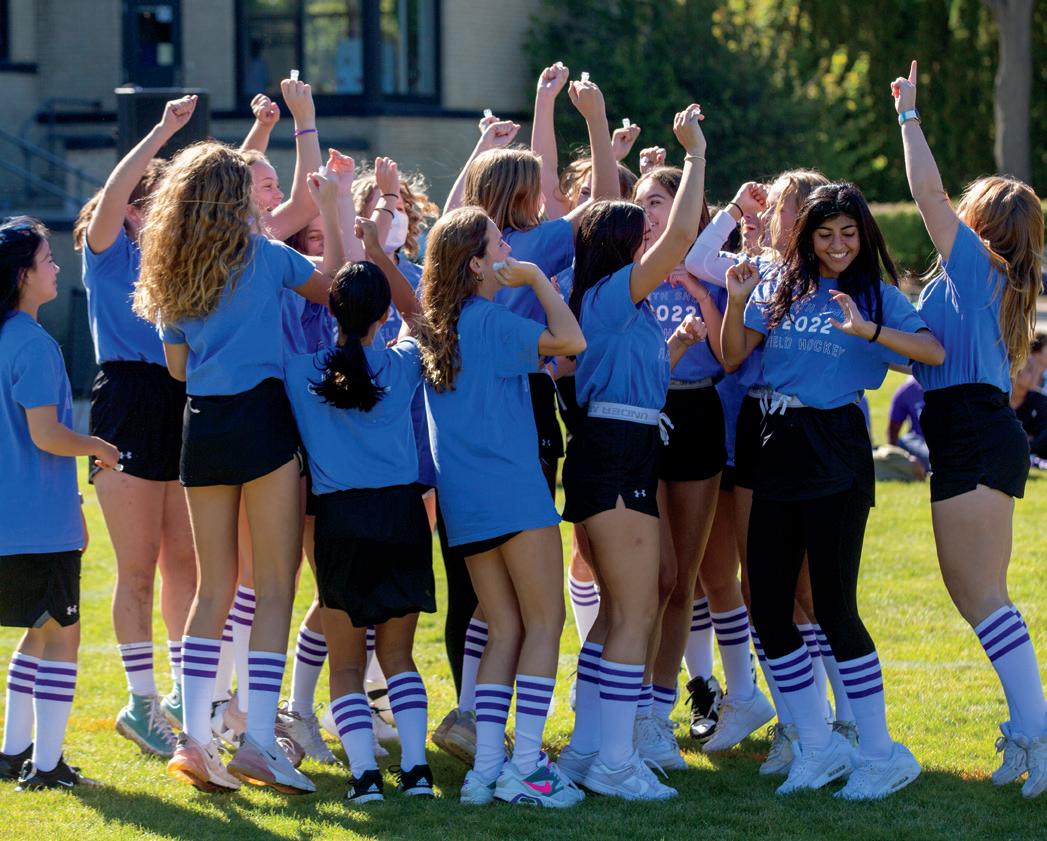

22 events
Homecoming Pep Rally Girls Field Hockey
Camryn Mundy ’32 and Veera Surakanti ’32
Samuel Rapoport ’26
Kit Collins ’34
In the Almquist Gallery



This year’s opening show in the John Almquist Gallery, entitled “RE:Solving Permeated Perceptions,” featured Native artists from around Chicago whose works examine topics such as identity politics, misrepresentation and Native first-voice experiences. The exhibition was curated by Dave Spencer, Director of Arts and Culture at the American Indian Center of Chicago, and was part of this year’s Franke Fund project, which aims to center Native voices and provide a way for NSCD students and the schoolwide community to engage with and learn from members of Chicago’s robust Native community.
The exhibition featured the work of Ernest M. Whiteman III, Northern Arapaho; Chris Pappan, Kaw, Osage and Cheyenne River Lakota; Kae Good Bear, Navajo, Mandan and Hidatsa; Noelle Garcia, Klamath and Paiute; Negwes White, Ojibwe and Navajo; and Jay Young, Potawatomi.
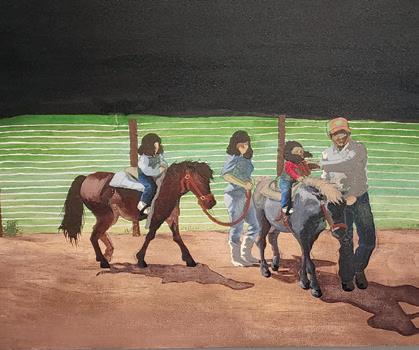

Winter Celebration
As the first snowflakes began to fall, our lifers (minus one, who got stuck at the North Pole) led students and faculty through a fun-filled Winter Celebration, full of dancing, music and holiday cheer.
Although it’s gone by several names through the years, the Winter Celebration is one of NSCD’s oldest traditions, dating back to its founding in 1919. It was back in the Mac Gym this year—for the first time since 2019—although the threat of a winter storm pushed it a day earlier than originally planned.

The program began with a welcome by Head of School Tom Flemma, then Lower School Music Teacher Linda Kiracibasi and her friends led everyone in a festive rendition of “Jingle Bells.”
Lifers Buckley Oelerich ’23 (Santa Claus), Luke Avedisian ’23 (the Grinch), Ellie Yarandi ’23 (Elf) and Junnah Quraishi ’23 (Gingerbread Person) ushered the various
buddy pairs through all the traditional dances, highlighting Jewish, German, Mexican, South African and Irish traditions. The faculty and staff joined in the fun with a mashup of Beyoncé’s “Cuff It” and the “Cha-Cha Slide.” The program closed with the traditional alumni, faculty and staff sing-along of “Winter Wonderland.”
Fall Tailgate Fun!
For the second year in a row, NSCD hosted a fun pre-game tailgate gathering in the parking lot of Northwestern University’s Ryan Field on October 8. Alumni, parents of alumni, current families and other NSCD friends stopped by to visit and enjoy food, drinks and good company!


acorn · Winter 2023 23
Faculty dance at the Winter Celebration
NU Tailgate: Christian ’29, Jeana and Jameson Tao ’24, Toren Strauss ’24, and Quay and Quentin Tao ’26
Almquist Gallery: “RE:Solving Permeated Perceptions”
Alesia and Sophia Wall ’23
John Amboian and Noreen Potempa Receive Foster Hannaford Recognition
On the evening of October 13, North Shore Country Day honored its two newest Hannaford Recognition recipients—John Amboian and Noreen Potempa. They were acknowledged together this year, as John’s recognition was postponed in 2021 because of a strong desire to celebrate this honor in person.
The Foster Hannaford Recognition program was initiated in 1985 to recognize an active member of the NSCD community for their distinguished service to the school. Each year, they join previous Hannaford recipients and other generous donors for an intimate reception on campus where they are honored for their impact on the school community.
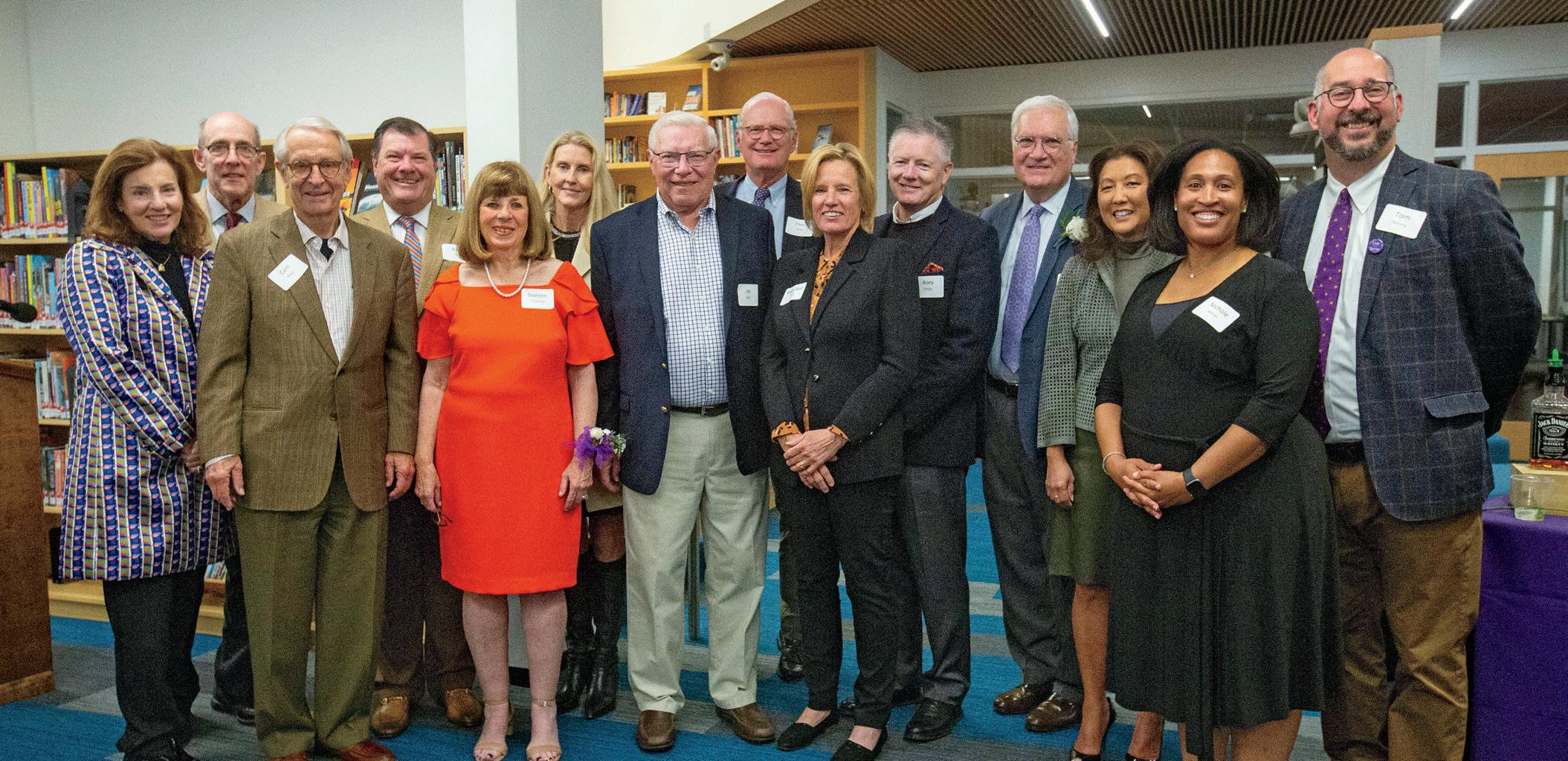
During their opening remarks, Board Chair Nichole Wilson and Head of School Tom Flemma thanked those in attendance for their philanthropic giving to the school on an annual basis, and those who have designated the school in their estate plans and are members of the Heritage Society. Then Tom presented the recognition plaques.
IN RECOGNITION: JOHN AMBOIAN
John and his wife Ann have had a long and active association with North Shore Country Day as parents of three alumni: Alex ’13, Madison ’13 and Andrew ’09. John served as chair of the Board of Trustees and currently serves as chair of the school’s Foundation Board, providing steady guidance and oversight in managing the school’s endowment, which provides not only long-term stability but a crucial stream of steady income that funds annual operations. Ann volunteered for many years with the Parents’ Association and the Benefit Board (formerly the Woman’s Board), leading successful auctions and supporting our school. We are grateful for their ongoing devotion and commitment.
John is the retired chairman and CEO of Nuveen Investments; prior to this, he served as Nuveen’s president. He is the lead independent director of Danimer Scientific, board member of publicly traded companies sponsored by Live Oak Merchant Partners, a director of Adams Street Partners, an advisor to Madison
Dearborn Partners, and is chairman of North Square Investments and Evanston Capital Management. He also serves on the boards of InspereX, Cresset Capital, Lurie Children’s Hospital and Chicago’s Lyric Opera.
His professional expertise continues to have a significant and meaningful impact on our school. Fellow trustee and Hannafordian Susan Bondurant shares her perspective: “John’s arc of involvement with North Shore will prove to be one of the lengthiest and most sustaining in school history. Chief among his accomplishments is solidifying the school’s foundation through his multi-year stewardship of the school’s foundation. His disciplined, prudent approach to leading the Foundation Board, including through the 2008 financial crisis, has led to increasing the assets of the foundation while building consensus and respecting the school’s mission.
“John’s humility and approachability belie the intellectual firepower and wisdom that has benefited so many with whom he has worked. He has been an
informal advisor to board chairs and school heads as they navigated the ebbs and flows of school leadership over the years. His thoughtful processing of strategic issues, financial topics, and cultural shifts has provided invaluable insight. Until now, John’s service has been unheralded for most in the school community, (just the way he would like it) but it’s vital to recognize how his efforts have connected the leaders of the past and forged a base on which to grow and thrive.”
John has been an incredible teacher and mentor to past and present finance directors collaborating and partnering in a way that embodies our “Live and Serve” motto. Our current Director of Finance Sue Downing has collaborated closely with John over the years and acknowledges that “John has fostered transparency between the Board of Trustees leadership and the Foundation Board, striving to partner with and support the school’s objectives while preserving the long-standing principles upon which the Foundation was originally founded.”
24 events
Susan Bondurant, John Darrow ’65, Cam Avery, Bert Getz, Noreen Potempa, Susie Getz, Jay Bach, Tom Doar, Mary Ann Finlay, Rory Finlay, John Amboian, Ann Amboian, Nichole Wilson and Tom Flemma
IN RECOGNITION: NOREEN POTEMPA
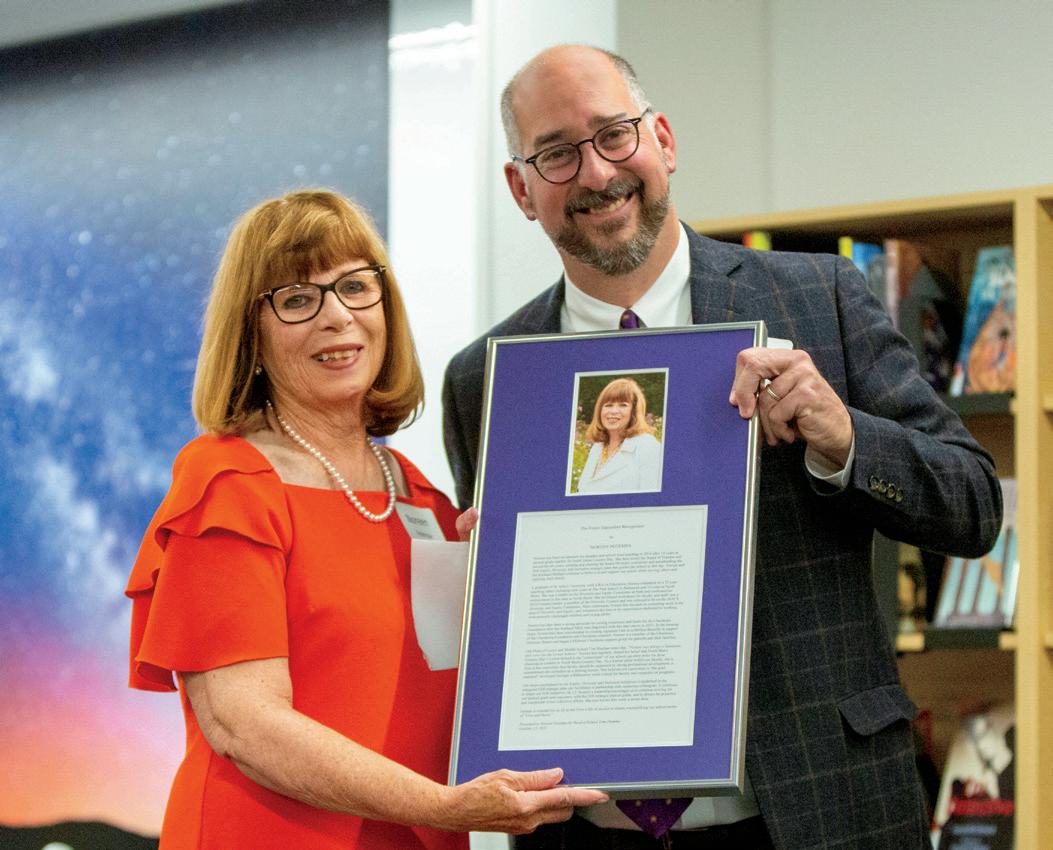
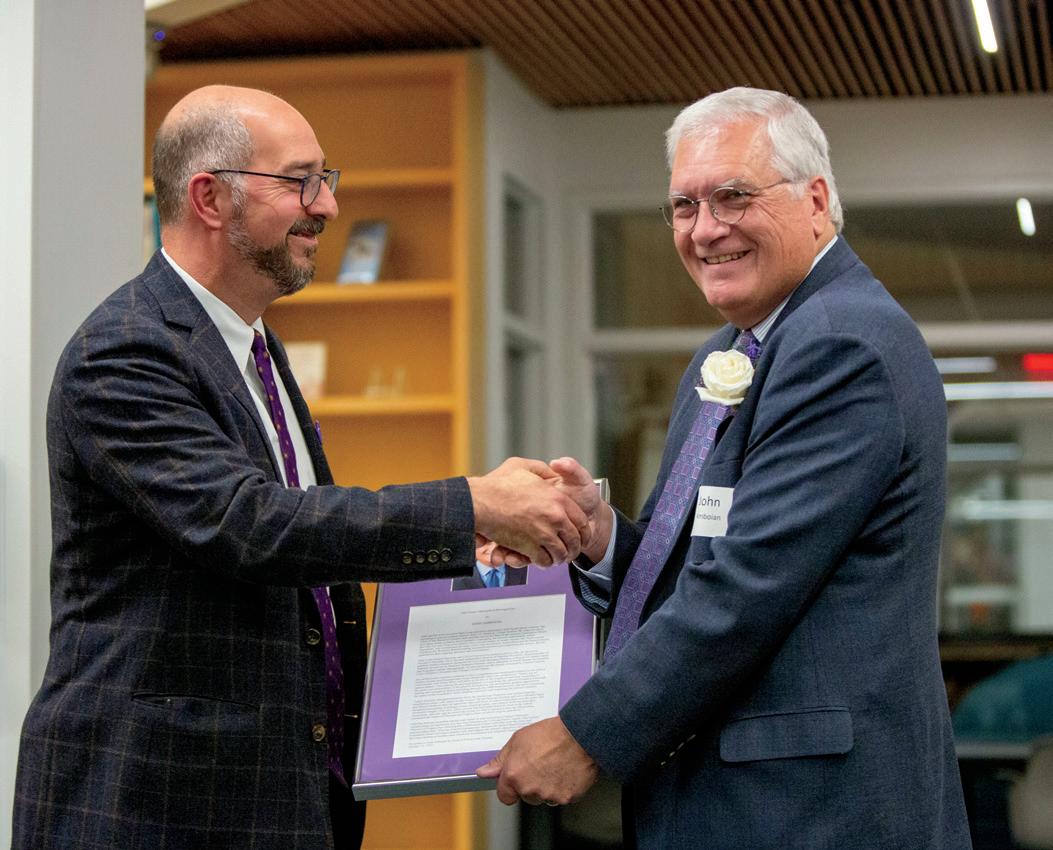
Noreen has been an educator for decades and retired from teaching in 2014 after 14 years as second grade teacher for North Shore Country Day. She then joined the Board of Trustees and served for six years, creating and chairing the board diversity committee and spearheading the first equity, diversity and inclusion strategic plan that guides the school to this day. Noreen and her husband Michael continue to believe in and support our school while serving others and enjoying their family.
A graduate of St. John’s University with a B.S. in education, Noreen embarked on a 32-year teaching career including nine years at The Park School in Baltimore and 14 years at North Shore. She was a leader on the diversity and equity committee at Park and continued her commitment in this area at North Shore. She facilitated workshops for faculty and staff, was a SEED-trained leader, a member of the diversity council and was selected to be on the ISACS diversity and equity committee. Since retirement, Noreen has focused on consulting work in the area of diversity and equity, and volunteers her time at
an organization dedicated to working with mentally challenged children and young adults.
Noreen has also been a strong advocate for raising awareness and funds for the Chordoma Foundation after her husband was diagnosed with this rare cancer in 2013. In the ensuing years, Noreen has been instrumental in creating signature One-in-a-Million Benefits in support of the Chordoma Foundation and Chordoma research. Noreen is a member of the Chordoma Advisory Board and began a Midwest Chordoma support group for patients and their families.
Our Head of Lower and Middle School Tim Sheehan notes that, “Noreen was always a champion and voice for the lower school.” Noreen has regularly shared her belief that North Shore Country Day’s lower school is the “cornerstone” of our school, an entry point for those choosing to commit to North Shore Country Day. As a former pillar within our faculty, she is firm in her conviction that faculty should be supported by strong professional development, a commitment she embodies as a
lifelong learner. She believes our curriculum is “the gold standard” developed through collaborative work critical for faculty and impactful on programs.
Her deep commitment to our equity, diversity and inclusion initiatives is enshrined in the inaugural EDI strategic plan she facilitated in partnership with numerous colleagues. It continues to shape our EDI initiatives JK-12. Noreen’s leadership encourages us to continue striving for our desired goals and outcomes, with the EDI strategic plan as guide, and to always be proactive and intentional in our collective efforts. She also knows this work is never done.
Noreen is a model for us all as she lives a life of service to others, exemplifying our school motto of “Live and Serve.”
North Shore is strengthened by Noreen and John—like so many before them and the many “Hannafordians” who will come after them, they have made a lasting impact.
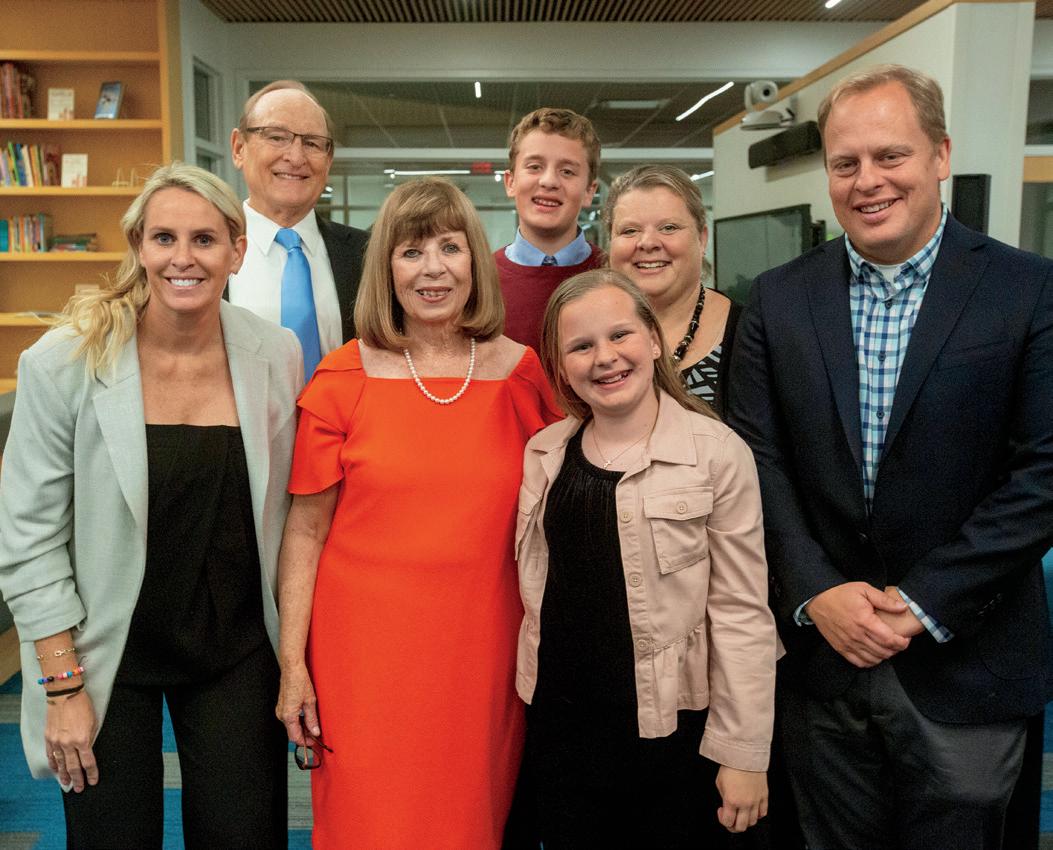

acorn · Winter 2023 25
The Amboian Family: Alex ’13, John, Ann and Madison ’13
Meredith Jaremchuk, Mick Potempa, Noreen Potempa, and Evan, Nora, Allison and Joe Villinski
Tom Flemma and John Amboian Noreen Potempa and Tom Flemma
Professional Development
During faculty orientation week in August, lower school faculty participated in a workshop facilitated by diversity practitioner Britt Hawthorne, who also has been meeting with teachers one-on-one or in gradelevel teams throughout the year.
A number of faculty received summer curriculum grants to revise the Equity, Diversity and Inclusion curriculum for upper school advisories, develop a new art production course, build the curriculum for a new Gender and Sexuality Studies class, revise the early childhood and primary literacy curriculum and create more inquiry-based lab experiments and STEAM projects for middle schoolers.
First Grade Teachers Yael Kurganoff and Pippa Nyamweya , Second Grade Teacher
Cristina Torres , Third Grade Teacher David Green , Fourth Grade Teacher Jackie Haug , Fifth Grade Teacher Ellen Rasmussen , Lower School Math Specialist Amy
Shuldiner and Lower School Learning
Specialist Vimla Patel completed a virtual training in August about implementation of the new enVision math curriculum. Then in November, they completed an allday training on campus to learn even more about the program.
Yael Kurganoff and Pippa Nyamweya , Second Grade Teachers Marcy Ramos and Heidi Black , Fourth Grade Teacher Rachel
Kruenegel and Fifth Grade Teacher Brooke Bowers are receiving ongoing training in Structured Word Inquiry (SWI) through Language Insights. (See story, page 14.)
Development Associates Kim Baker , Troy Chirico , Ashleigh Palmer Weathers ’04 and Maureen Wilde , Senior Associate
Director of Development Tracie Frederick and Communications Associate Christine Wachter attended the Lake Michigan Association of Independent Schools fall meeting in Chicago in October.
Mathematics Department Head and Middle School Math Teacher Graham Rosby , along with Jackie Haug , Amy Shuldiner , Middle School Math Teacher
Kristen Slamar and Upper School Math Teacher Juan Vidal , attended the Illinois Council of Teachers of Mathematics Annual Conference on October 29 in Naperville, featuring keynote speaker Peter Liljedahl, author of “Building Thinking Classrooms in Mathematics.”
Upper School English Teacher Kim Diorio , Junior and Senior Kindergarten
Teacher Janet Lord , Vimla Patel , Juan Vidal and Ashleigh Palmer Weathers ’04
attended the NAIS People of Color Conference in San Antonio November 30-December 3.
Lower School Art Teacher Emily Culbert , Third Grade Teacher Stephanie McShane and Director of Library and Information Literacy Jenna Nemec-Loise received Responsive Classroom training in Chicago on December 8. Emily and Jenna attended a workshop specifically for special area teachers, while Stephanie attended an introductory workshop.
English Department Head and Upper School English Teacher David Grossman received an NSCD Lifelong Learning Grant to go biking in Wyoming. Fifth Grade Teacher Ethan Rodehorst received a Lifelong Learning Grant to travel to Greece and Italy.
Yael Kurganoff and Pippa Nyamweya attended a Handwriting Without Tears virtual workshop in September.
Lower School Counselor Montse Lusaretta , and Director of Counseling and Upper School Counselor Terri Webb attended a webinar entitled, “Caring for Those with Suicide Risk—What Every Clinician Should Know.”
Upper School Art Teacher Frances Allende-Pellot attended an online Advanced Placement Art and Design Workshop.
Kim Baker attended the CASE Alumni Engagement Strategies Conference in Los Angeles in December.
Lower School Learning Specialist Claire Detjen is completing an advanced learning seminar series on the SLANT System For Structured Language Training.
Head of School Tom Flemma attended the 2022 INDEX PK-12 Schools Conference in San Antonio in October.
Director of the Live+Serve Laboratory and Upper School Social Studies Teacher Drea Gallaga is leading the ongoing ISEEN Professional Affinity Group for White Anti-Racist Educators.
Middle and Upper School Instrumental Music Teacher Ann Goodrich attended the Midwest Clinic International Band and Orchestra Conference, the world’s largest instrumental music education conference, in downtown Chicago in December.
Middle School Social Studies Teacher Kirk Greer in October participated in a Facing History workshop on the 1919 race riots in Chicago and in November attended a workshop at the Chicago History Museum on the experience of Japanese Americans relocated to Chicago after their WWII internment.
David Grossman participated in a weeklong collaborative discussion coach training through the Interactivity Foundation in June. He also participated in a virtual place-based education deep dive by Teton Science Schools in July and August.
Help Desk Manager Chris Jurack joined IT professionals from around the world September 27-29 at the Jamf Nation User Conference in San Diego.
Junior Kindergarten Teacher Kristi Kamen over the summer attended a virtual conference for early childhood educators, sponsored by ELEVATE Your Classroom. There were over 31 professional development speakers covering various Early Childhood topics, including science, reading, writing, social-emotional learning, EDI, math and the importance of play.
Lower School Reading and Learning Specialist Sharon Lieberman attended a webinar in October entitled, “The Science of Reading Levels with Dr. Tim Shanahan.” Montse Lusaretta completed an online workshop on mindfulness-based techniques that help to increase focus, enhance self-regulation and strengthen compassion.
Director of Development Molly Ingram McDowell ’80 attended the INDEX Advancement Conference in Salt Lake City in November.
Upper School English Teacher Kathy McHugh participated in a number of workshops through Facing History: “Confronting a Violent Past: Red Summer in Chicago,” “Meeting the TEAACH Act” and “Confronting Hate: Repairing the World: Stories from the Tree of Life.”
Assistant Head of Lower School Caitlin McLennan attended a K-8 Responsive Classroom Leadership Seminar in November entitled, “Cultivating School Culture.”
Administrative Assistant for Upper School, Admission and College Counseling Candice Sayles attended an online workshop for admission and enrollment supporters, sponsored by the Association of Independent School Admission Professionals.
Christine Wachter attended an ISACS Workshop entitled, “Essential Partnerships Between Admissions & Communications Leaders for Enrollment Growth” in Chicago in September.
Middle School Humanities Teacher Sarah Walsh is participating in the ongoing ISEEN Professional Affinity Group for Environmental Leadership.
26 faculty
Faculty Profile: Graham Rosby
 MATH DEPARTMENT HEAD, MIDDLE AND UPPER SCHOOL MATH TEACHER
MATH DEPARTMENT HEAD, MIDDLE AND UPPER SCHOOL MATH TEACHER
Q. So what did you do after you failed out of your major?
A. My undergraduate degree is in linguistics, which I think has a lot of similarities to math. You’re still thinking in a super logical way, but you’re dealing with natural language patterns instead of real numbers. After I graduated, I spent a few years teaching at a variety of independent and public schools in Massachusetts— Phillips Academy, Cambridge Rindge and Latin School, and Waring School, where I taught both humanities and math. Then I went to Harvard’s Graduate School of Education for Instructional Leadership in Mathematics.
But the other backbeat of my teaching career has always been the Math Circles model. I’m a founding teacher for Math Circles of Chicago, and I’ve been volunteering with that organization since 2011. I had the good fortune of having some really great teachers in math throughout my own high school experience who have stayed on and become mentors and friends into my adult life. Doug O’Roark, the current executive director of Math Circles, is one of those former high school teachers of mine, and he is a big inspiration.
Q. What exactly is a Math Circle?
learning fresh, and you end up finding lots of connections in whatever curriculum you teach.
Q. Why is making connections so important in math?
A. One of my current teaching icons is Peter Liljedahl who wrote the very influential book, “Building Thinking Classrooms in Mathematics.” One of the things he says in his book that totally reframed how I thought about student challenge with math is that oftentimes algebra is framed as this stumbling point for students because it’s where suddenly things get more abstract. That’s not really the case. It’s not that algebra is more abstract, it’s that so much of how students are learning to do math in those early years is just copying certain processes. In algebra and all the courses beyond, students’ capacity for mimicking what the teacher is doing becomes more limited. Learning has to be based on a stronger conceptual understanding of why things work and not just because the teacher said I’m supposed to do this next.
Q. What led you to become a math teacher?
A. I realized that I wanted to be a math teacher after I failed out of that major. Math came so easily to me as a secondary level student. But when I went off to college and majored in math at the University of Chicago, I passed into all these secondyear major courses—really highfalutin stuff. I thought math was about being as smart as possible, getting to the top of everything, but I didn’t have a good foundation or a deep conceptual understanding. I had to have a personal reckoning— to understand that math is not about speed or just getting the right answer. It’s a very collaborative process. It’s not about this individual genius so much as it is about creating the right community in which lots of different people can speak, listen and be heard. I had to personally go through that experience of knowing what it was like to struggle in math before I could become a math teacher.
A. A Math Circle is a recreational gathering of folks from all different ability levels, centered on the idea that deep, rich math is for everyone. It can often take the form of play. We do a lot of games in Math Circles, but what we’re teaching students to do is actually a lot more like what undergraduate or graduate students do in math, rather than what most secondary students are doing. Secondary math is usually about solving a bunch of problems using a theorem. Math Circles are more about how a math game or puzzle might open up lots of theorems. But then what can you change about the problem? What can you generalize about the problem? How can we represent this in different ways?
I’ve run math circles here at North Shore with fifth and sixth grade students, and I have been part of math circles for teachers. Just like most English or humanities teachers I know read books for pleasure, so many math teachers have a craving to solve new problems. Math Circles are a great way to keep the
Luckily, that is not how we teach math at any level throughout our math department here at North Shore. We’re really focused on building multiple representations. So much about reading and analyzing literature is making connections between themes: I’ve read something like this in a previous book before or I’ve noticed this in a passage. The same is true about math. Some of your best learning happens when you say, I’ve seen a problem like this one before. Or I didn’t think about it in the same way that someone else was thinking about it. Making those new connections is what helps give you a strong foundation for why things work and not just, I’m following a series of procedures.
When students are curious and really listen to other people’s thinking and how they are approaching problem solving, it not only improves their own conceptual understanding but also builds the skills needed to make people feel welcome. So much of what we’re trying to do at a place like NSCD is build a sense of community, not just individual students with their individual successes and challenges. And I think math is really an ideal subject to do that in.
acorn · Winter 2023 27
“Live and Serve” Update
What does “Live and Serve” mean? Ask anyone who’s been at NSCD over its history, and you’re likely to hear about service projects, volunteering, perhaps Interim week or the Northwestern Settlement House drive. Those are all still important parts of “Live and Serve” at North Shore, but on campus we’re working to expand the meaning of this term and broaden our commitment to making good in the world. Just as “service” meant service to the local community in the earliest days of the school but has since expanded nationally and globally, “Live and Serve” has begun to embrace and integrate community engagement and social impact projects in the classroom alongside more traditional service projects.

“Live and Serve” in the classroom
In the first half of this school year, “Live and Serve” has shown up in lower, middle and upper school classes through projects that ask students to learn more about others, to think critically and to take action. Often utilizing the Live+Serve Lab, students have taken on leadership roles in the classroom while working to solve problems or to fill needs they see in their communities or the world.

During their yearlong study of communities, first grade students polled different constituencies around campus (like lower school specials teachers, eighth graders and even the cafeteria workers) to see what they would want or need in their ideal community. Then they worked together in the Live+Serve Lab to create maps that incorporated the data from their interviews. The first graders learned the
important skill of asking people what they need and want and then analyzing their findings to create a solution!
Students in sixth grade science spent several weeks this fall working on their inventions project. The challenge from teacher Paaven Thaker is to invent something that can make someone’s life better by solving a real problem in the world, and then to prototype solutions in the Live+Serve Lab. While Paaven gives constant feedback and asks the students a lot of questions about their ideas, she doesn’t tell them what to build or what problem to solve; students must brainstorm ideas and figure out what solutions might be. Fortunately, sixth graders are abundantly creative! This year, some of the solutions included an umbrella with a built-in water filter in case you need a drink while you’re walking in the rain, socks with tiny pockets for magnets so they’ll stick together in the wash and a robot snack machine (“snackbot”) that could deliver a snack anywhere on campus.
Rather than take a test to show their knowledge of the impact of European colonization during Columbus’s time, sophomores in World History 2 used the resources of the Live+Serve Lab to create monuments that reflected their view of the legacy of this important event. Upper School Social Studies Teacher Peter Strickland asked, “If you were tasked with constructing a complex and just monument, how would you do it?” For this assessment, students considered what histories are commemorated, the act of commemorating, and how to create monuments that better reflect more complicated and complex views of the past. For our students, history is not just something in a textbook, but something we live with every day that must be examined critically
and considered from a variety of viewpoints. Such critical consideration is an important part of students’ “Live and Serve” journey, as they come to understand more fully why the injustice that necessitates service exists in the first place.
Many other projects brought this critical consideration of community and problem solving into classes in a variety of ways as well, all using the Live+Serve Lab as inspiration and the focus of their activity. As part of a unit studying Sophocles’s play Antigone, English 9 students did a service-learning project in the form of writing advocacy letters to elected officials, using their developing argumentative skills to urge change around issues they cared about such as gun control and the gender pay gap. Spanish 4 students practiced their Spanish skills while discussing environmental issues and creating models of ideal, futuristic, sustainable cities. And students in the new middle school arts class Craft Lab used their sewing skills to create warm winter hats for others.
Student leadership through “Live and Serve”
Community service clubs in middle and upper school foster student leadership while working on service projects. In both divisions, students decide which projects to take on and plan and execute those projects. So far, both groups have made cheerful cards for children in the hospital, as well as no-sew blankets and dog chew toys. The middle school community service group has also made bag lunches for Connections for the Homeless and even wrote up the steps for making lunches so that all middle school advisories could easily do this activity throughout the year. The Upper School Community Service
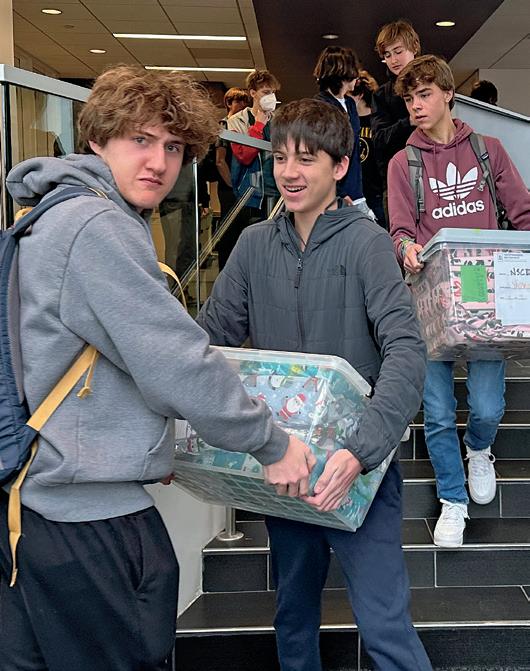
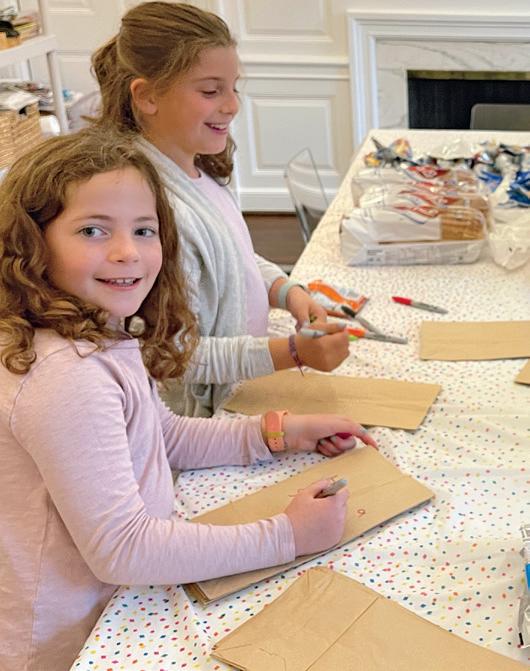
28 live and serve
Ellen Darku ’24
Luke Hansen ’25, Smith Flickinger ’26 and Charlie Ver Eecke ’25
Lilly Frezados ’31 and Lou Sherwood ’31
Designed by Lexi Shultz ’26
Board, composed of students with service experience who apply for the position, oversees all student-run service in the upper school. This fall they vetted and supported service projects from the Urban Initiatives Youth Board and the Jewish student affinity group.
Ongoing “Live and Serve” Community Partnerships
NSCD’s work with Connections for the Homeless in Evanston has continued to expand this year, as families participate in making lunches and dinners several times per month. The Parents’ Association “Live and Serve” committee also sponsored a fall work day with Connections, where participants helped to clean up and organize the drop-in space so items were more accessible and easy to find. Around Halloween, third graders painted pumpkins for the Connections community, sharing their creativity and joy. The partnership between NSCD and Connections has been going strong for more than 20 years, and the school is always excited to find new ways to support their important work.
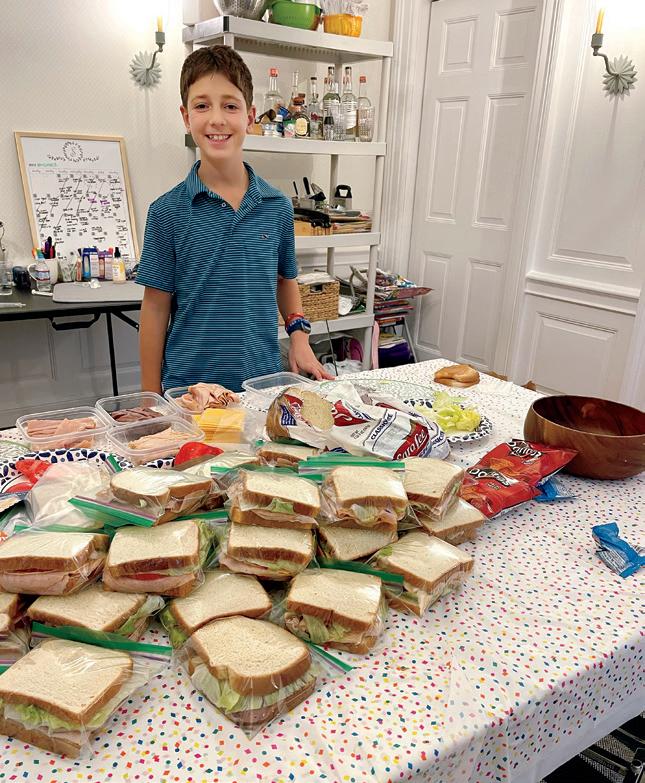
Once again this year, NSCD families participated in the Northwestern Settlement House holiday drive. For the second year in a row, NSCD collectively sponsored holiday gifts and gift cards for 50 families who participate in the Settlement House’s programs. This feels especially meaningful this year, as the Settlement House provided gifts for 336 families altogether, and North Shore’s participation was a significant proportion of this support.
Heritage Society: Jim Tuthill ’65
What compelled you to make a planned gift to North Shore?
Simply to say “thank you” and acknowledge the inspiration for learning instilled in me through the dedicated NSCD faculty and my fellow classmates. Through all of them, I acquired a deep exposure to literature, music, art and theater. And to express my appreciation to the memory of two former faculty, Barbara Foote and Nathanial French—who sadly cannot witness my gratitude—who never lost confidence in my ability to excel. I owe them more admiration than I can adequately express.
What part of your North Shore Country Day experience has remained with you in your life?

My NSCD experience has been and is a fabric of who I am. From Morning Ex, to the plays in which I was a part, to classes with Richard Lacey, William Talley, Frank Wallace, John Almquist and Elsie Harridge, what they sought to teach us are me. Despite my initial rejection of the principle, Mr. Lacey convinced me that if you can’t explain something to someone else so they can comprehend it, you don’t understand it. How true. And how did Ms. Harridge survive having me, Tom Dietzgen ’65 and Stets Ames ’65 in the same math class: her dedication and patience. And I retain gratitude to fellow classmates, such as the NSCD hockey team—Bruce Jarchow ’66 and the 11th and 10th grade members—who so welcomed me despite my lack of skill. I have not forgotten.
What do you hope your planned gift will accomplish for the future of the school?
Only to inspire others in so many directions as NSCD did me.
Individuals who have made provisions in their will or estate plans to benefit North Shore Country Day are recognized in the Heritage Society. This significant support and commitment of many friends of the school have allowed North Shore to grow and expand. For more information, please contact Director of Development Molly Ingram McDowell ’80 at mmcdowell@nscds.org or 847.441.3316.
29 acorn · Winter 2023
Mack Sherwood ’30
Jim Tuthill ’65 with partner Helen Barker
SAVE THE DATES
LINDAPALOOZA
MAY 19
5:30 p.m. Concert
Join us in the auditorium to sing with alumni and celebrate Lower School Music Teacher Linda Gibson Kiracibasi as she heads into retirement. Adult Reception to follow.
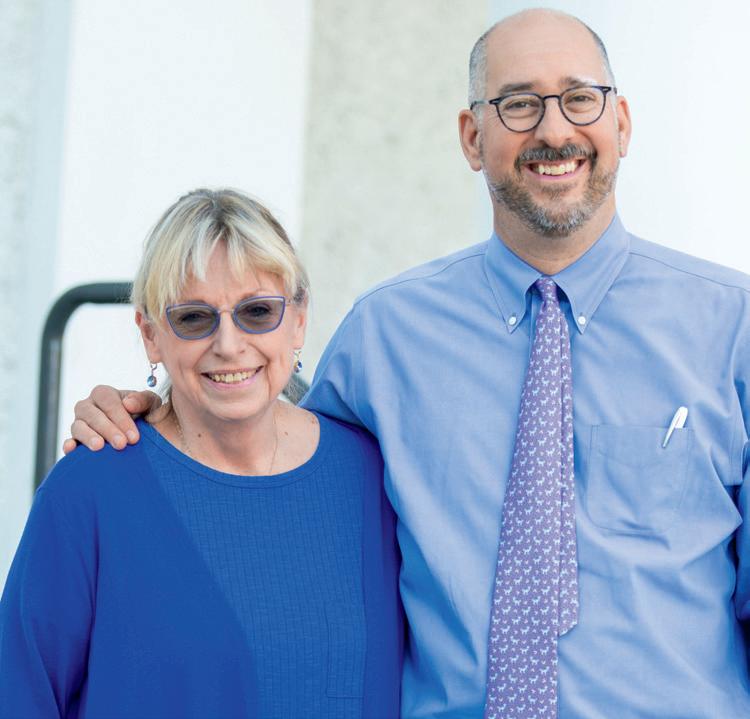
“LIVE AND SERVE” FEST
MAY 20
Show your Raider spirit with an act of service in your community. Or if you are in the area, join us on campus for service projects and family fun at “Live and Serve” Fest—a joint effort between the Parents’ Association, Alumni Board and the school’s “Live and Serve” programs, providing opportunities for the entire NSCD community—students, parents, faculty, staff and alumni—to take action through service.

Want to know how you can get involved? Students, faculty and staff can email dgallaga@nscds.org Parents can email paliveandserve@nscds.org Alumni can email aweathers@nscds.org

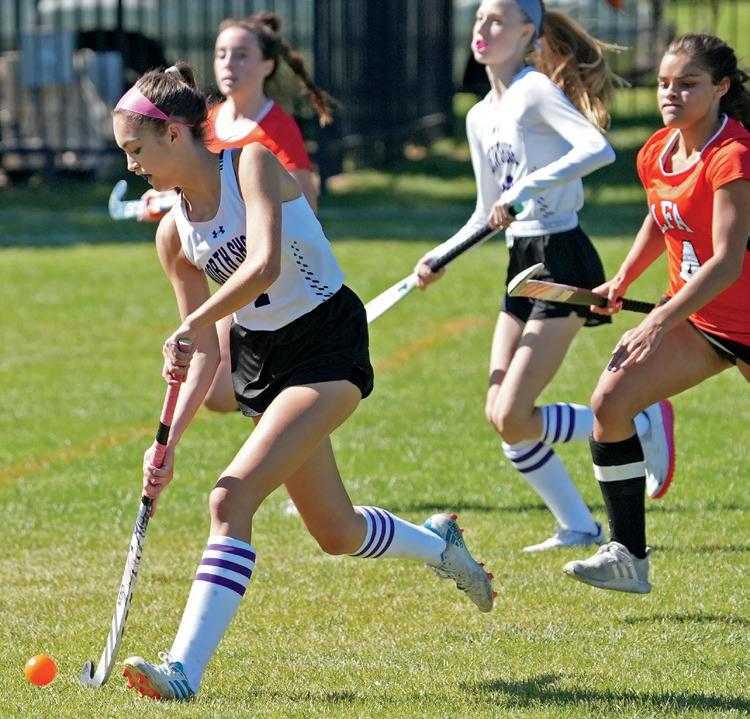



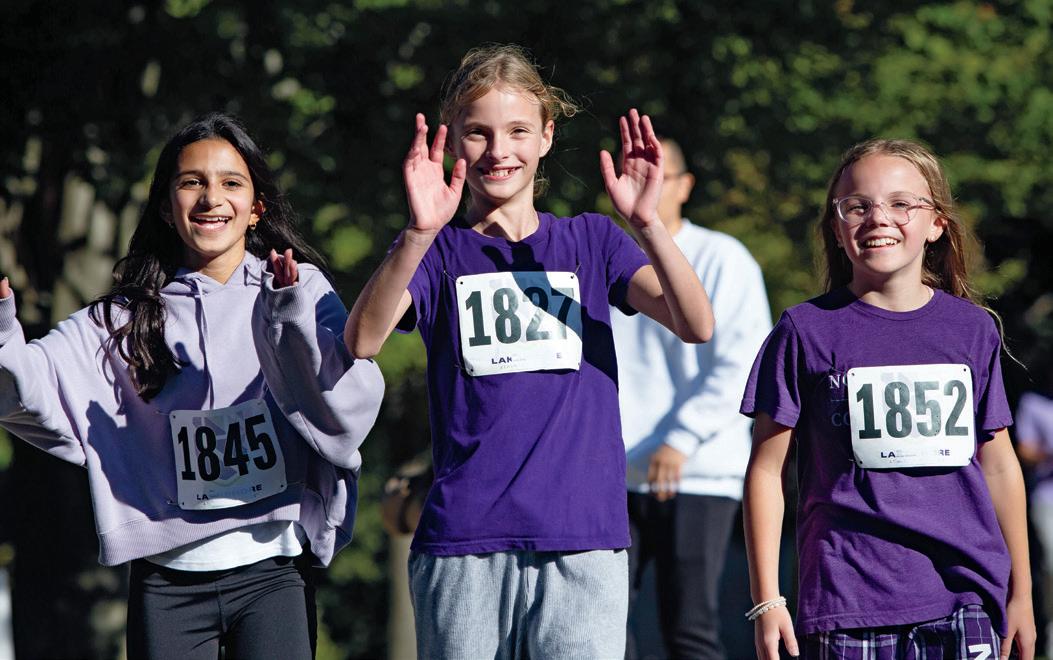

HOMECOMING WEEKEND
SEPTEMBER 29 – 30
Classes celebrating special reunions include: 1948, 1953, 1958, 1963, 1968, 1973, 1978, 1983, 1988, 1993, 1998, 2003, 2008, 2013, 2018

Volunteers for reunion committees are needed! If you’d like to join, please contact Ashleigh Palmer Weathers ’04 at aweathers@nscds.org or 847.881.8848.
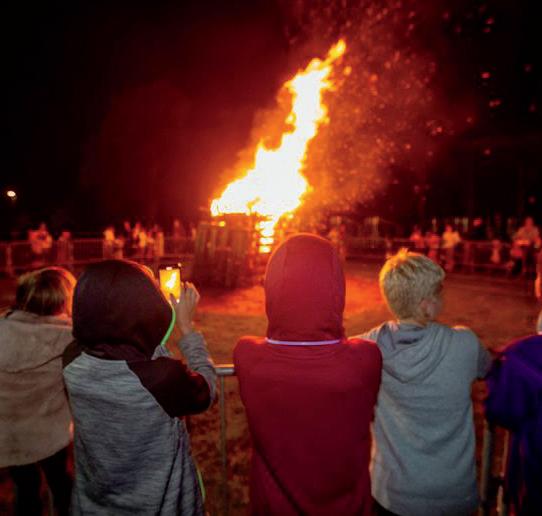
REGIONAL GATHERING
We’re coming to Boston this spring!
SAVE THE DATE: Friday, April 21, 2023
Watch your inbox for more details, or contact Molly Ingram McDowell ’80 at mmcdowell@nscds.org or 847.441.3316.
1940s
Louise Konsberg Noll ’40 wrote “Twenty members of my family came to celebrate my 100th birthday! My children, grandchildren and great-grandchildren.”
David Scott ’45 writes, “Under the inspiring influence of Latin classes with Mrs. Childs, I have just published my first book ‘My 20 Years in Italy.’ It is a travelog of my business and travels. It starts with my marriage to a beautiful Milanese artist Lydia Vergani (and Italian fencing champion), and raising our three ItalianAmerican children in Milan, Italy. It is being published by Outskirts Press and is available on the shelves of Amazon and Barnes and Noble. It includes my business and travels to countries of the Common Market, along with business in Saudi Arabia and Kuwait, Nigeria, Timbuctoo, Argentina, Iran and several of the East European countries. I was at Harvard with NSCD classmates Tim Wallace ’45 and Gerry Fisher ’45 and played football at NSCD with Fran Burlingham ’45 , Russ Stern ’45 , Stu Gordon ’45 , Dan Ward ’45 and Brook Ballard ’45 . Living in New Hampshire for the past 22 years, I have been involved with New Hampshire

politics serving as a Republican state representative in the New Hampshire General Court (state legislature).”
John Lindgren ’47 is “In U.K.—still alive! My interest in Kenya is carried on by my children.”
1950s
Thomas Taylor ’55 remembers “One of my best experiences at NSCD were the social studies classes in middle school where Mr. Steel and Mr. Brown taught us about the psychology of advertising and misinformation. Has stood in the good stead over the years.”
Liz Washburn Borozan ’57 is still happily living in the desert with her golden retriever! She has two of her three children and three grandchildren in Tucson also!
1960s
Mitzie Fraker Wynkoop ’60 shared that she has moved from Denver to Michigan permanently.
Boo Bradford ’66 wrote, “Hello all. I lost my husband Jack two years ago, but doing well thanks to family and friends. In Washington D.C., with winter in Florida and summer on Cape Cod.”
John Kollar ’66 is the newly elected chairman of the Crestwood Place seniors-only residence apartments located in Northbrook, IL.
1970s
Betsy Perkins Hill ’70 writes, “I want to share with all of you that a book I coauthored came out in February 2023: ‘Your Child Learns Differently, Now What?’ The book comes from our experience working with kids who learn differently (and the real truth is that everyone learns differently), helping them be more successful in school and in life. It captures what we’ve learned from conversations with thousands of parents and educators. If I knew then what I’ve learned in the past 15 years, my experience as a teacher and as a parent would have been quite different.”
Andy Scheman ’72 was listed as one of the top 150 medical dermatologists in the U.S. by Newsweek Magazine.
Sue Colbert Spofford ’72 writes “I live on the West Coast of Florida—Hurricane Ian missed us by 75 miles!!!”
Francis Stanton ’73 says “Hello friends, family and artists: Thursday, December 8, was the Grand Opening of the Inkling Gallery! The address is 901 Watson Ave. #101, Madison, WI 53713. There’s plenty of parking in the lot right out front. For a preview of my work, please check my website: franstanpix.com. If you missed the opening, please feel free to make an appointment (608-334-9037) or just stop by during the afternoon to get a tour.”
Rich Delong ’75 announces “This November I was elected to the Nevada State Assembly.”
1980s
Price Deratzian Arana ’81 is a serial entrepreneur who has co-founded Neen, a clean, sustainable makeup company: Weareneen.com
Alan Blumberg ’83 writes, “I’m excited to share that a charity I started in 2008, officially became a nonprofit this year. The organization is called Hope Chest and our mission is to provide toys and gifts to the neediest of families, in the New Haven, Connecticut, area. Parents and caregivers who are mentally or financially challenged pick out the toys that they believe the child will like. It brings the families closer together during the holidays. To learn more, visit at www.hopechestct.org.”
Nadia Nagib Wallace ’84 shared, “My family has had an exciting year! My daughter Lila has discovered, like three others in our family, that she loves tending a soccer goal—which is fun! She’s also enjoying 10th grade. My son John is a sophomore at Princeton University, where he is the head of the undergraduate rocketry club. He enjoys recreational baseball, Arabic language study and a fun social life, in addition to his engineering studies. I myself am excited to be choosing my next endeavors and adventures after parting ways with my former spouse. We all feel blessed to have had a wonderful family summer gathering with my 88-year-old dad, Dr. Ahmed, who shared amazing stories of his childhood in Egypt. I have been in touch with several NSCD alumni and am looking forward to more reconnections.”
class notes 44
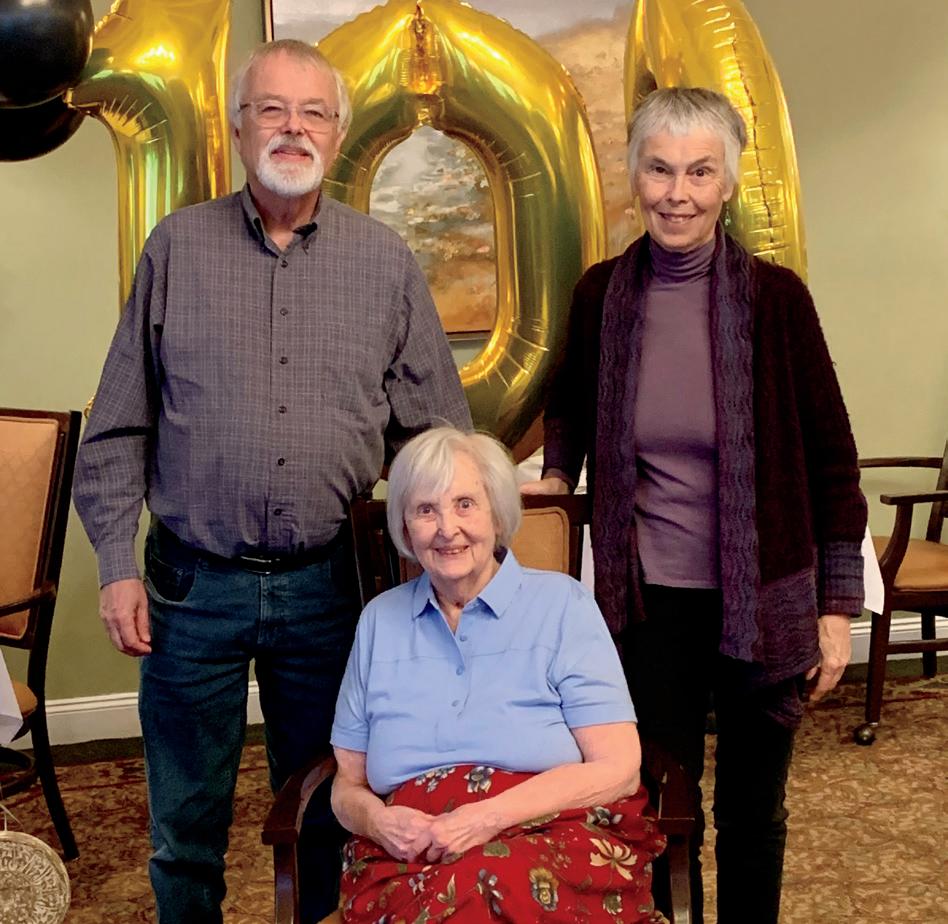
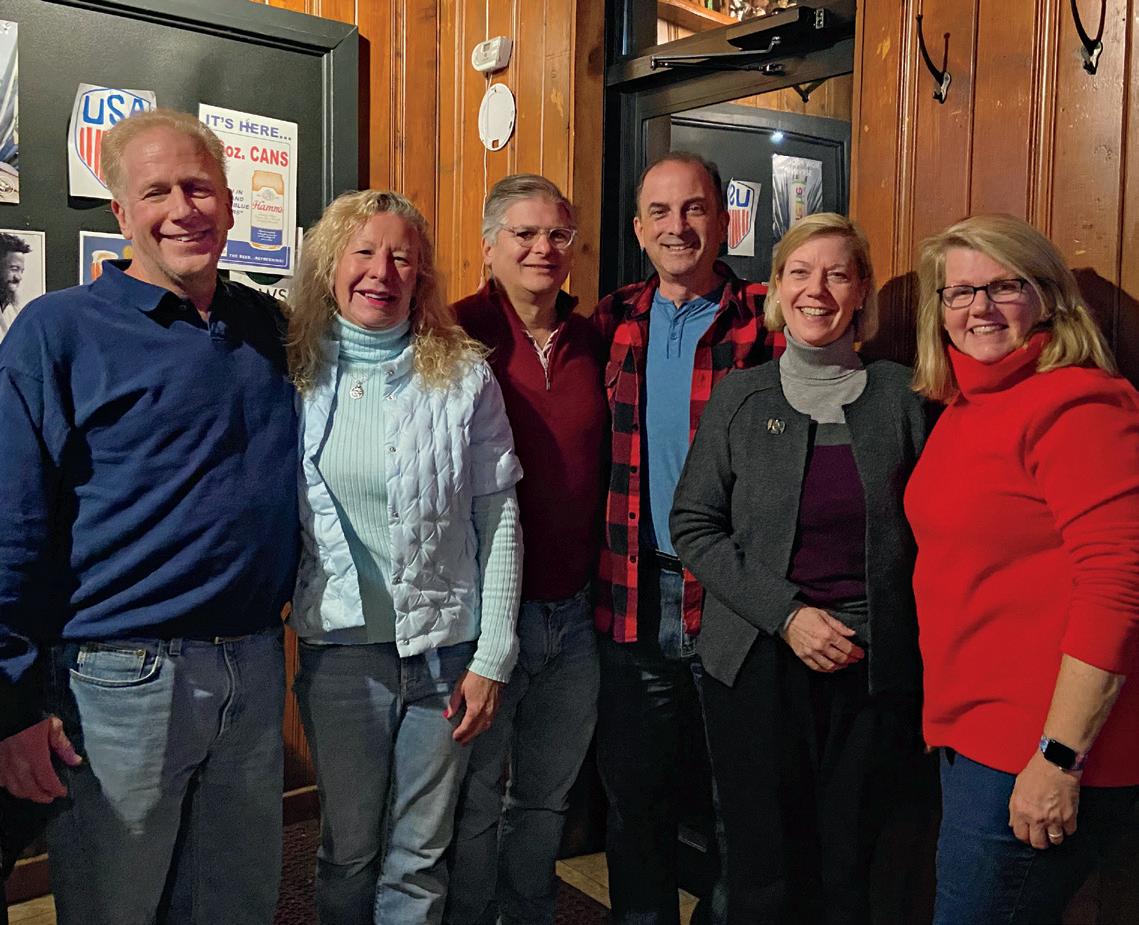



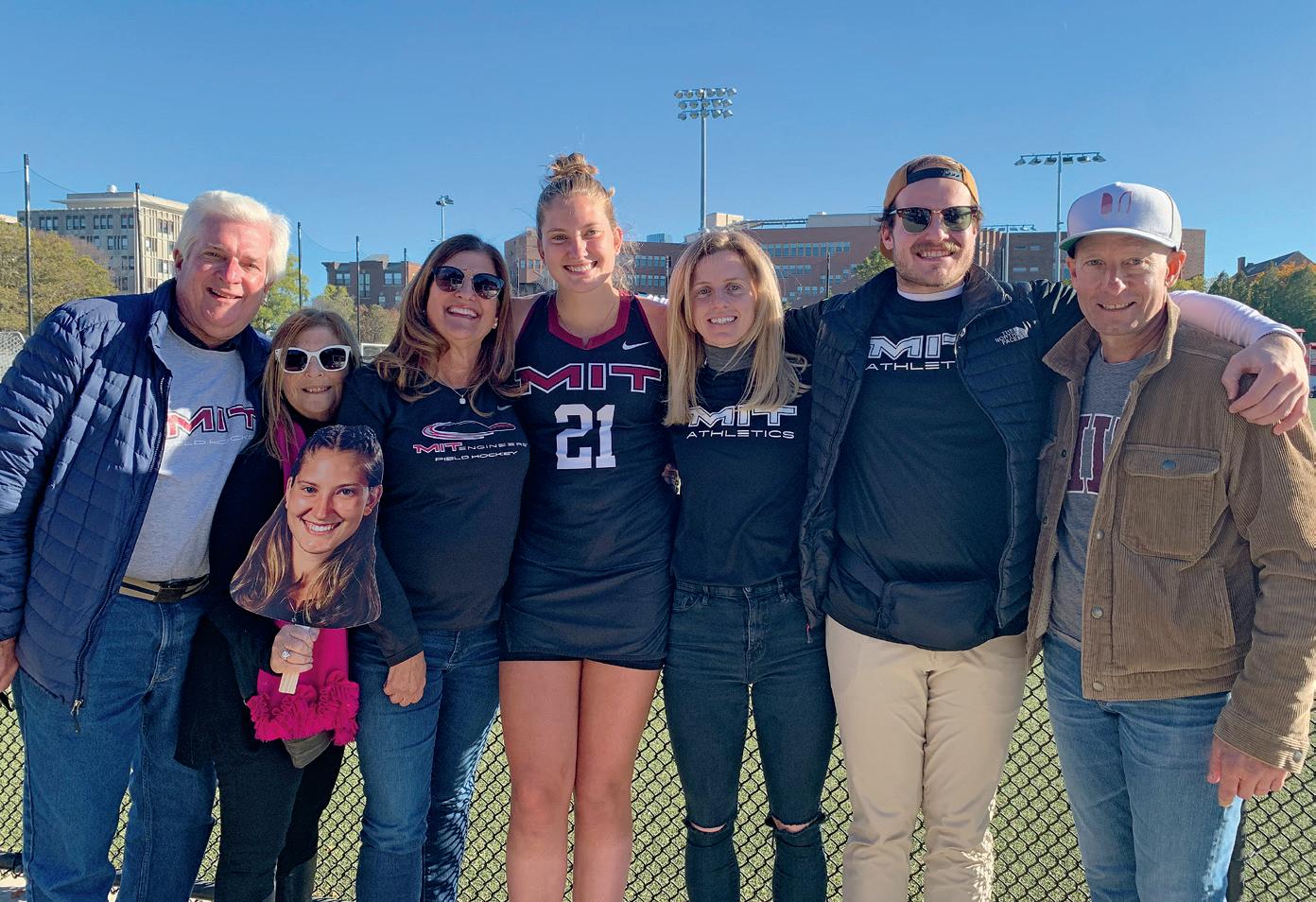

45
Jim Deuble ’76 and Aleda Deuble ’12 Di Li and Sara Hondmann ’14
Friends in the Class of 1980: Miller Bransfield, Lucy Sievers, Jeff Foreman, Mark Peebles, Molly Ingram McDowell and Liz Miller Leonard
Louise Konsberg Noll ’40 with her family on her 100th birthday
Paige Forester ’19 (center)
Zinzi ’21, Leif ’24 and Thandi Steele ’18
Madeline Tank ’11 and Erin Martin
Andrea Wright ’88 started The Wright Path in 2014. She is a life and executive coach. New programs for 2023 include: “Wright Your Book,” “Get to the Next Level,” and of course, “Trusting the Tingles.” She is currently accepting new clients. Her book, “Trusting the Tingles,” was published in 2016. “Knowing” will be published later this year.
Friends in the Class of 1980 gathered in November to welcome Mark Peebles when he was in the Chicago area: Miller Bransfield, Lucy Sievers, Jeff Foreman, Mark Peebles, Molly Ingram McDowell and Liz Miller Leonard (with three of our seven lifers represented—Mark, Miller and Lucy!).
2000s
Alex Moffat ’00 has a role in the movie “80 For Brady.” This movie is inspired by the true story of four best friends living life to the fullest when they take a wild trip to the 2017 Super Bowl LI to see their hero Tom Brady play. The PG-13 movie was released January 31.
2010s
Madeline Tank ’11 recently presented at the Fall Educators Conference of the Northwest Association of Independent Schools alongside a fantastic group of educators. Madeline presented to fellow educators about their Integrative Studies unit, “Why Should Utah Care About Wolves?” Along with two colleagues, she demonstrated how Integrative Studies at McGillis works, how this kind of learning connects to the McGillis values, and how other schools can use project- and placebased education in their own classrooms.
Aleda Deuble ’12 ran the 2022 Chicago Marathon. She is pictured with her father Jim Deuble ’76.
Mary Sturgis ’12 announced “last February, I began my career as a U.S. diplomat with the Department of State. I’m looking forward to continuing to live out the NSCD motto of ‘Live and Serve’ during my first tour to Lomé, Togo.”
Sam Skinner ’12 shares that he started as an associate at Kirkland and Ellis in Chicago this past September.

Sara Hondmann ’14 and her boyfriend Michiel van Groesen came to visit campus while they were in town. Sarah was able to see her former teacher Di Li as well. Sara was equally excited to attend the London gathering this fall.
Claudia Hayward ’18 wrote “I’m thrilled to announce my promotion as an account executive at Brooksource. I’m so grateful and proud of all the hard work, grace and grit from myself as well as my amazing mentors to get me here! I cannot wait for all that is to come in this new role with the best team by my side!”
Thomas McDowell ’18 wrote “ I’m happy to share that I’ve started a new position as business development representative at Sprocket Sports in Chicago!”

Grace Scullion ’18 recounts, “ Mrs. McHugh’s op-ed assignment in 11th grade English first got me writing for a wider audience. Now, I’m an intern at POLITICO in Washington reporting on health policy, writing for the Future Pulse newsletter (subscribe if you’re at all interested in the future of health tech and policy at www.politico.com/newsletters/futurepulse), and occasionally appearing on the Pulse Check podcast. I’m learning a LOT, from the payment structure of Medicare
Part B to the biochemical process behind an adjuvanted flu vaccine. As a burgeoning reporter, I am so grateful that I can rely on a strong foundation of writing skills—a foundation built at North Shore.”


Thandi Steele ’18 graduated from Williams College in June and is currently working for a consulting firm in Boston. She double majored in statistics and Chinese and received two awards at her graduation ceremony. One is for her statistics major “colloquium presentation,” and the other one is for her Chinese studies, awarded to a graduating senior who “achieves distinction and shows outstanding promise in Chinese.”
Alex Arenson ’19 says “I’m happy to share that I’m starting a new position at Santa Clara University as campus engagement ambassador at Miller Center for Social Entrepreneurship, an organization accelerating entrepreneurship to end global poverty and protect the planet!”
Paige Forester ’19 started field hockey as a freshman at NSCD and played with the hand-me-down stick and protective gear from Sara Hondmann ’14 , at that time a freshman in college. Paige is now playing field hockey at MIT, and on senior day she had three assists and one goal. With 156 career points, she broke MIT’s career points record. Paige is one of the named 2022 NFHCA first team All American players in field hockey.
2020s
Alex Freiburger ’21 shared, “I am incredibly excited to announce that I was offered the opportunity to join UBS as a corporate cash management intern this upcoming summer!”
class notes 46
Samuel Pieter Vreede
Whit Williams Bonetti
Zoe Skye Hewlett Blair Cody Gallas
Former Faculty and Staff
Maxine Mitchell passed away on December 28 at Holton Manor in Elkhorn. She is the wife of George Mitchell , who is the former staff member who oversaw the NSCD maintenance department for years. Maxine was known and loved by many and was involved in NSCD community activities.
Maxine was the first child born to Ruth (Brown) and Thomas Hill on March 14, 1931, in McGhee, Arkansas. The family left Arkansas when she was six years old and came to Chicago where Maxine attended Farren Elementary and Dusable High School. She married Eugene Milsap in April of 1951. Their son Norman was born in June of 1959. Maxine graduated from Chicago Teacher’s College in 1963 and then began teaching in the Chicago Public School System. She received a master’s degree in 1973 from the University of Chicago and continued teaching until retirement in June of 1993. She married George Mitchell, Sr. in April of 1978 and lived in Winnetka, Illinois, until their retirement to Wisconsin in December of 1995. Maxine is survived by her husband George; son Norman; stepchildren Antoinette, George Jr., Ava, Alonzo, and Anthony; many step-grandchildren, greatgrandchildren, great-great-grandchildren, and cousins.
Engagements
Madeline Tank ’11 to Erin Martin
Births
zoe skye hewlett


September 14, 2022
Nick and Dani Farrell Hewlett ’10 whit williams bonetti
September 20, 2022
Brant and Caroline Whitmore Bonetti ’11
samuel pieter vreede
Born September 28, 2022
Andrew and Molly Whiteman Vreede ’03
blair cody gallas
November 11, 2022
Mark and Sarah Cody Gallas ’04 mickie rita johnson
November 14, 2022
Dylan and Kenna Sullivan Johnson ’09 william christopher tesoriero

November 15, 2022
Joe and Caitlin White Tesoriero ’07
aiko hattori vichaikul
November 27, 2022
Jun-Jun Vichaikul and Naomi Hattori ’02
In Memoriam
allan carroll ’58
July 26, 2022
jamie reidy ’64
September 2022
charles schroeder
September 24, 2022
Father of Betsy Schroeder Hough ’85 and Grandfather of Vivien Hough ’17 and Will Hough ’20
joan wing
October 1, 2022
Mother of Mary Ellen Wing Flaherty ’86
thomas caestecker
October 6, 2022
Grandfather of MK Caestecker ’21
mark berman
October 13, 2022
Brother of Matt Berman ’79, Jim Berman ’81 and Marje Berman Rambusch ’83
oscar paesky
October 23, 2022
Father of Jonah Levi-Paesky ’13
charlie harper
October 24, 2022
Brother of Diana Harper Graf ’66, Bill Harper ’67, Jessica Harper Rothman ’67 and Lindsay Harper Dupont ’71
margery “butch” philipsborn
November 19, 2022
Mother of Dan Philipsborn, MD ’65, Andy Philipsborn ’69 and Clancy Philipsborn ’70
dan sweeney
December 3, 2022
Former faculty
barbara o’neill steinschneider
December 23, 2022
Mother of Barb Steinschneider Stahl ’72, Tara Steinschneider Vossough ’74, Deirdre Steinschneider Klepacz ’76 and grandmother of Chloe Stahl ’09
47 acorn · Winter 2023
Aiko Hattori Vichaikul
William Christopher Tesoriero and his brothers
Send in Your News! THE DEADLINE FOR THE SPRING/ SUMMER ACORN IS JUNE 1. Email aweathers@ nscds.org or call Ashleigh at 8 4 7 8 81 8 848
Mickie Rita Johnson
Remembering Daniel Sweeney
Former Lower School Teacher Daniel B. Sweeney passed away peacefully on December 3, 2022, two months after being diagnosed with colon cancer. Dan’s final days were filled with friendship and comfort at his Seattle home. He was 48 years old.
Beloved by friends, students, parents, teachers and administrators alike, Dan was a connective force who built strong communities wherever he went. In 2002, Dan discovered a gift for teaching while working at North Shore Country Day. In 2008, Dan moved to the Seattle Country Day School (SCDS), where Dan held many leadership roles over 12 years, including his most recent position as middle school division head and director of innovation. In honor of the indelible mark Dan left on their school, the SCDS board of trustees recently decided to name their middle school building after him. Dan also extended his impact as an educator and leader in his role as a director for the Institute of Social and Emotional Learning, a role he loved.
Throughout his career, Dan was known for laughter, kindness, candor and care. Always a strong advocate for child empowerment, Dan consistently set a high bar for kids while trusting them to make their own decisions.
Travel was Dan’s true passion, and he spent as much time as possible globe-trotting and seeking adventure. He visited every continent except Antarctica, and was often on a first name basis with flight attendants and TSA agents. While Dan’s mom was his No. 1 travel companion, he also shared this love of travel with students, leading frequent school trips across the world, including Rwanda, Vietnam, Costa Rica, Spain, Amsterdam, Italy, England, the American South, Boston and Canada to name a few.
Dan was a prodigious and fearless home chef, a skill learned from his father. Always up for a culinary challenge, no guest list was too large (or too small) and no dish too complicated for him. Preparing and enjoying an incredible meal was Dan’s secret weapon for fostering togetherness and community.
While Dan was preceded in death by his parents, he is survived by countless friends and students who will continue his legacy of generosity and adventure. In a final note, Dan encouraged students to, “Please keep caring for each other. Keep celebrating everyone for who they truly are. And—most importantly—keep looking for the joy in life.”
Some former NSCD colleagues shared their treasured memories of Dan during his time when he worked in the lower school
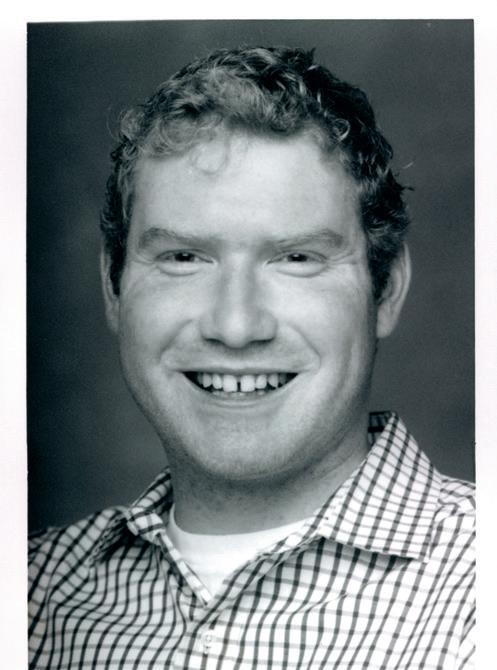
“ Dan impacted the lives of everyone who knew him and if you were blessed to be his friend, he changed your life. Dan was respected and beloved by all his students and their parents and the North Shore community. Dan was a strong advocate for the EDI work at North Shore and continued his commitment to these initiatives at Seattle Country Day School. Dan was always there to lift you up, or cheer you on—whatever you needed, Dan would be by your side.
“Dan taught me to see the joy in life— he encouraged me to travel to new places and experience new adventures. I am a better person because of Dan Sweeney and I know his legacy will live on in his students and those of us blessed to call him forever friend.”
noreen potempa , former faculty
“Dan’s presence always filled up a room because his heart was so big. The commitment and love he felt toward his students and the craft of teaching was deep and so very real. I know so many carry that with them, even though he is gone.”
winder holeman , Lower School Spanish Teacher
“As an educator, he taught me to unapologetically celebrate my own strengths, to take risks and to have fun. He challenged kids with his quick clip and quick wit— and over-the-top experiential learning.
Dan was at the center of our cohesive and innovative lower school teaching team, and students benefited from this positive and connected vibe. Dan was also gifted in communicating with a variety of constituents. Parents, colleagues, kids and administrators admired and respected him. He had a keen ability to know exactly what each needed from him and deliver it with compassionate, yet direct energy.”
annie gentithes , former faculty
“Dan was a natural—in the classroom, engaging with students, connecting with parents, partnering with colleagues— all the while seeing the big picture. He was particularly skilled in curriculum development—always creative, always purposeful. While a natural, Dan was never over reliant on his talent alone. Instead he ‘worked at it,’ always committed to giving his students and the school his very best.
“There was no doubt that Dan’s talent and commitment would translate well to administration—he was that skilled, that invested and that determined. Dan was a true difference-maker. All who came in contact with Dan were better for it.”
tom doar , former Head of School
“Dan was a wonderfully creative teacher. I especially remember the unit he did on Japan. He arranged the chairs in the room as if it were the inside of an airline and as students sat in them for their ”flight to Japan” they watched videos of the country and munched on Japanese snacks. It was the beginning of a marvelous unit which his students probably still remember today. Dan was a caring and kind teacher. He loved to travel and used new experiences to enhance the curriculum.
“Cooking was a passion for Dan. One morning he came into my office and asked if I thought he could do a Morning Ex on cooking. It seemed a great idea. He involved the fourth graders and put on a great cooking show for the whole school— the first of its kind. We all got copies of his great recipes.
“Dan was a quick learner. He came into the lower school as an assistant teacher but soon after became a head teacher. I enjoyed our conversations on education both in and out of school. Dan was a skilled and treasured colleague with such a big heart. It is hard for me to think of his passing, but I take comfort in all the lives he has touched—the children, now adults, who travel, read, problem solve, cook and embrace new opportunities to the full because of their teacher Dan Sweeney.”
pam whalley , former Head of Lower School
in memoriam 48
gail wirtz costello ’72
I always chuckle with the term “lifer”— applied to those of us who attended the full JK/SK-12th grades at NSCD. North Shore is an environment that, over a 14 year period, shapes and molds a child into a young adult. North Shore went through different periods. During my time at North Shore, the arts were its strength.
North Shore is where I grew into the artist, teacher, art therapist and founder of a nonprofit agency called Artistic Healings (artistichealings.com). North Shore’s curriculum may have changed over the years, but its overall philosophy has stayed the same: “Live and Serve.” The concepts of family, giving back and thinking outside the box were molded into us as we grew, year after year. The annual Work Day was always a favorite because we got to share raking leaves and cleaning up the school with another class older than us. Arts week was an entire week where geodesic domes were constructed on the lawn.
We all have favorite teachers, but the opportunity to have one teacher in the arts for multiple years was one of the greatest gifts I could ask for. Jane Dalton was my inspiration and greatest gift. She was my art teacher from first grade through high school. Although she was supposed to teach first through eighth, North Shore’s greatest asset was flexibility. She allowed Stephie Schmitt Packard ’72 and me to continue our interest in ceramics through high school. She believed the best way to learn something was to teach it. So, that is what she had us do. We taught those younger than us to work with clay— teaching pottery, the potter’s wheel and even built a Raku kiln.
For better or for worse, the process of teaching something to learn it, is a pattern I have repeated throughout my life. While
teaching graduate art therapy at the University of Illinois, the director of my program asked me to teach graduate grant writing. She never asked if I had ever written a grant (I hadn’t). I quickly went to the grant writing department who also taught me an important lesson. “If you can’t hold the reader’s interest in the first three sentences, they will move on to the next grant.” Writing succinctly, clearly, simply, was something I never learned in any of my educational programs. I learned it through teaching grant writing.
Building Raku kilns was another fun adventure which sparked my interest when I was in grade school with Jane Dalton. Once again, “If you want to learn something, teach it.” With little to no knowledge, I taught eighth graders to build a Raku kiln while doing my internship in my graduate program to learn to teach K-8. The concept of containing heat, to raise a temperature quickly without shattering the item inside, was a teachable moment. I called Jane and she helped me learn the names of the bricks and burner I needed. Jane became a long term mentor for me as a teacher and friend. I visited her ceramic studio in Deerfield and saw what you needed to set up a work space and make art.
During the late 1990s the term “pay it forward” became a household phrase. This concept was built into North Shore’s core. The teachers taught us to live out this saying through their role modeling. Paying it forward is something I continue. Paying it forward takes creativity to figure out how to integrate knowledge into the future. Teaching creativity was North Shore at its finest. The art teachers all the way from kindergarten through high school were phenomenal.

After I finished graduate school, I looked back to North Shore for work. How many schools would hire a full-time art teacher to teach art to the kindergartners (first and third grades also)? This is what North Shore did for them and me. After graduating with my Master in Education, the 4- and 5-year-olds had their own art teacher. This was the beginning of my study to examine 4- to 7-year-old art, which enabled me to become an expert in creative development. I went on to study normal versus abnormal development and moved to New York, where I attended Pratt Institute and earned a master’s degree in art therapy, specializing in helping children and their families navigate through emotional issues using the paint, clay, collages etc.
I can’t imagine another school that offered the opportunity to be part of a family the way North Shore did. The JK-12 opportunity was a gift. There were always students older and younger than you. The 4- and 5-year-olds sitting on the laps of the seniors was as big a treat for the kindergartners as it was for the seniors.
All five of my siblings were lifers at NSCD, but my sister Karey Wirtz Fix ’76 also went back to North Shore and taught there. I know many others like Nancy Green Whiteman ’71, have given many years to supporting the school.
In conclusion, all of my strengths as a professional come from the school that molded me in the arts—North Shore Country Day. I am thankful that I was afforded the opportunity to learn that living and serving is a gift that keeps giving through a lifetime.

alumni reflection
North Shore is where I grew into the artist, teacher, art therapist and founder of a nonprofit agency.
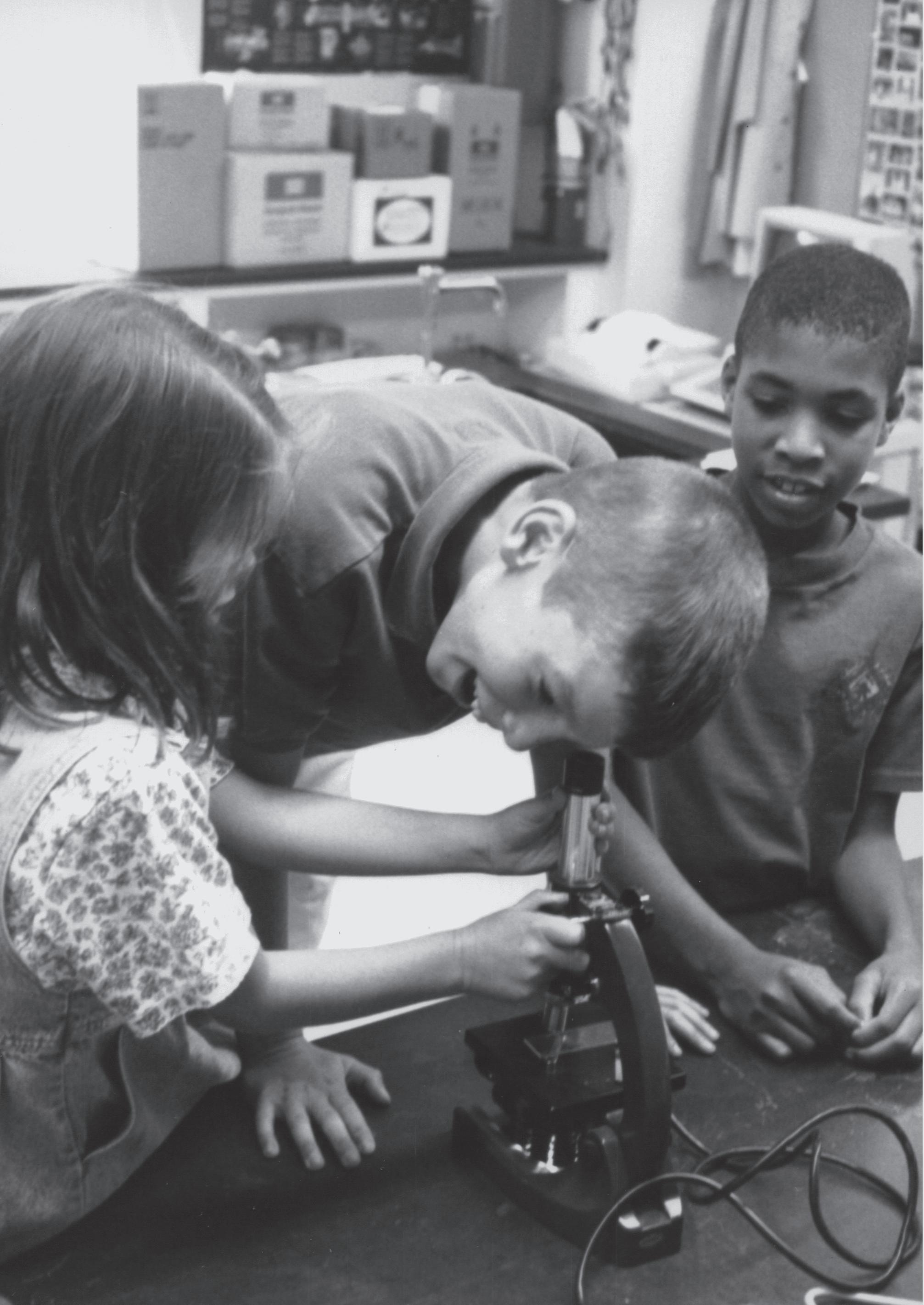
Non-Profit Organization U.S. Postage PAID Permit #2026 Northbrook, IL






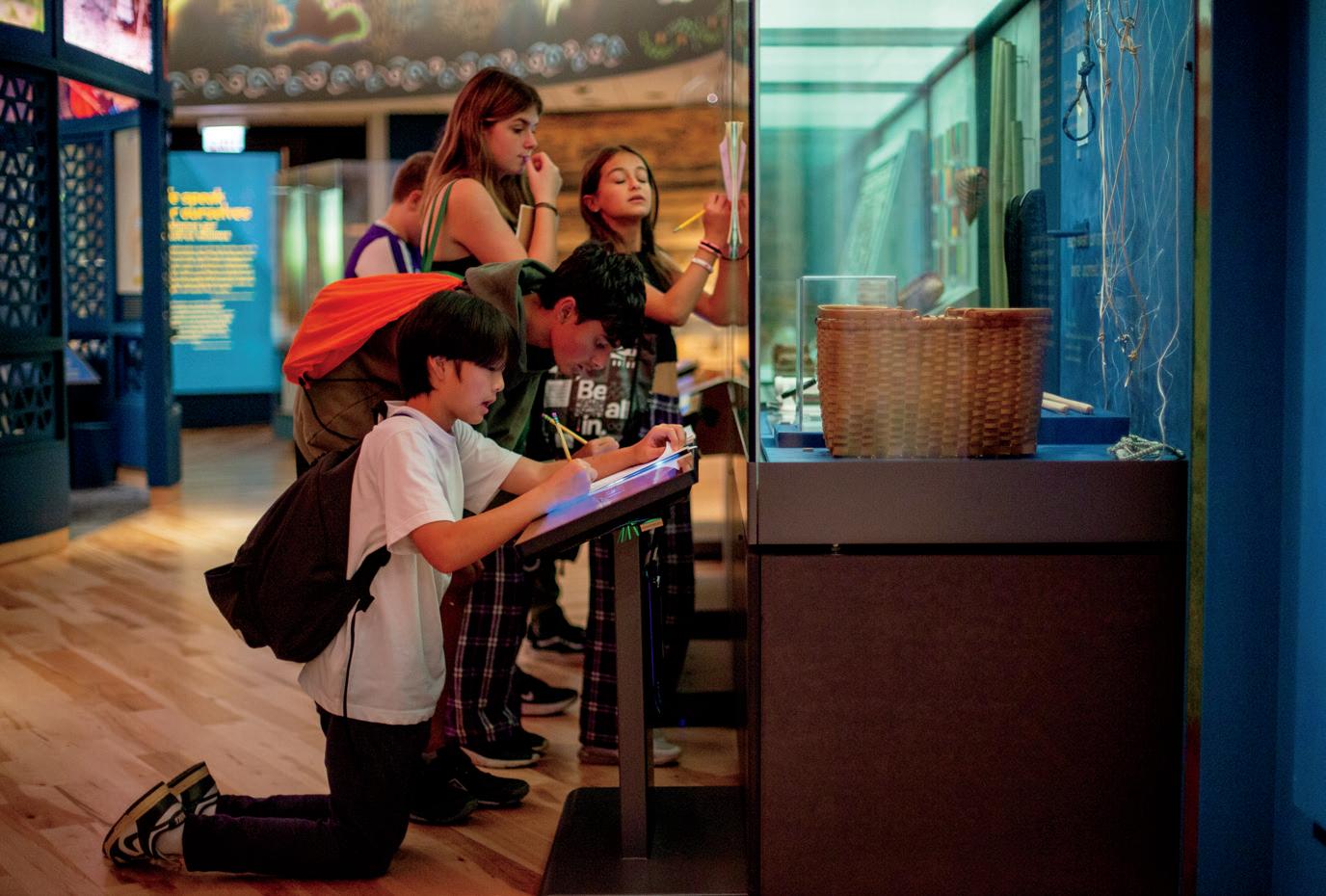

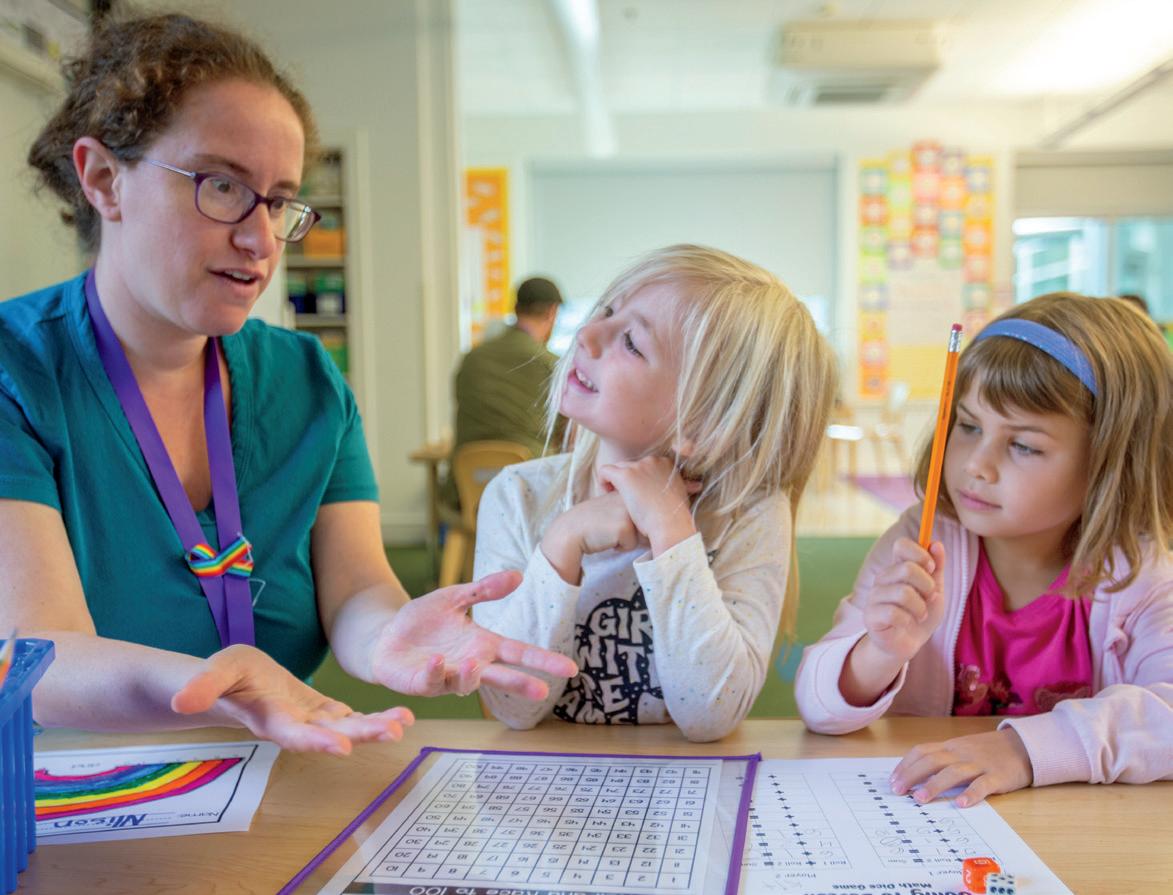




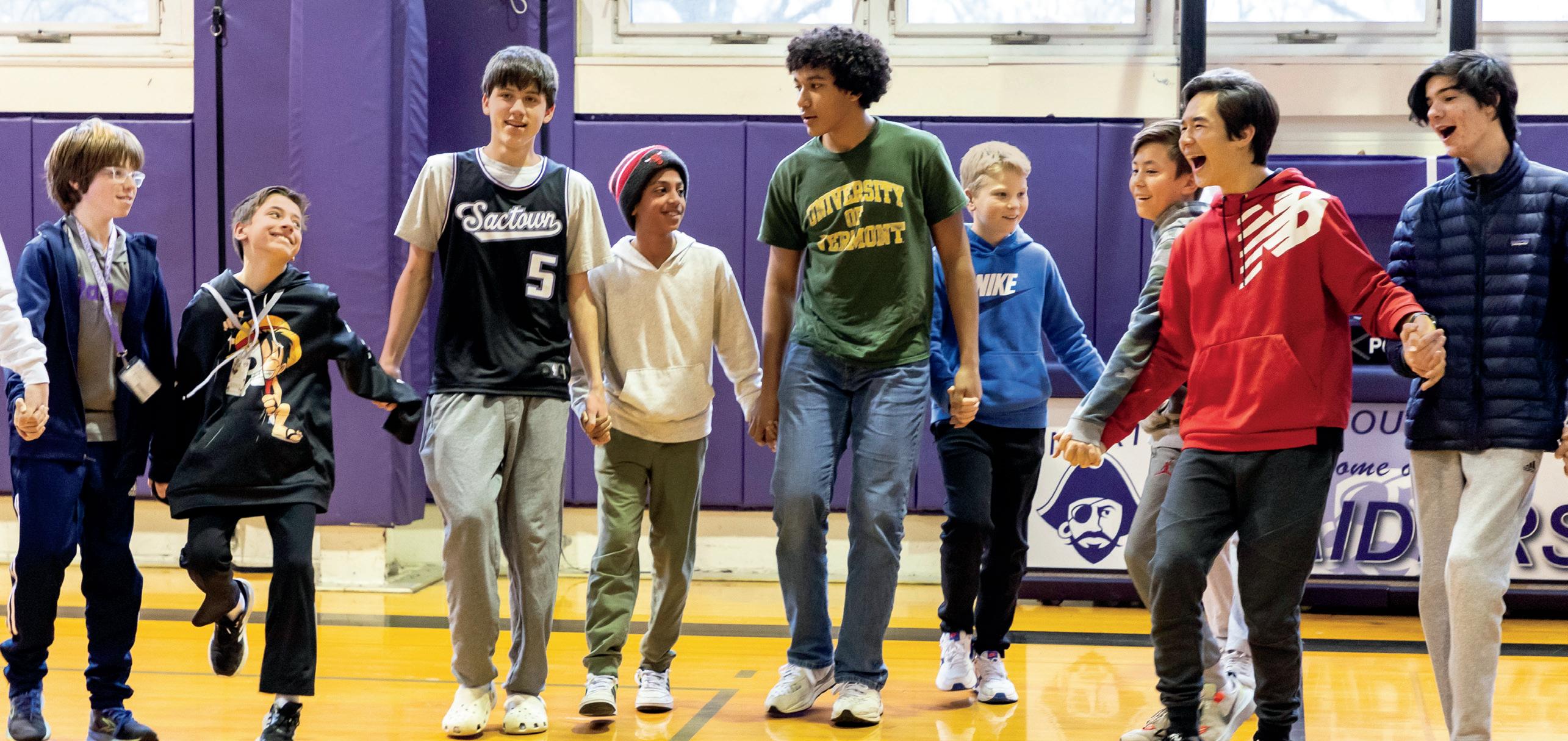
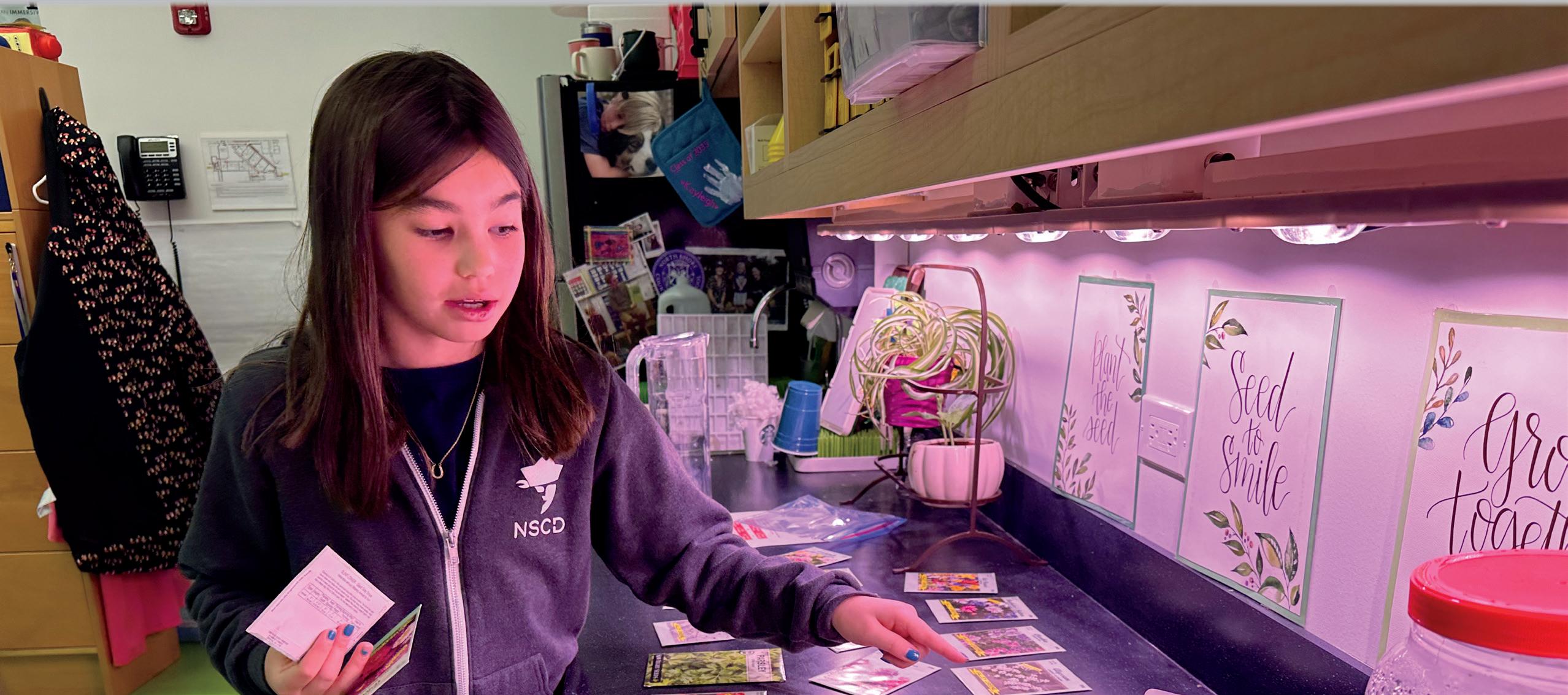

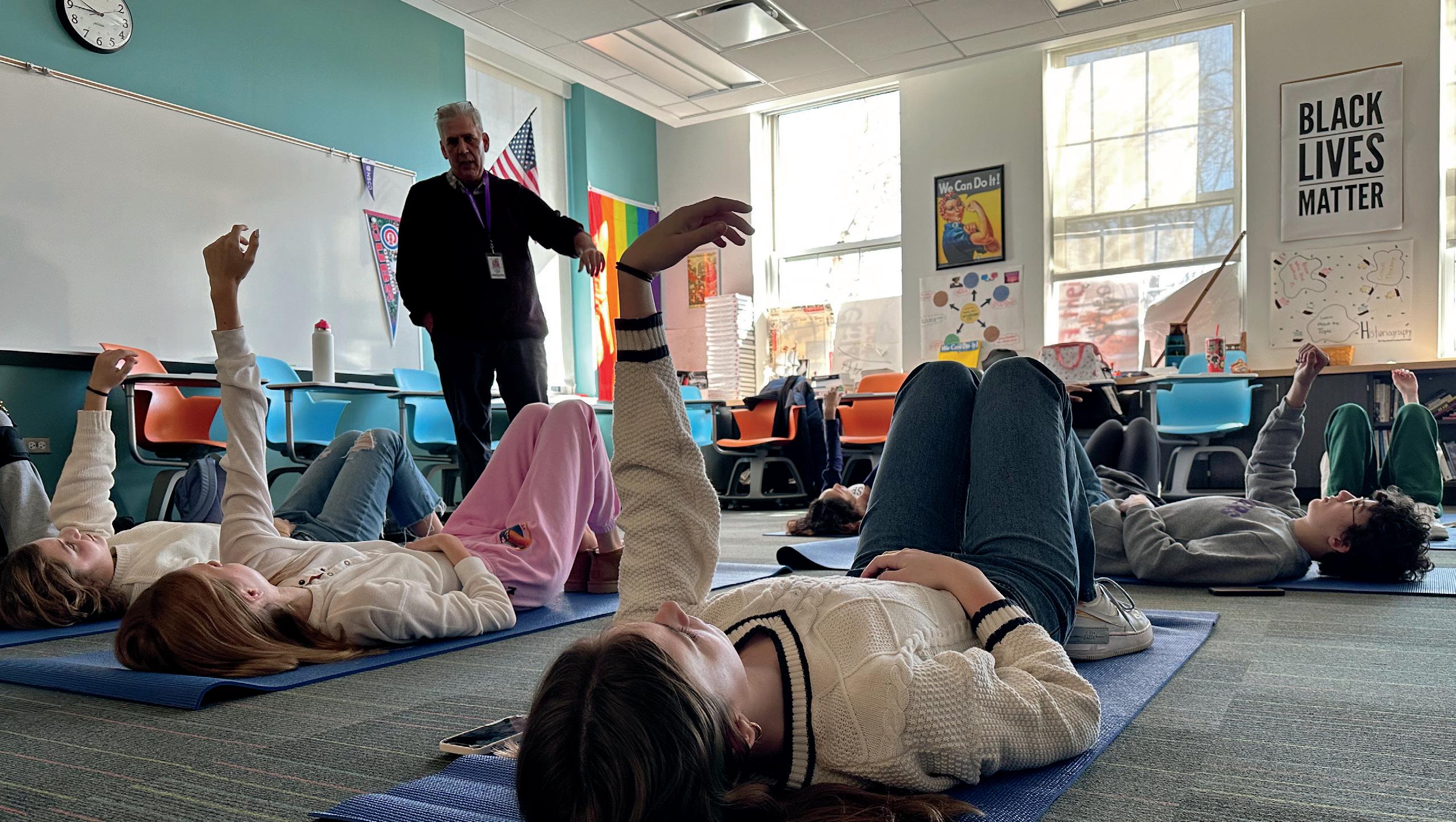






































 Jonathan Strong ’62
Joel de la Fuente ’87, Susie Brew Schreiber ’58, Tom Geraghty ’62 and Jonathan Strong ’62
Jonathan Strong ’62 with seventh grade humanities students
Jonathan Strong ’62
Joel de la Fuente ’87, Susie Brew Schreiber ’58, Tom Geraghty ’62 and Jonathan Strong ’62
Jonathan Strong ’62 with seventh grade humanities students





















 MATH DEPARTMENT HEAD, MIDDLE AND UPPER SCHOOL MATH TEACHER
MATH DEPARTMENT HEAD, MIDDLE AND UPPER SCHOOL MATH TEACHER







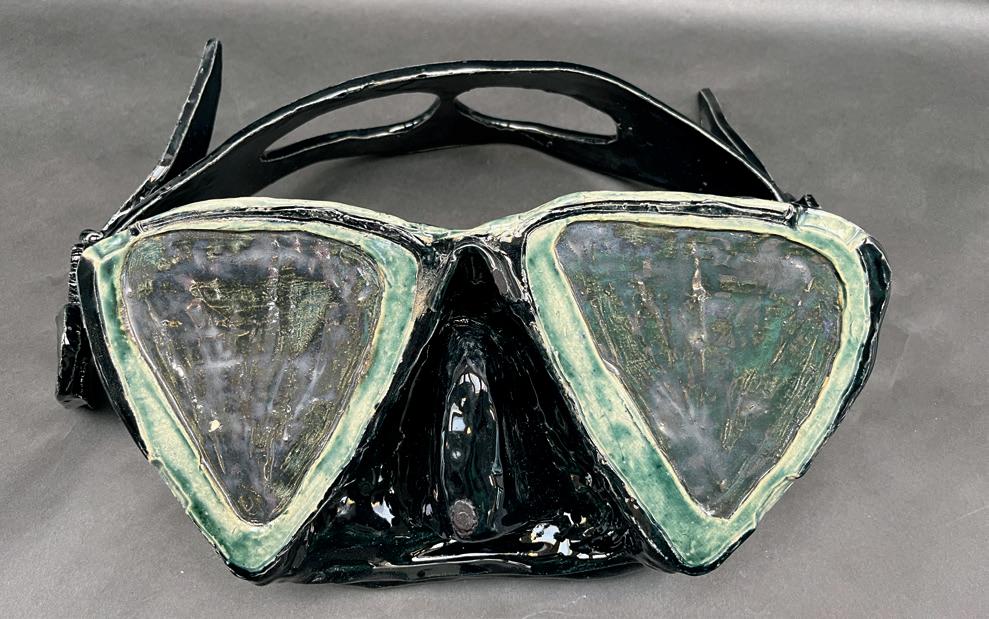




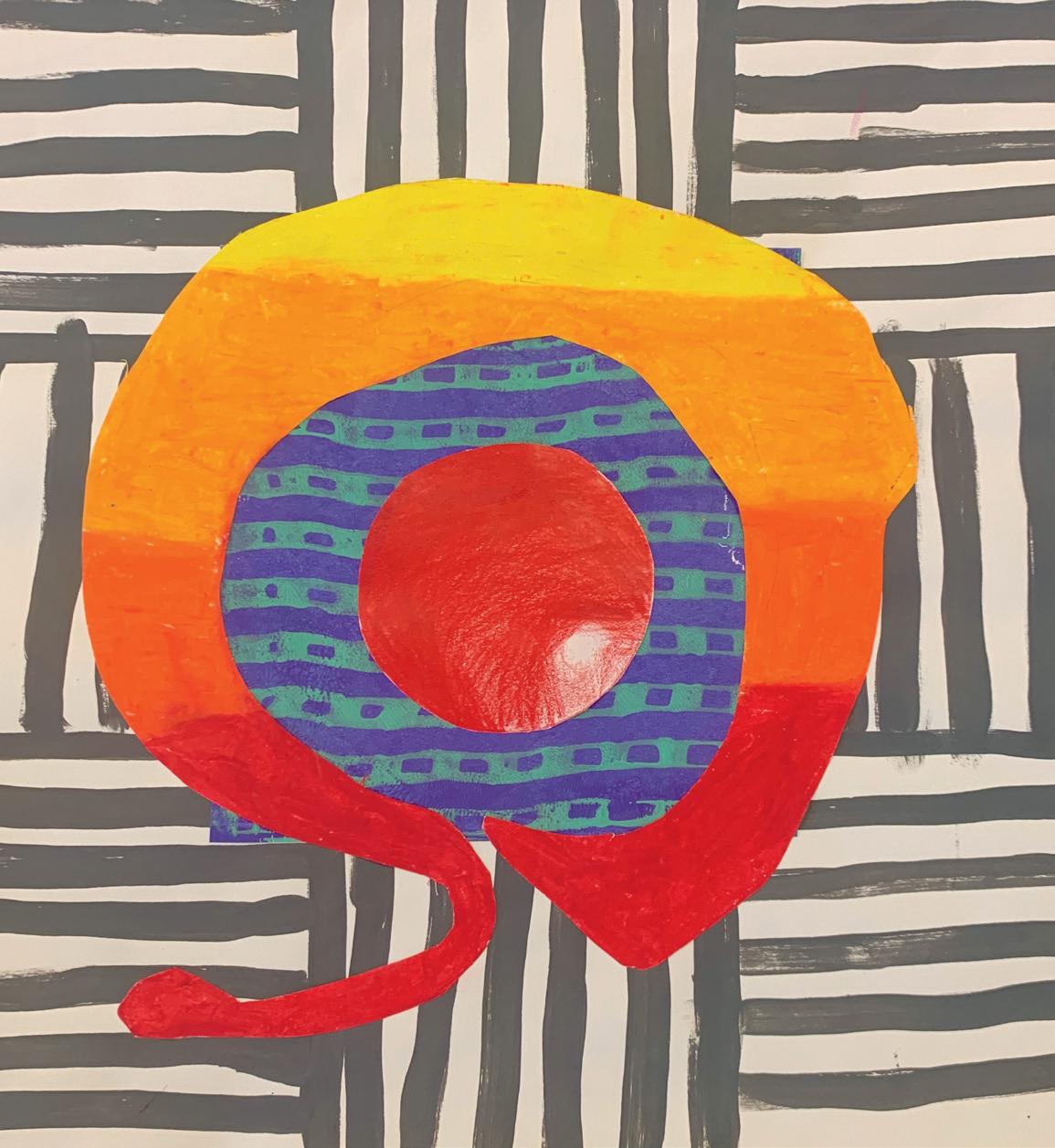
 Majed Tabbara ’24
Virginia Ver Eecke ’32
Rory Dubow ’29
Ishana Iyer ’28
Payne Wood ’30
Carly Lissner ’25
Izzy Henry ’25
Morgan Gallagher ’26
Majed Tabbara ’24
Virginia Ver Eecke ’32
Rory Dubow ’29
Ishana Iyer ’28
Payne Wood ’30
Carly Lissner ’25
Izzy Henry ’25
Morgan Gallagher ’26



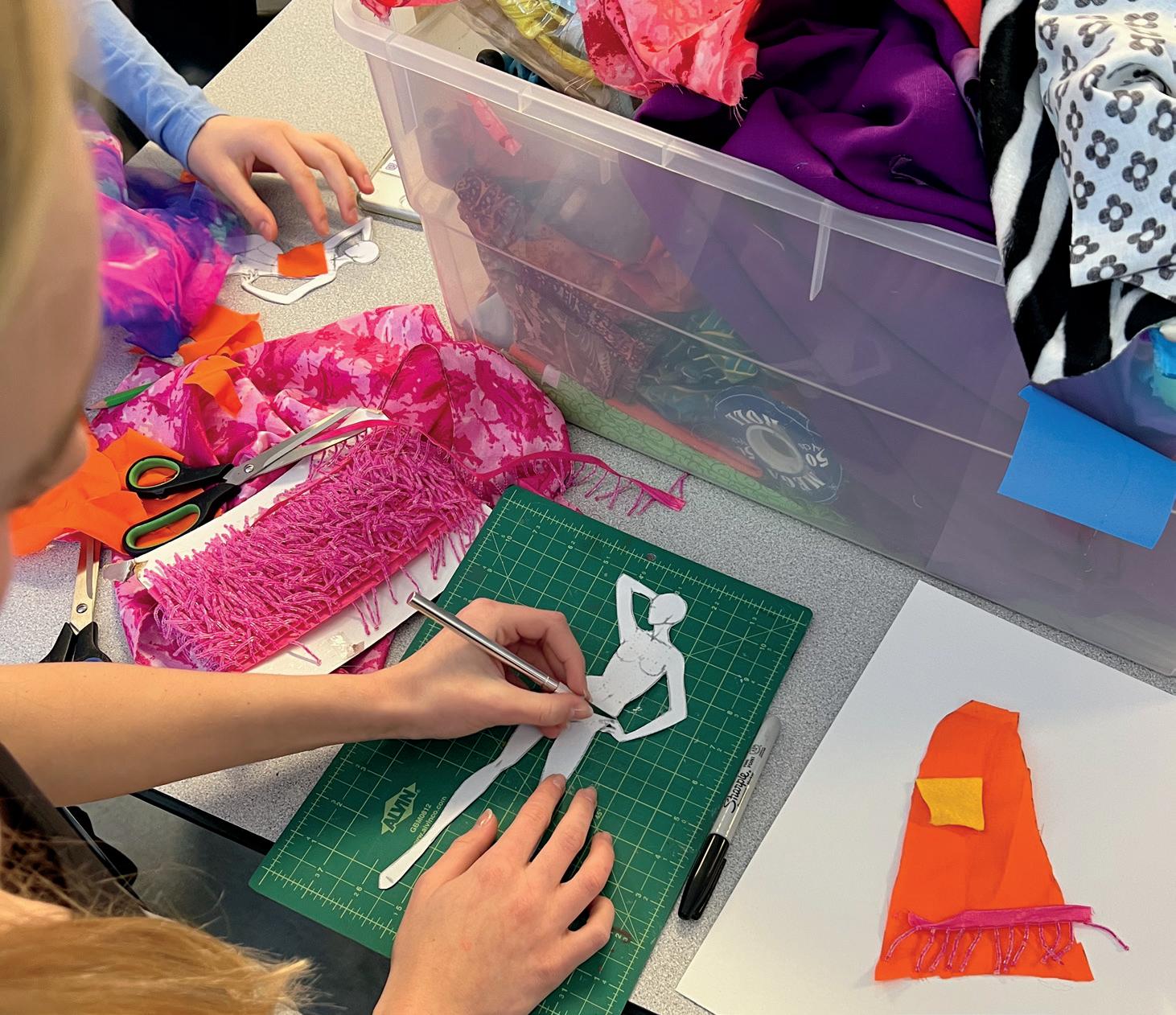


 Cooper Erwin ’26
Brendan Montgomery ’29
Liam Yekelchik ’34
Leena Johnson ’31
Natalie Kao ’33
Colin Wiercinski ’27
Pratyay Rao ’27
Cooper Erwin ’26
Brendan Montgomery ’29
Liam Yekelchik ’34
Leena Johnson ’31
Natalie Kao ’33
Colin Wiercinski ’27
Pratyay Rao ’27
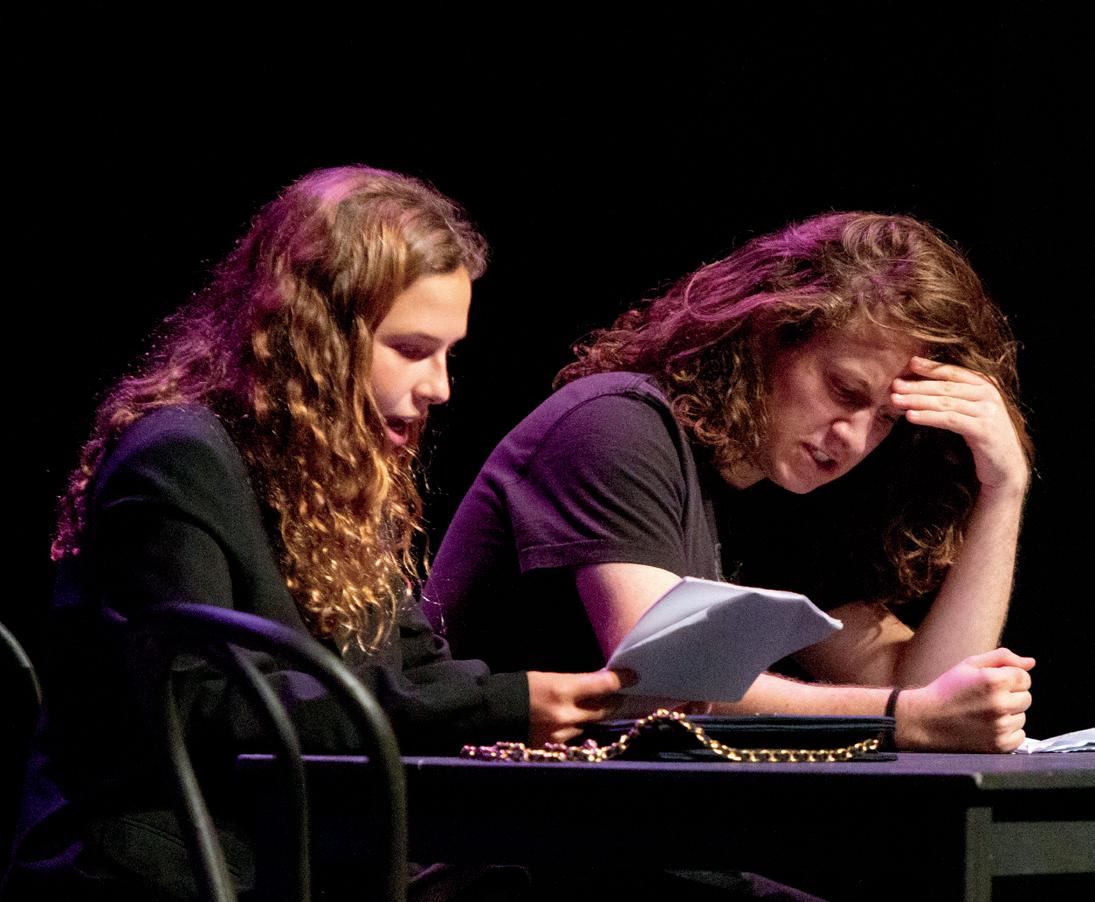
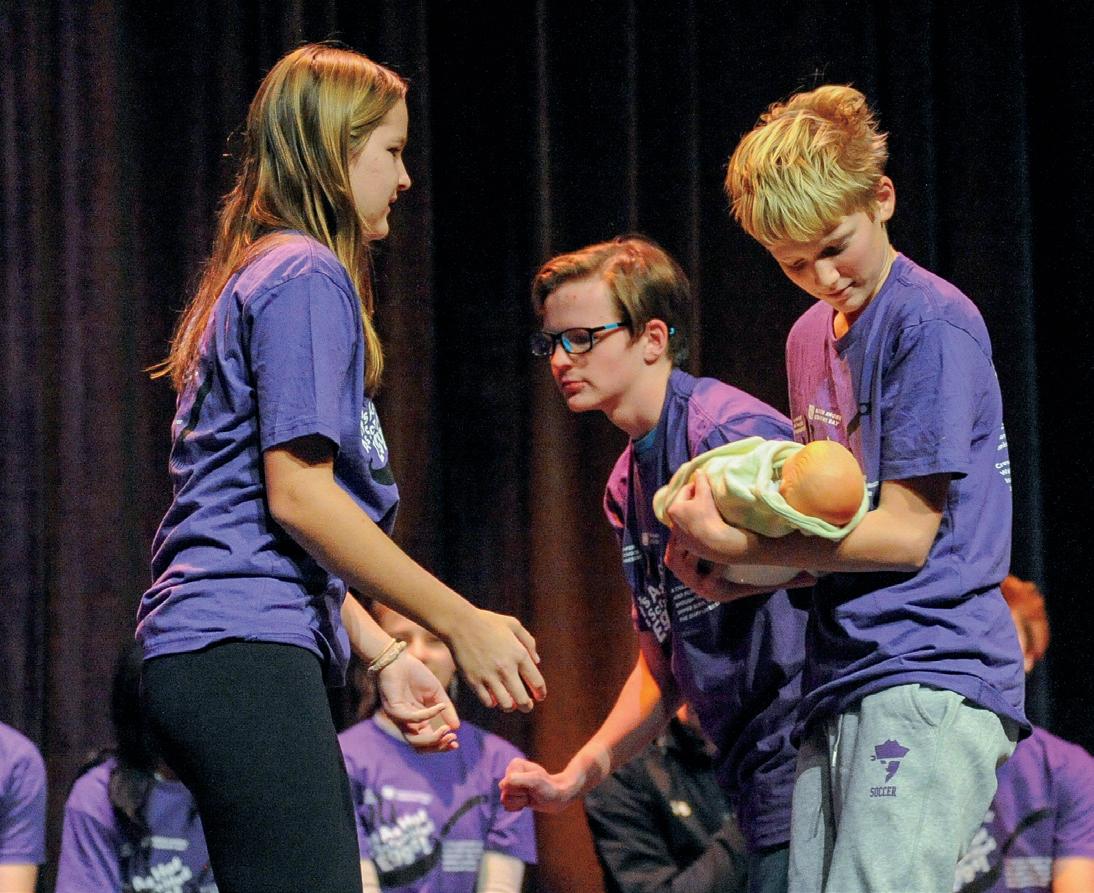

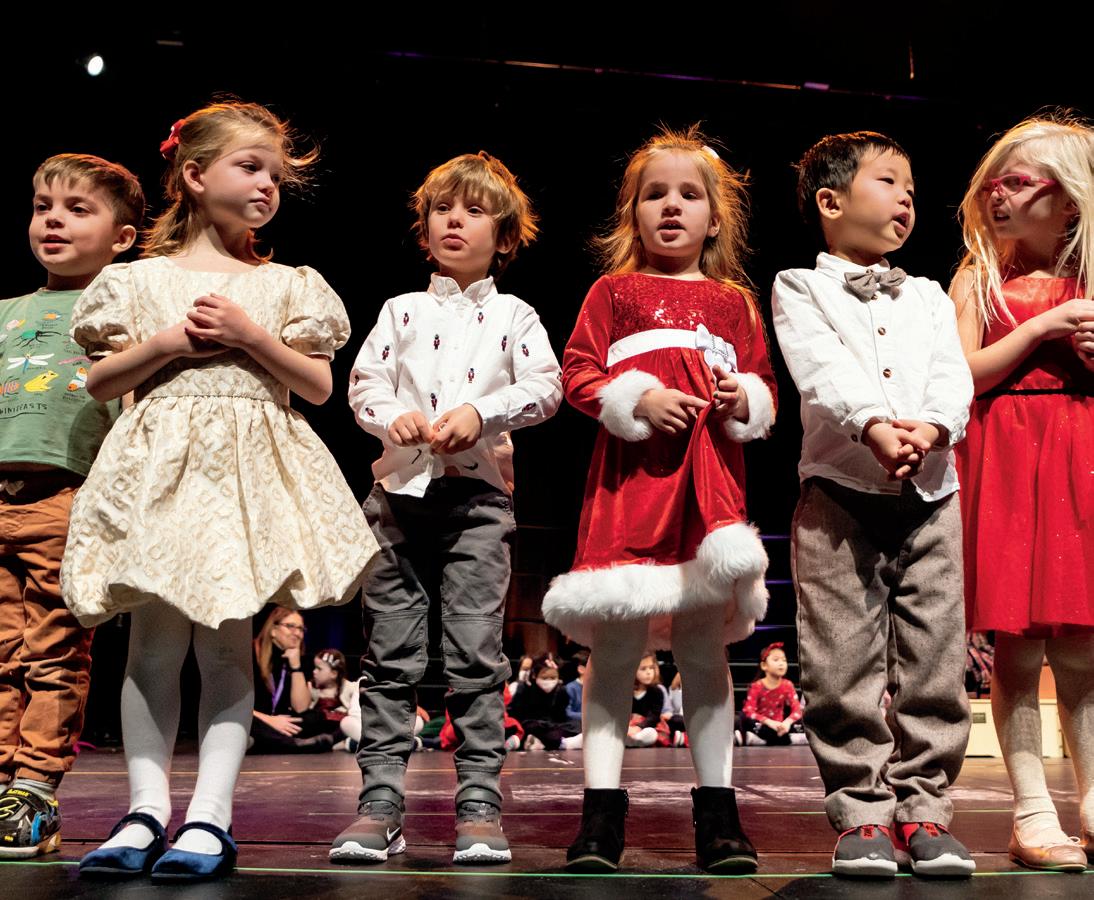
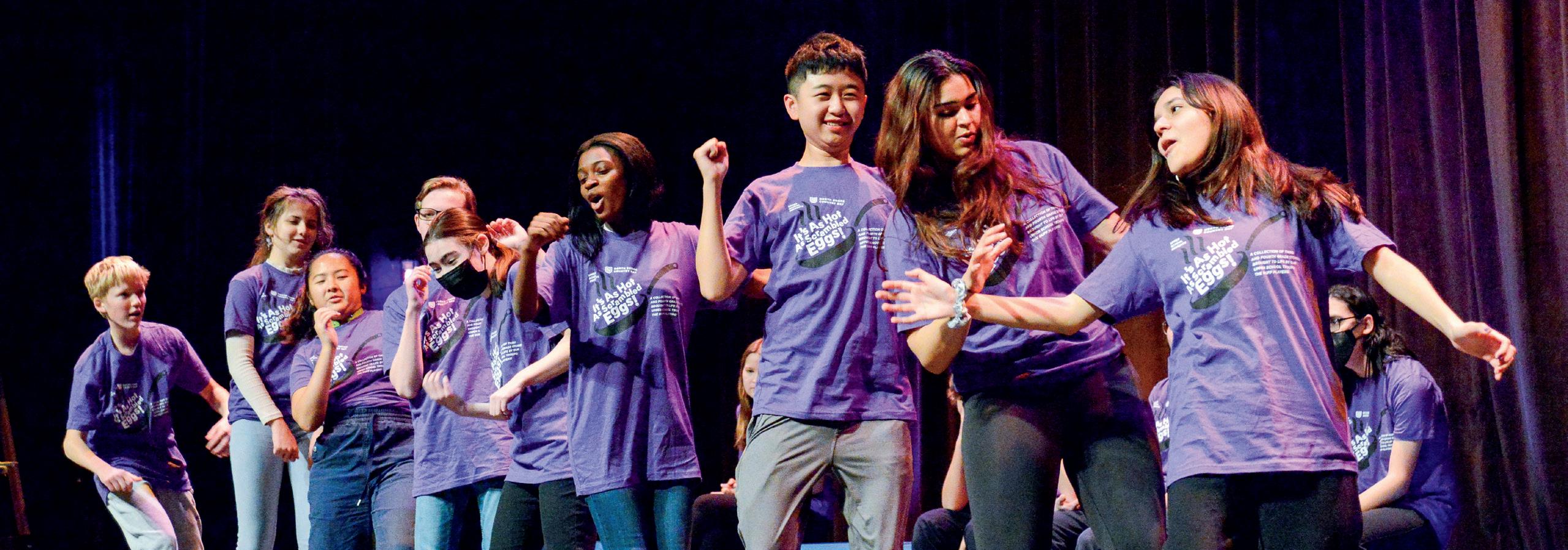
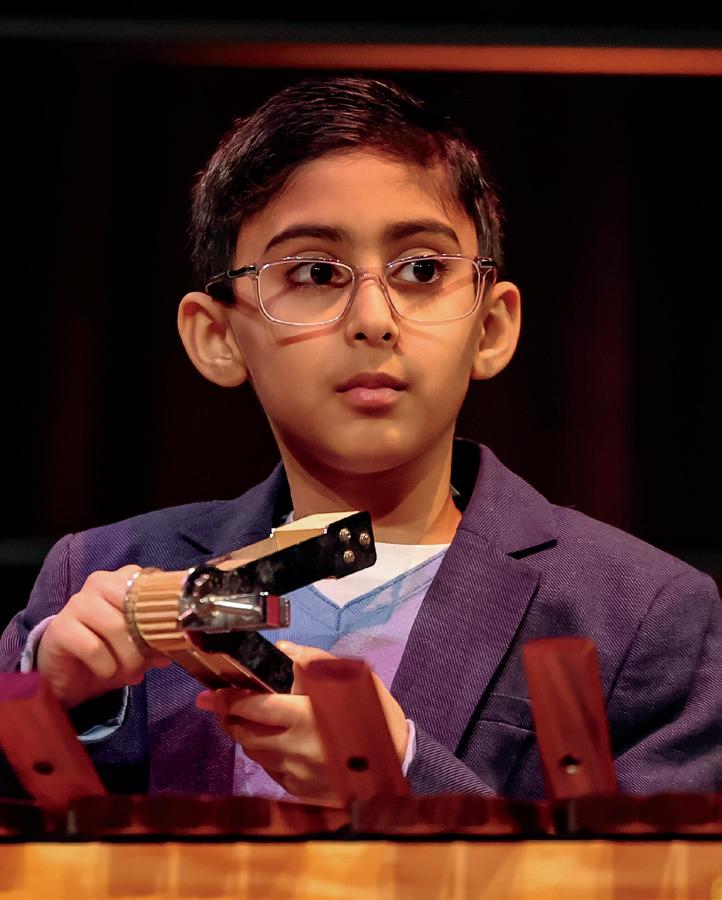

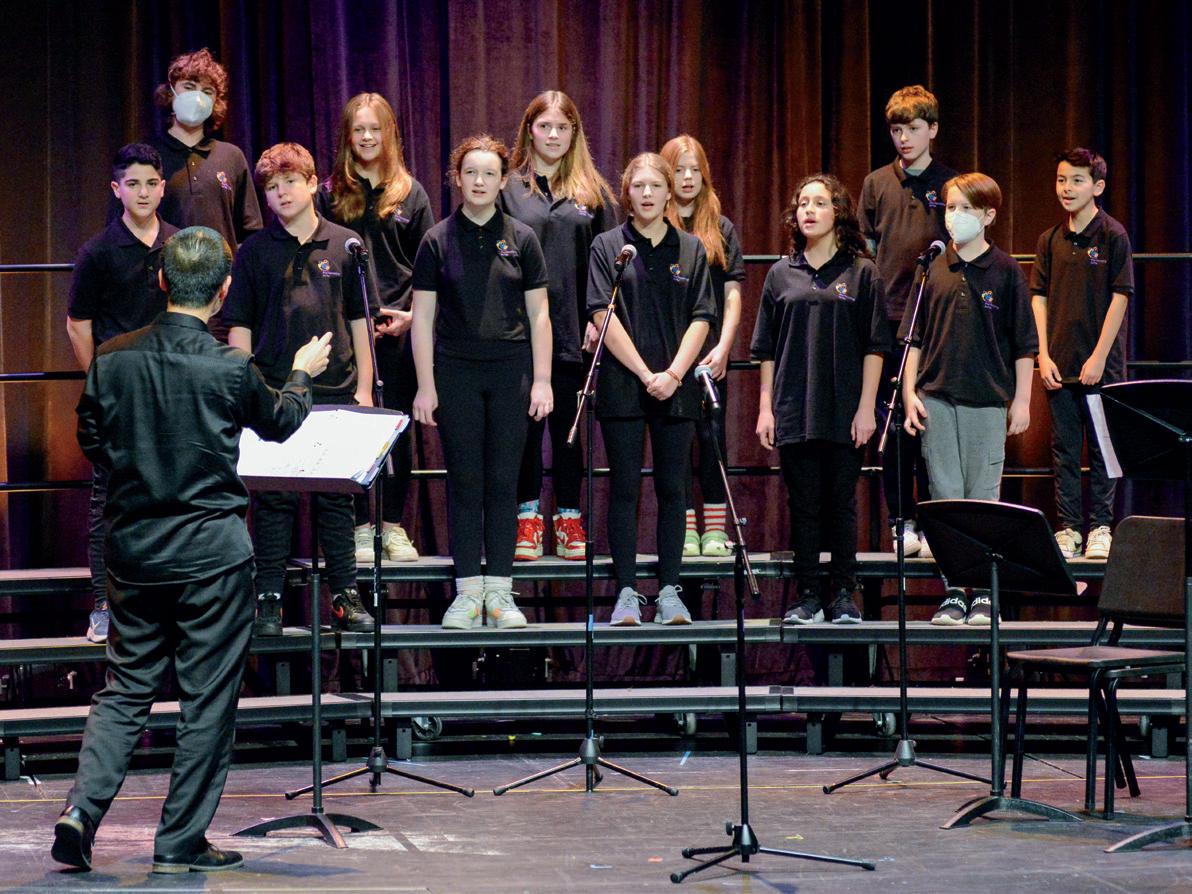
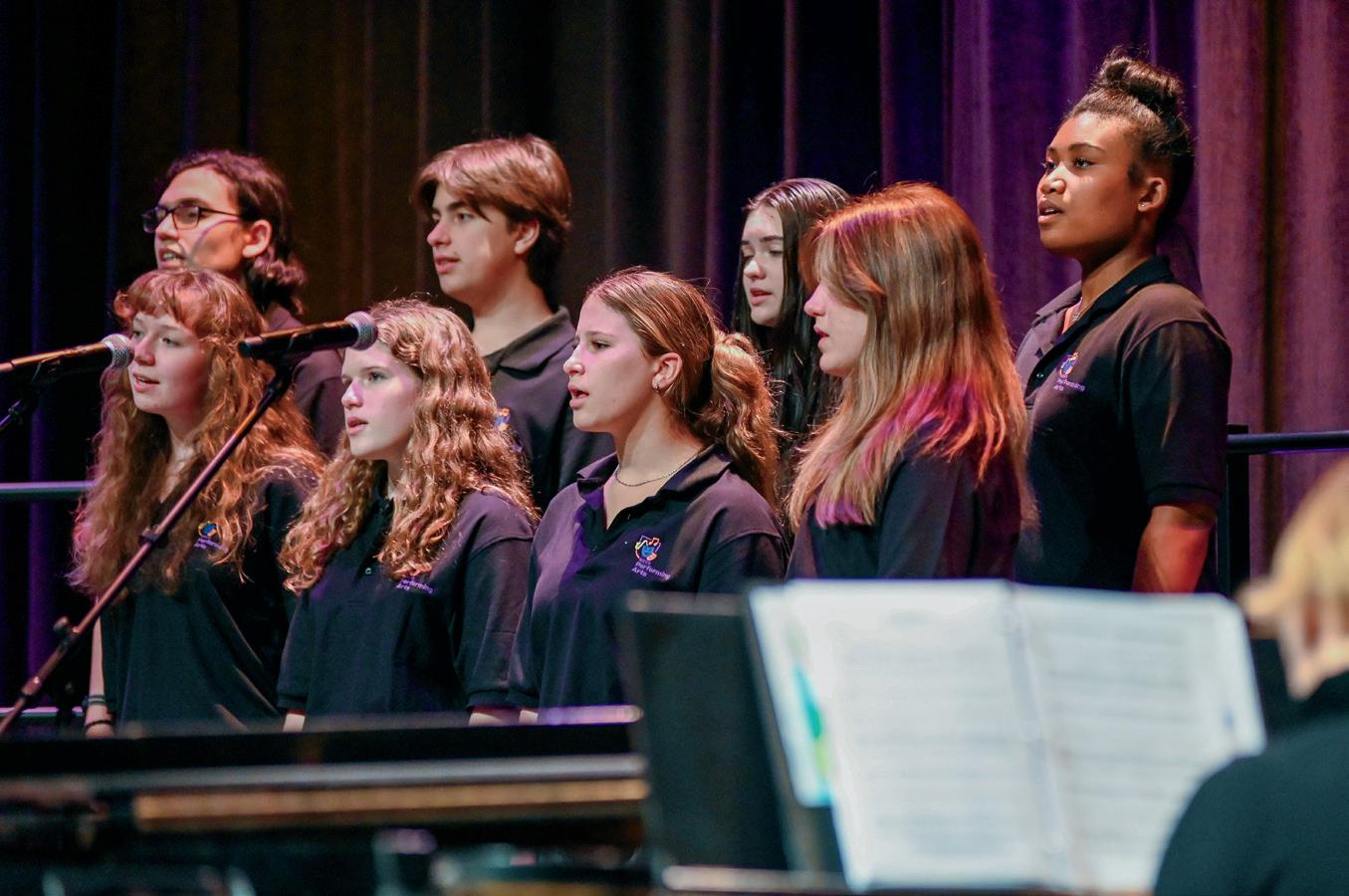




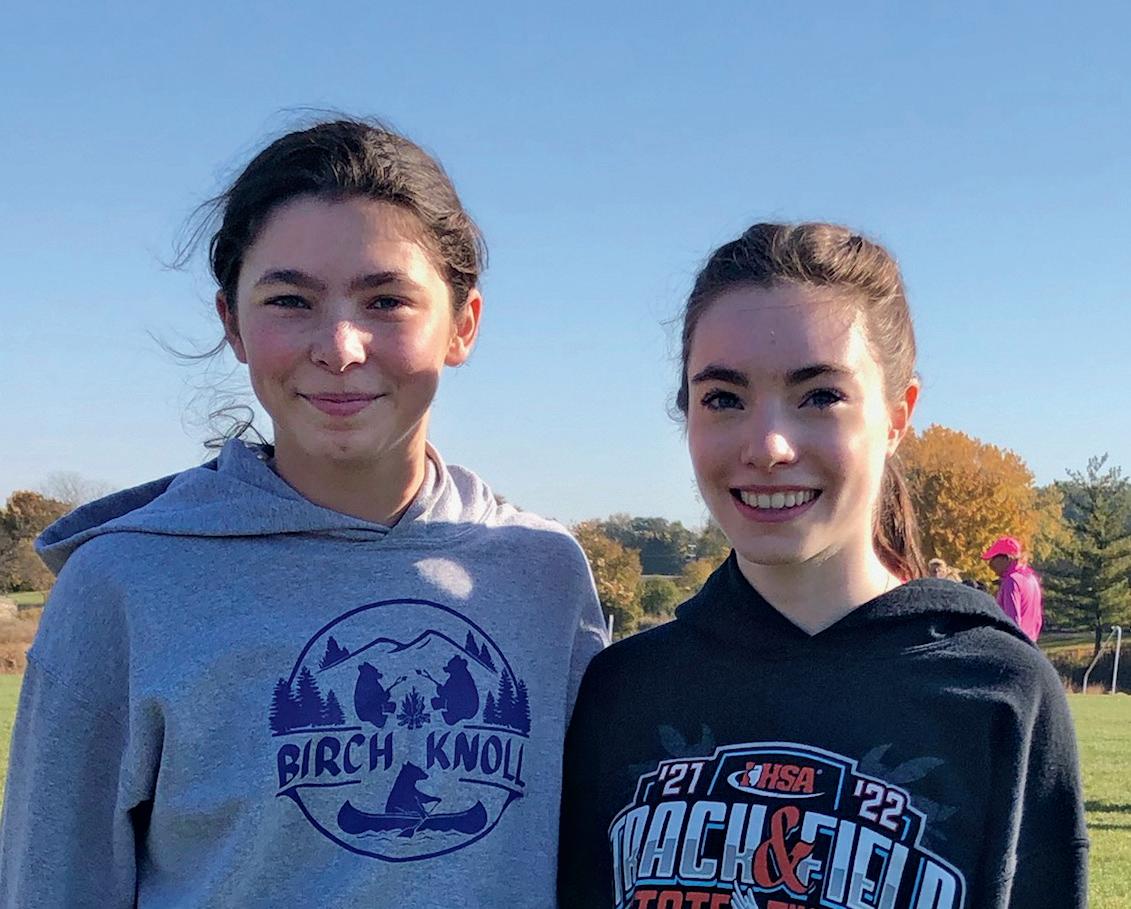

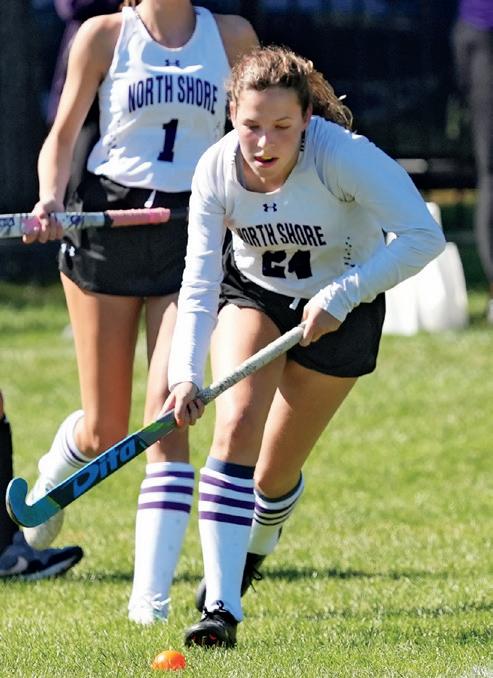




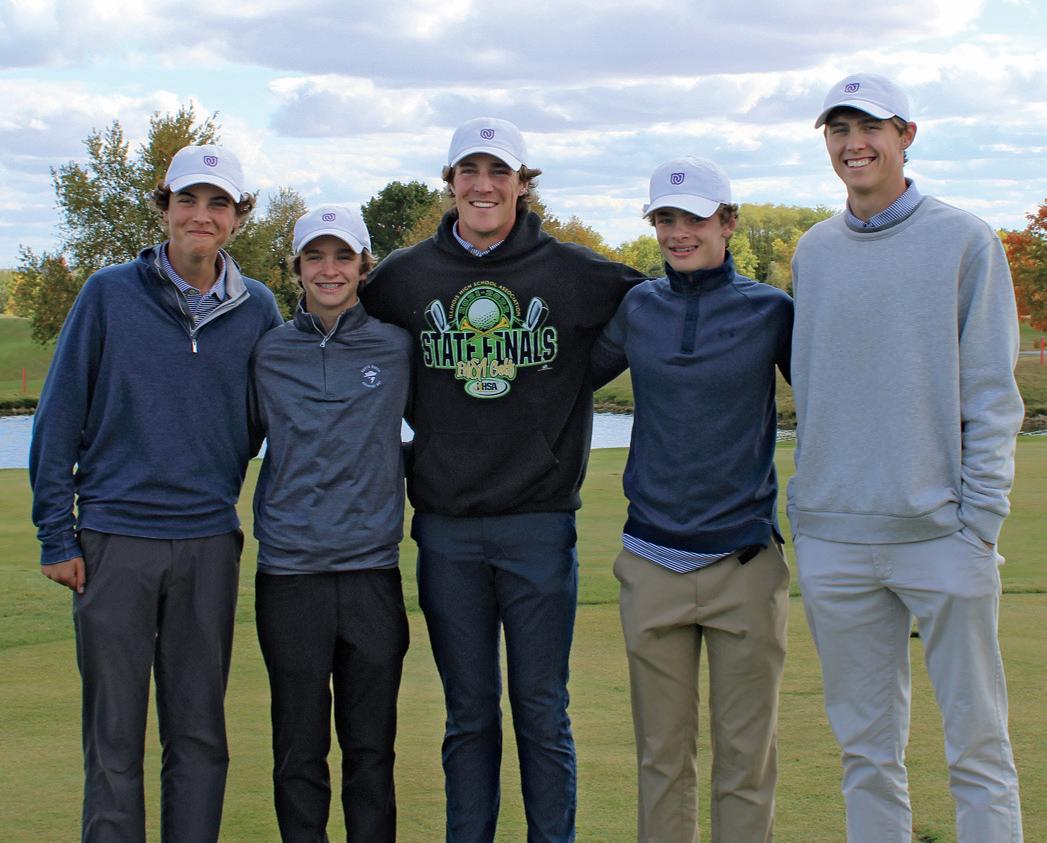
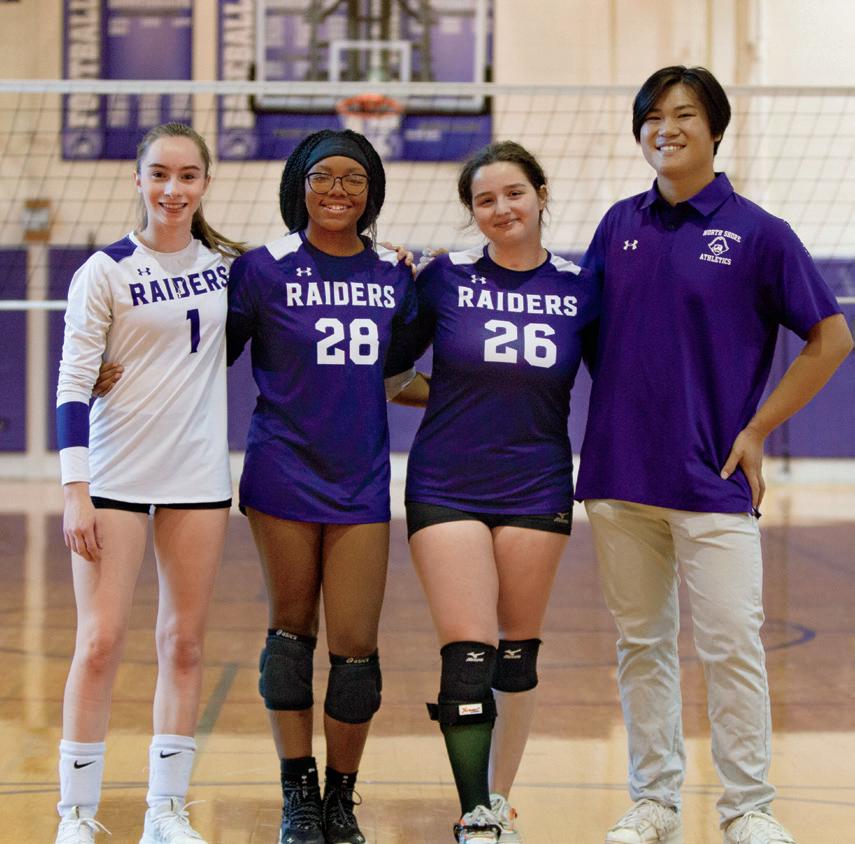


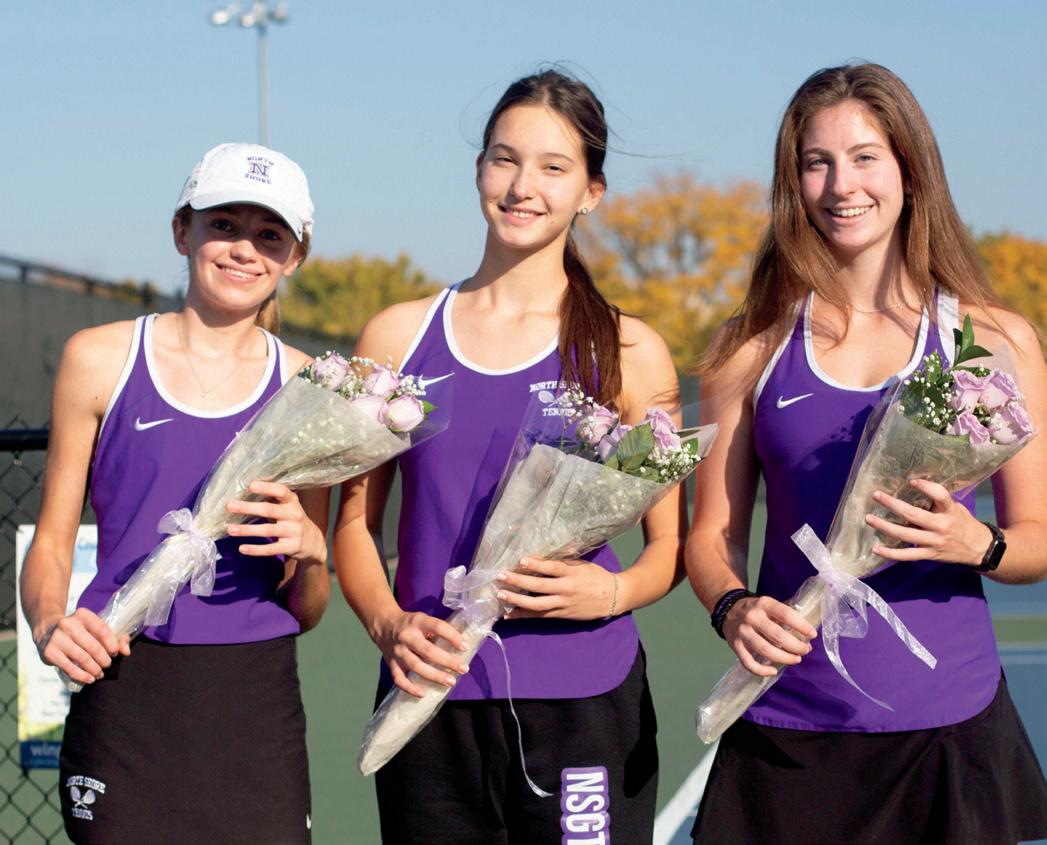





 Boys Golf
Nolan Darnieder ’25, Tucker Sichol ’26, Hugo Hourihane ’23, Jonathan Wiggins ’25 and Robbie Black ’23
Zara Omar ’26, Anoushka Mitra ’24, Emi Comeau ’24 and Tessa Adamson-Tate ’24
Alicia Isasi ’23, Meonda Collins ’23, Sophie Green ’23 and Ethan Cheng
Boys Soccer
Penrose Bigelow ’23, Iva Burick ’23 and Dani Savin ’23
Teddy Gallun ’23
Leif Steele ’24
Henry Gallun ’25
Sophie Green ’23
Dani Savin ’23
Kate Henry ’24
Boys Golf
Nolan Darnieder ’25, Tucker Sichol ’26, Hugo Hourihane ’23, Jonathan Wiggins ’25 and Robbie Black ’23
Zara Omar ’26, Anoushka Mitra ’24, Emi Comeau ’24 and Tessa Adamson-Tate ’24
Alicia Isasi ’23, Meonda Collins ’23, Sophie Green ’23 and Ethan Cheng
Boys Soccer
Penrose Bigelow ’23, Iva Burick ’23 and Dani Savin ’23
Teddy Gallun ’23
Leif Steele ’24
Henry Gallun ’25
Sophie Green ’23
Dani Savin ’23
Kate Henry ’24



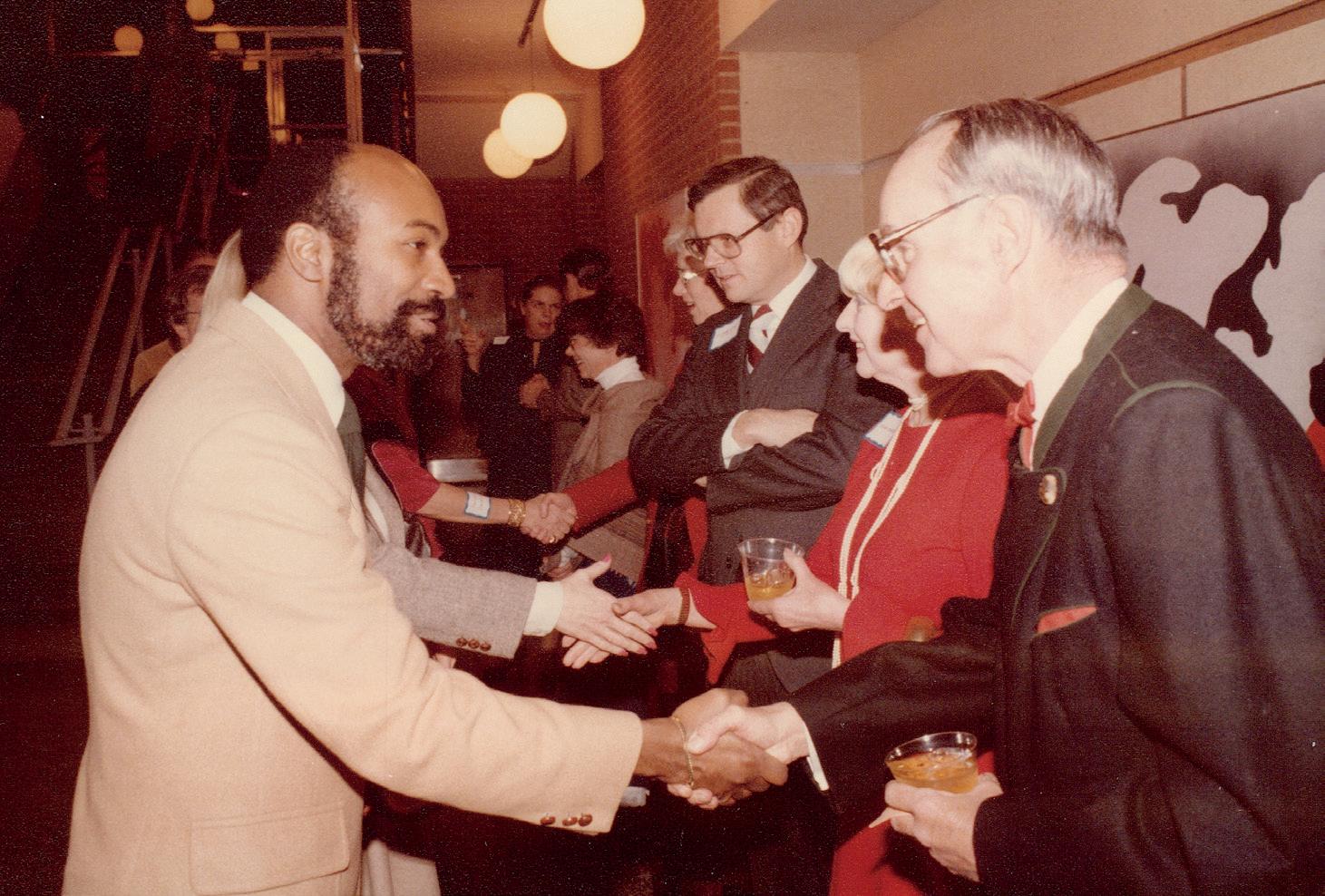

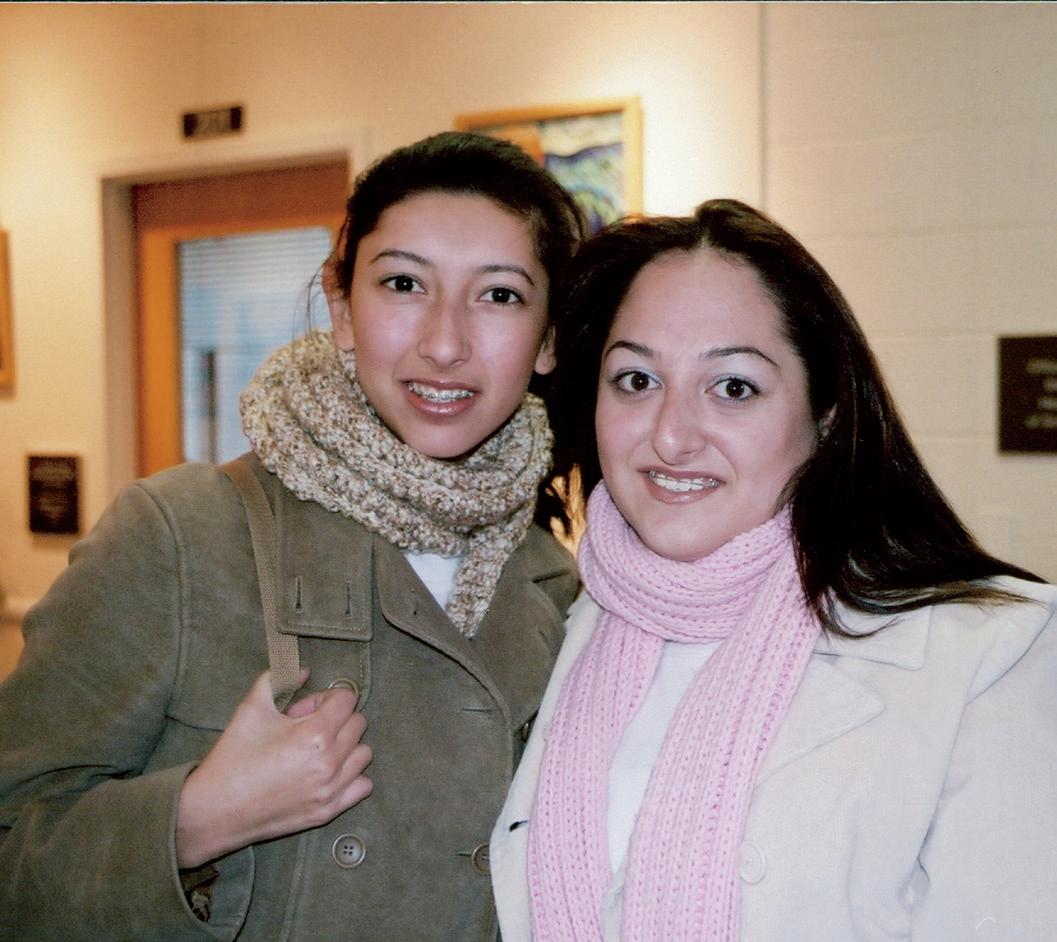


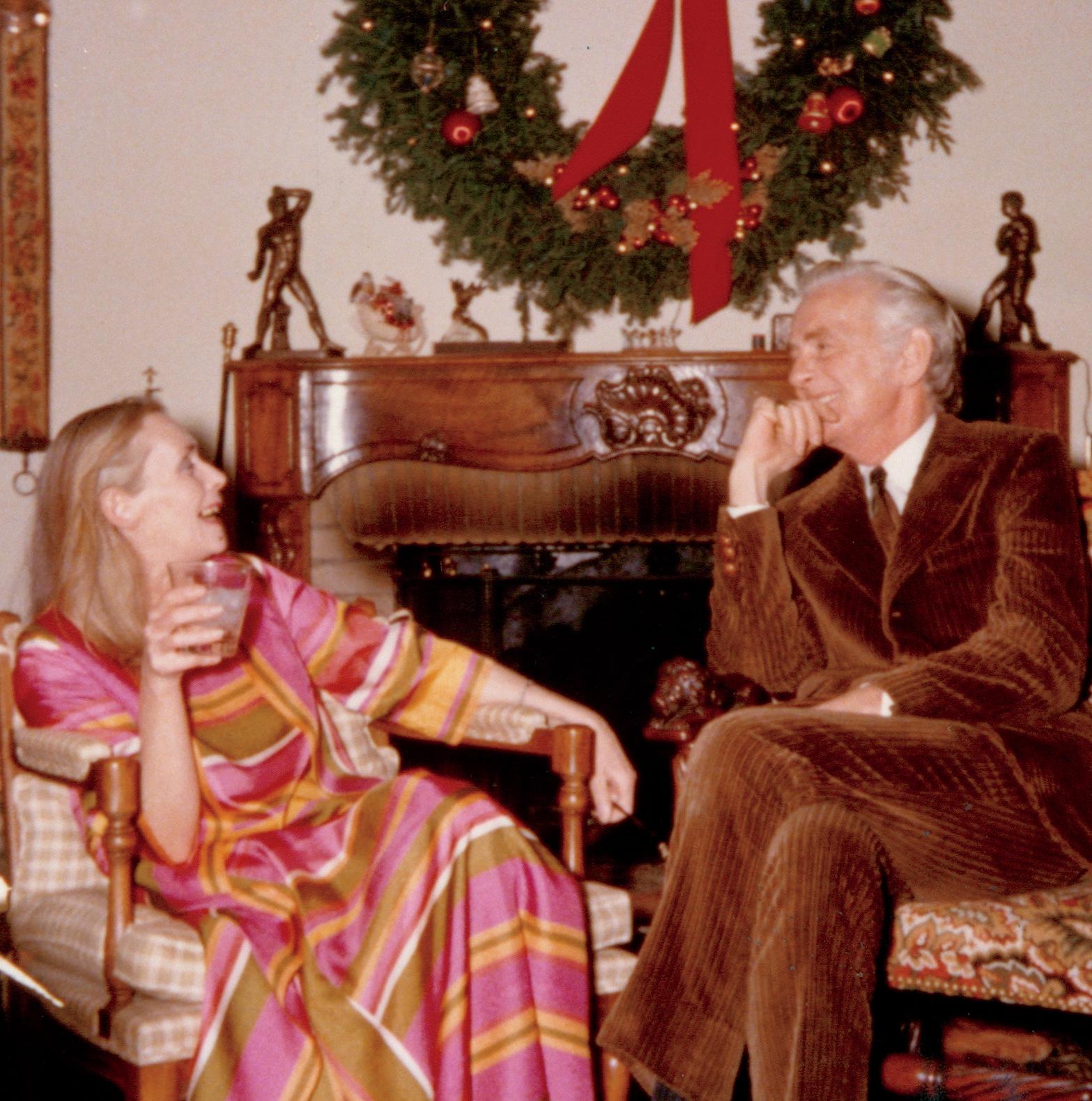

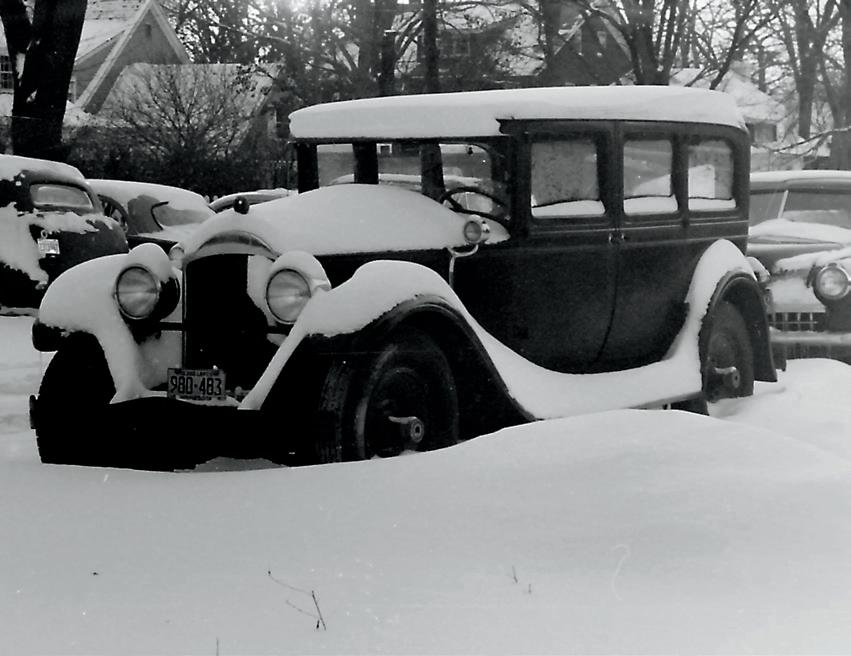
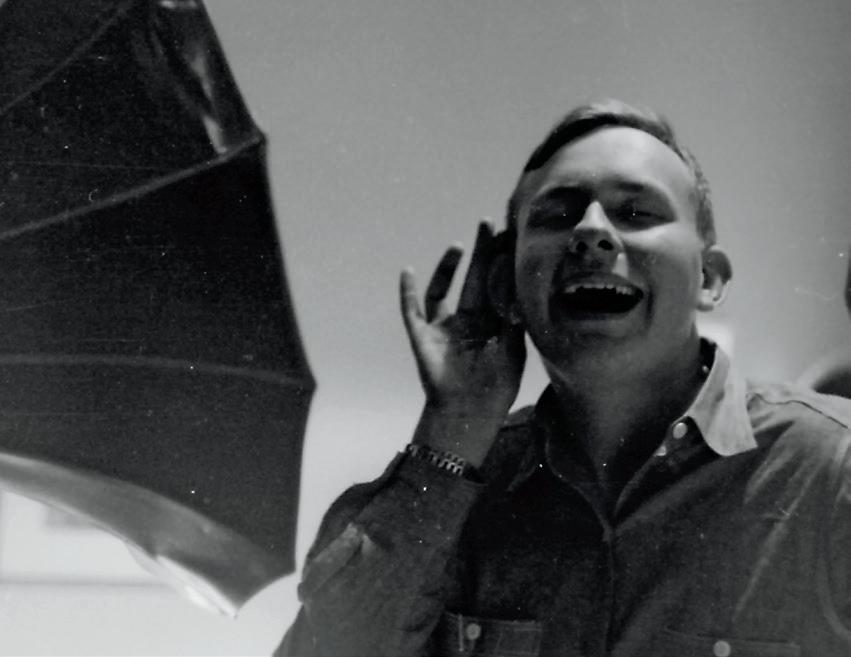

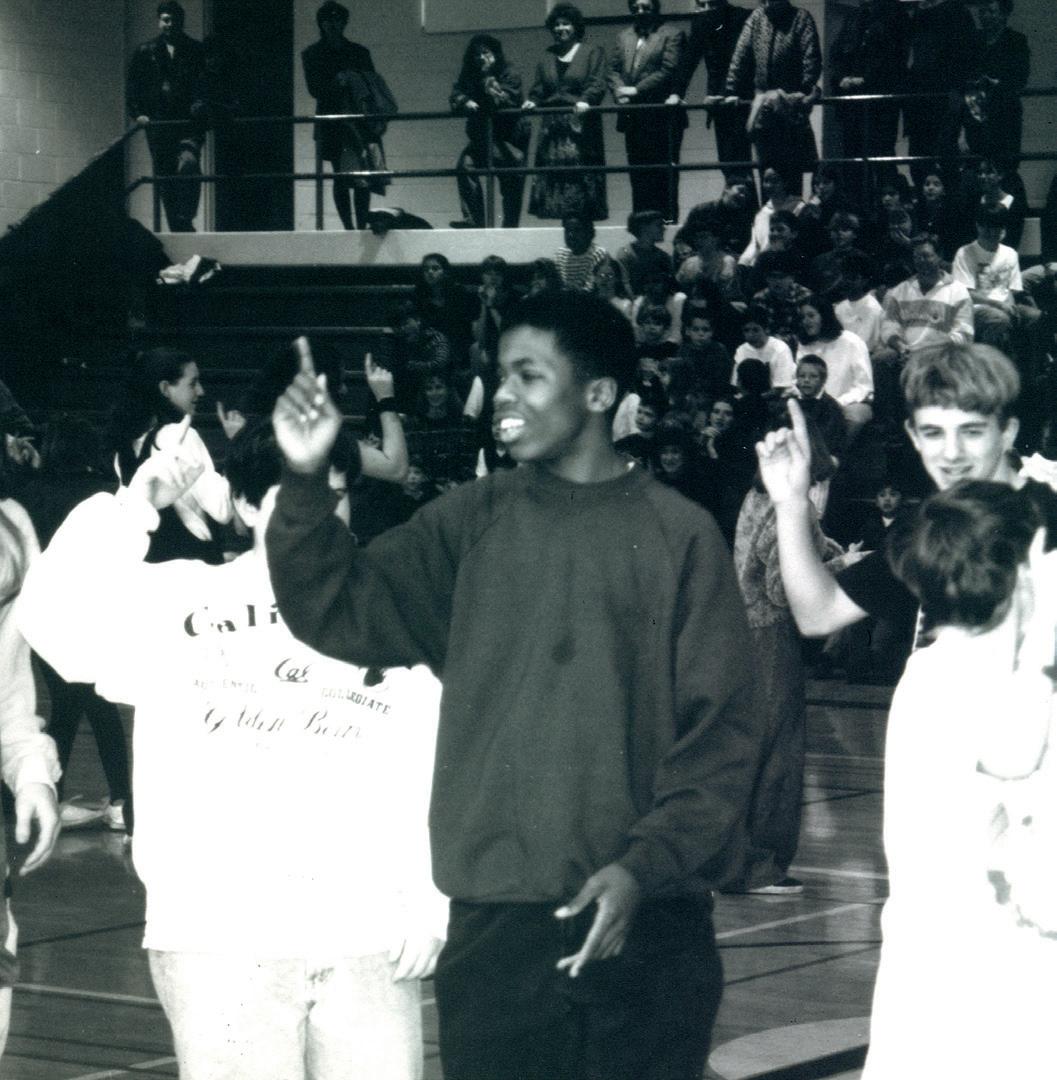
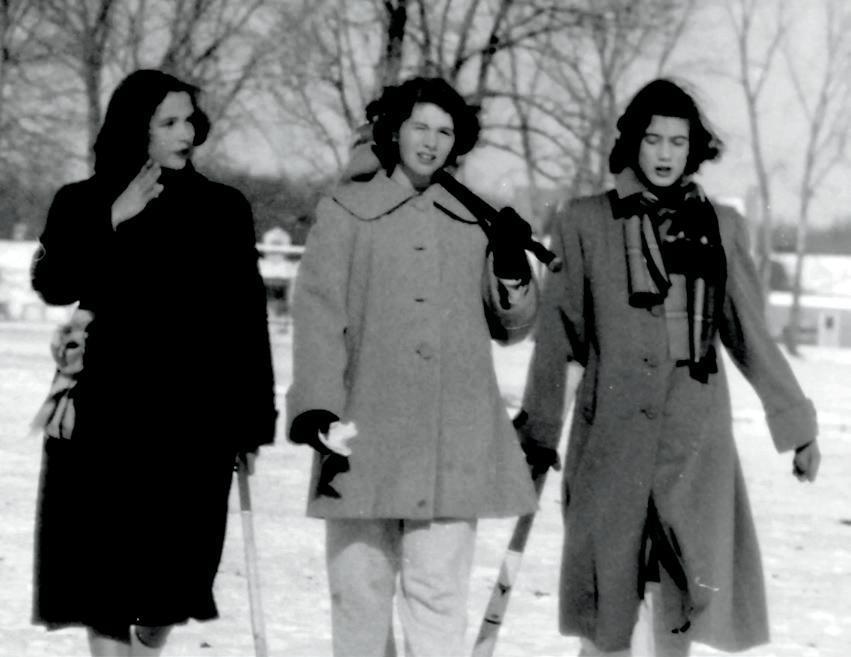

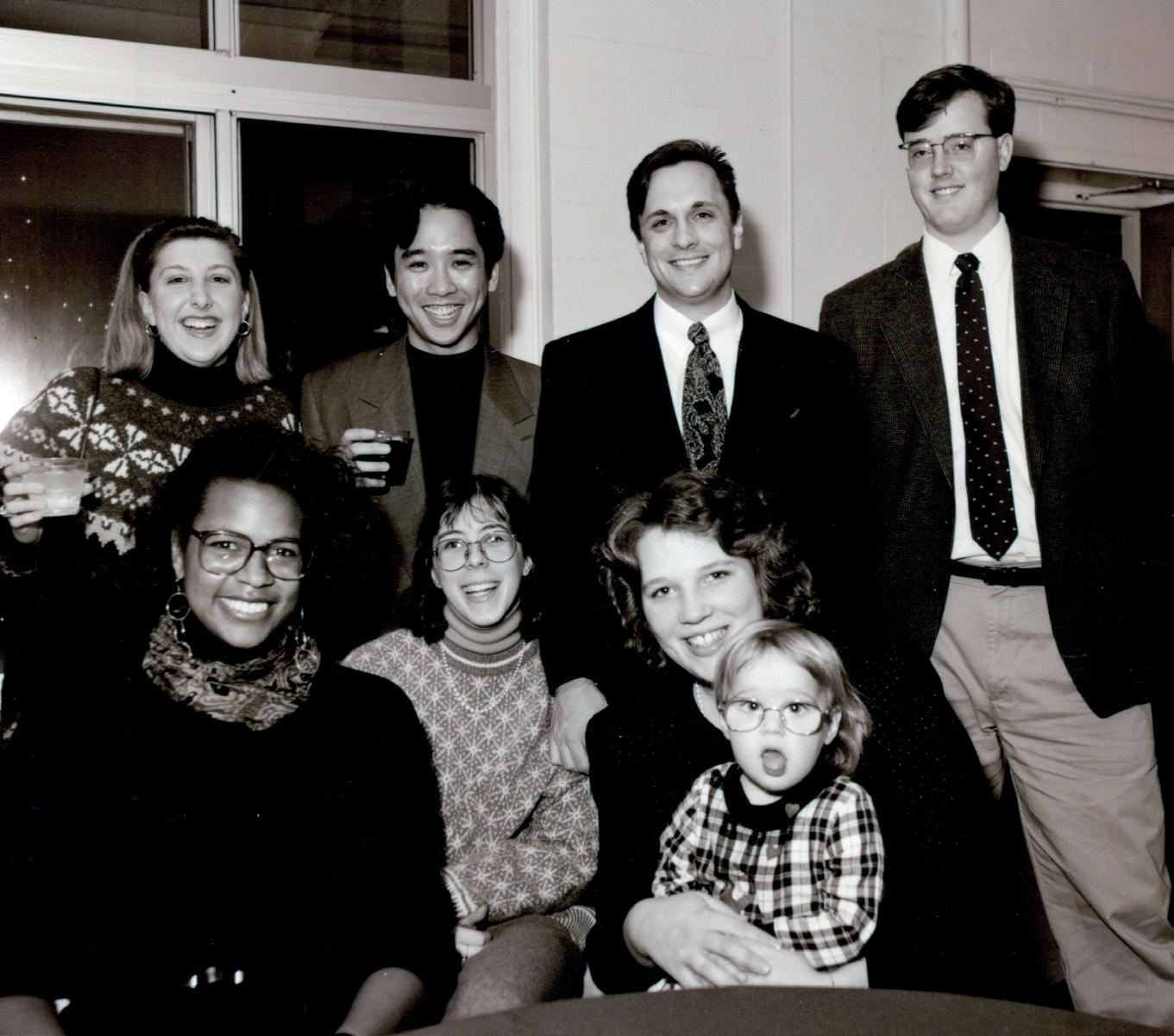
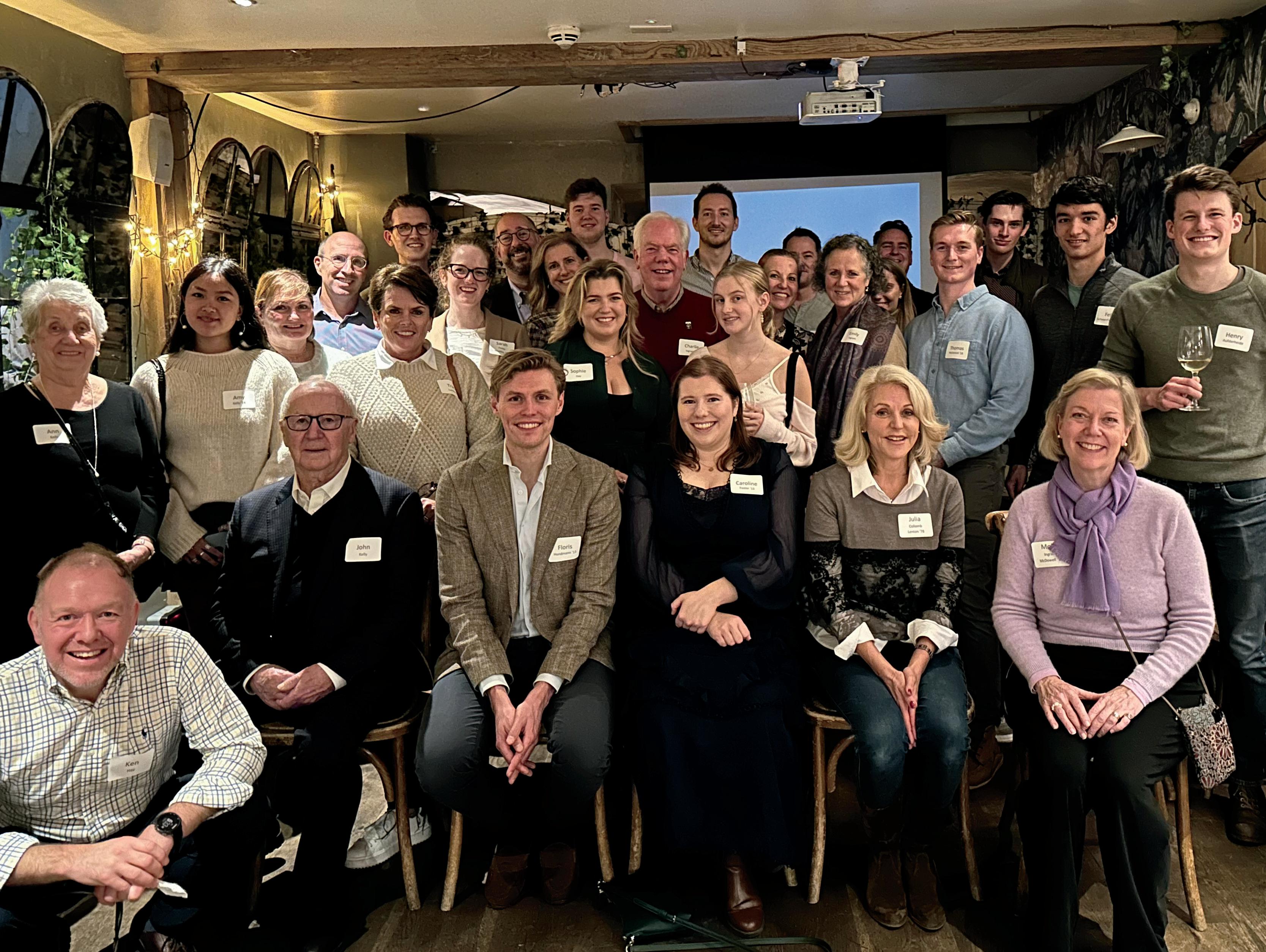
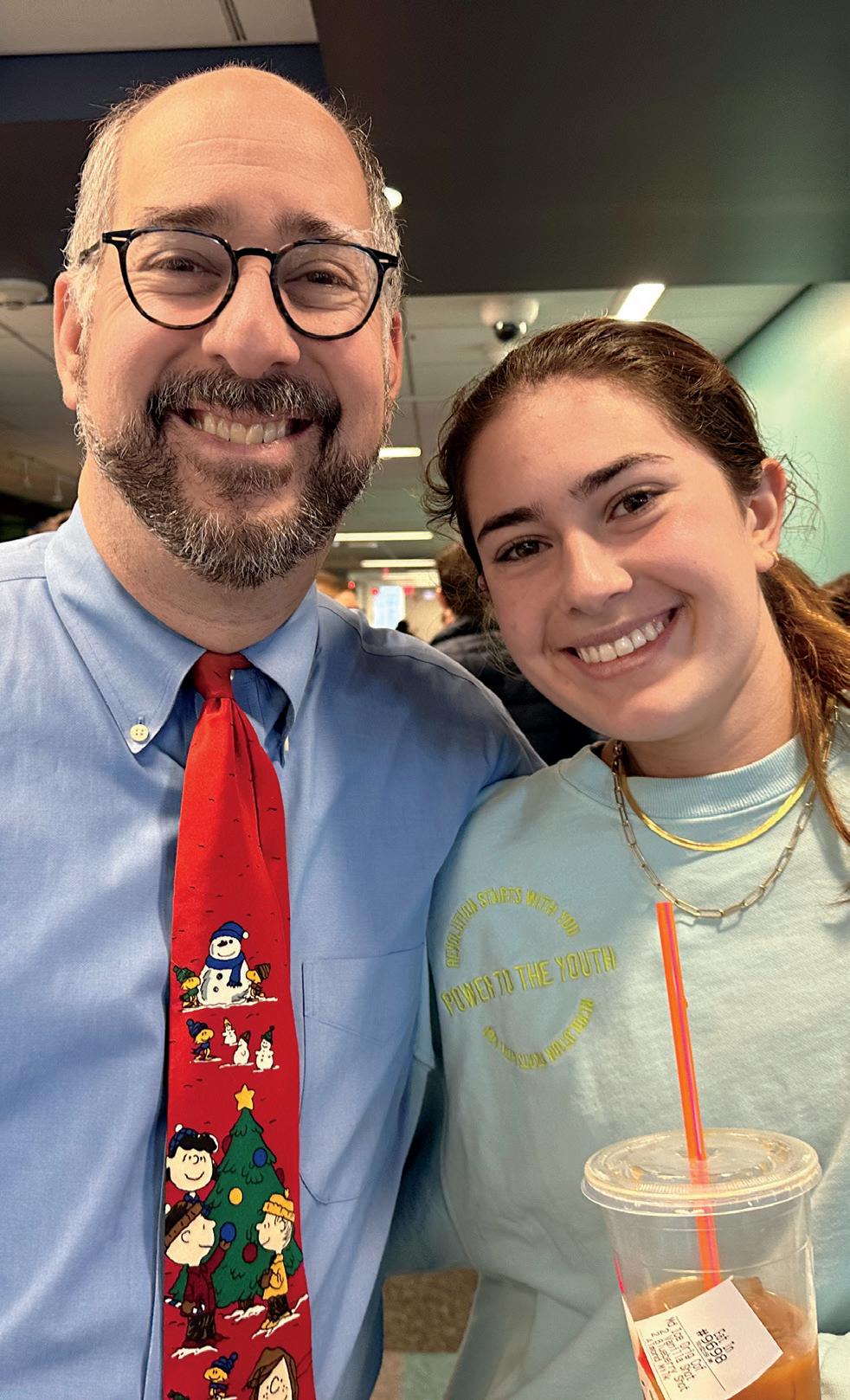



 The Potter Family: Ben ’16, Nick ’22, Dave and Elisa with Perry Dunlap Smith
Brian Frederick, Mason Roberts-Jones ’22 and Jack Canmann ’22
Drea Gallaga and Rachel Block ’19
CLASS OF 1962. Lauren Doolittle Ansaldo, Jonathan Strong, Ron Cahan, Jim Howe, Eleanor Wagner Cornog, Lane Jennings and Tom Geraghty
The Potter Family: Ben ’16, Nick ’22, Dave and Elisa with Perry Dunlap Smith
Brian Frederick, Mason Roberts-Jones ’22 and Jack Canmann ’22
Drea Gallaga and Rachel Block ’19
CLASS OF 1962. Lauren Doolittle Ansaldo, Jonathan Strong, Ron Cahan, Jim Howe, Eleanor Wagner Cornog, Lane Jennings and Tom Geraghty

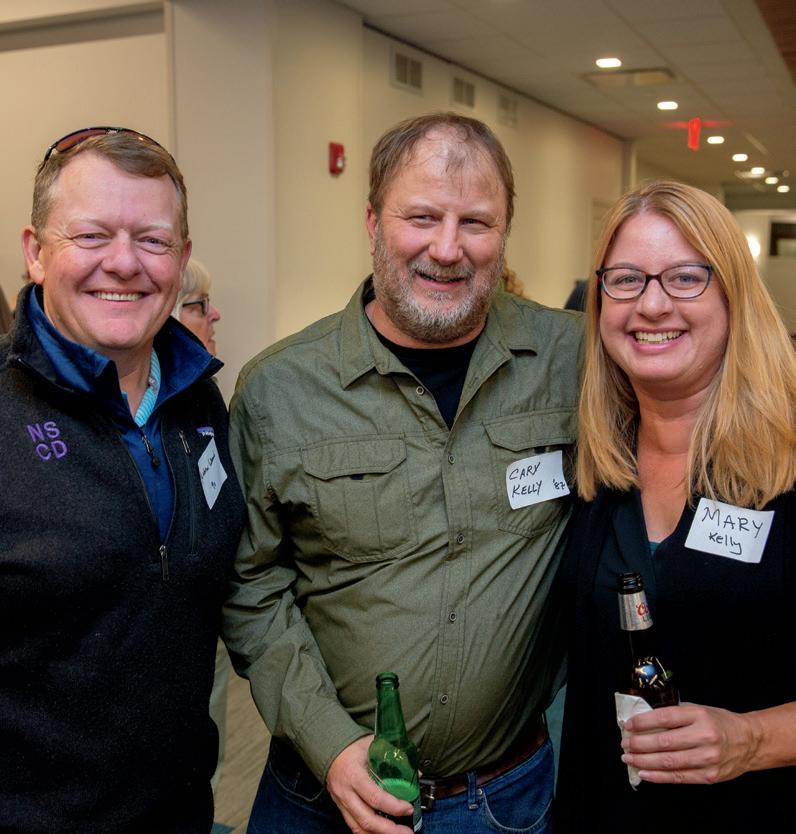
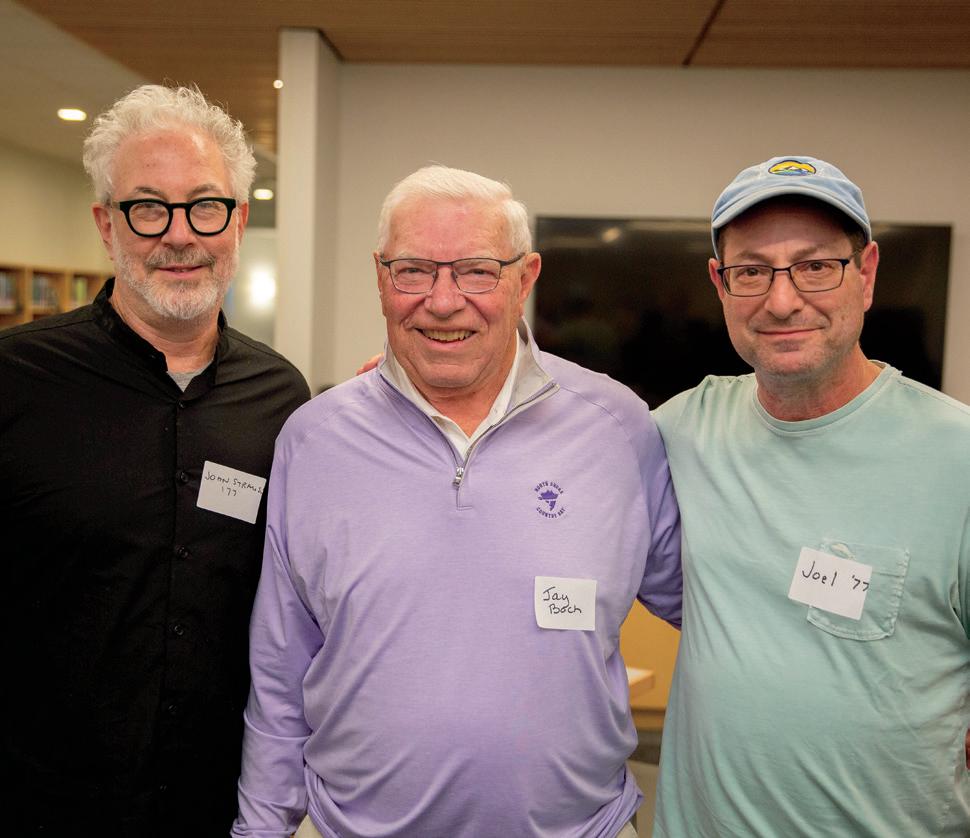
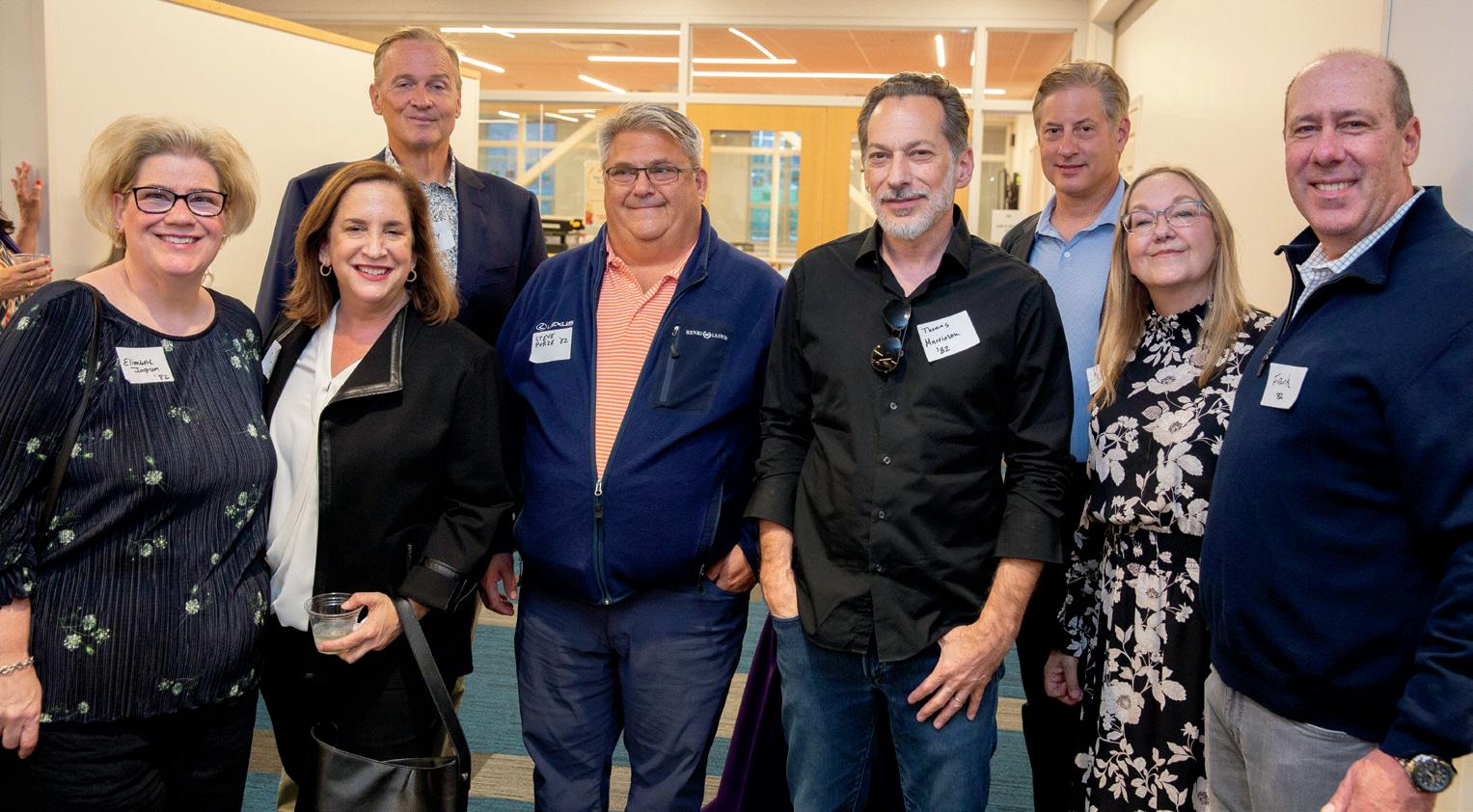



 CLASS OF 1977 Back Row William Thompson, Anita Thompson, Michael Lipman, Mark Sargis, Anne Hines Young, John Strauss, Lauren Stone, Matt Wells, David Sahlin, Jane Alexander Beck and Charlie Colbert; Front Row Elizabeth Sargis, Dan Deuble, Lucy Yee and Joel Feinstein
Andrew Wood ’90, Cary Kelly ’87 and Mary Kelly
John Strauss ’77, Jay Bach and Joel Feinstein ’77
CLASS OF 1982. Elizabeth Ingram, Jennifer Stone, J.T. Beatty, Steve Purze, Thomas Marrinson, John Whitlock, Lisa Jones and Frank Lieberman
CLASS OF 2012. Grace Flickinger, Rachel Mabie and Jeannie Peters
CLASS OF 1972. Phyllis Beattie, Bob Stibolt, Susan Stetson, Douglas Frohman and Nancy Pfisterer Leon
Emily Finlay Vertrees ’07 and Alex Vertrees ’07 with their son Henry
Dylan Ball ’12, Charlie Morris ’12, Drea Gallaga, Lynsey Wollin-Casey and Ben Goren ’12
CLASS OF 1977 Back Row William Thompson, Anita Thompson, Michael Lipman, Mark Sargis, Anne Hines Young, John Strauss, Lauren Stone, Matt Wells, David Sahlin, Jane Alexander Beck and Charlie Colbert; Front Row Elizabeth Sargis, Dan Deuble, Lucy Yee and Joel Feinstein
Andrew Wood ’90, Cary Kelly ’87 and Mary Kelly
John Strauss ’77, Jay Bach and Joel Feinstein ’77
CLASS OF 1982. Elizabeth Ingram, Jennifer Stone, J.T. Beatty, Steve Purze, Thomas Marrinson, John Whitlock, Lisa Jones and Frank Lieberman
CLASS OF 2012. Grace Flickinger, Rachel Mabie and Jeannie Peters
CLASS OF 1972. Phyllis Beattie, Bob Stibolt, Susan Stetson, Douglas Frohman and Nancy Pfisterer Leon
Emily Finlay Vertrees ’07 and Alex Vertrees ’07 with their son Henry
Dylan Ball ’12, Charlie Morris ’12, Drea Gallaga, Lynsey Wollin-Casey and Ben Goren ’12

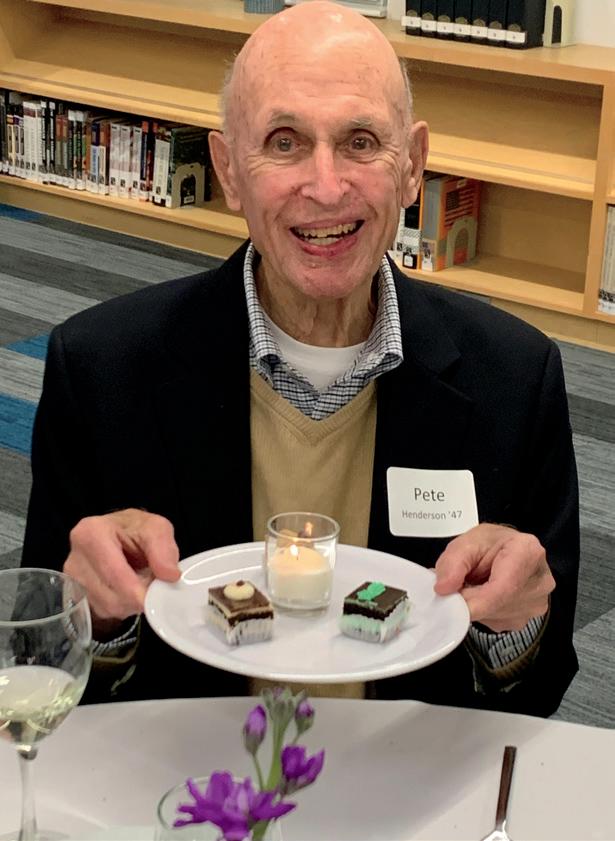


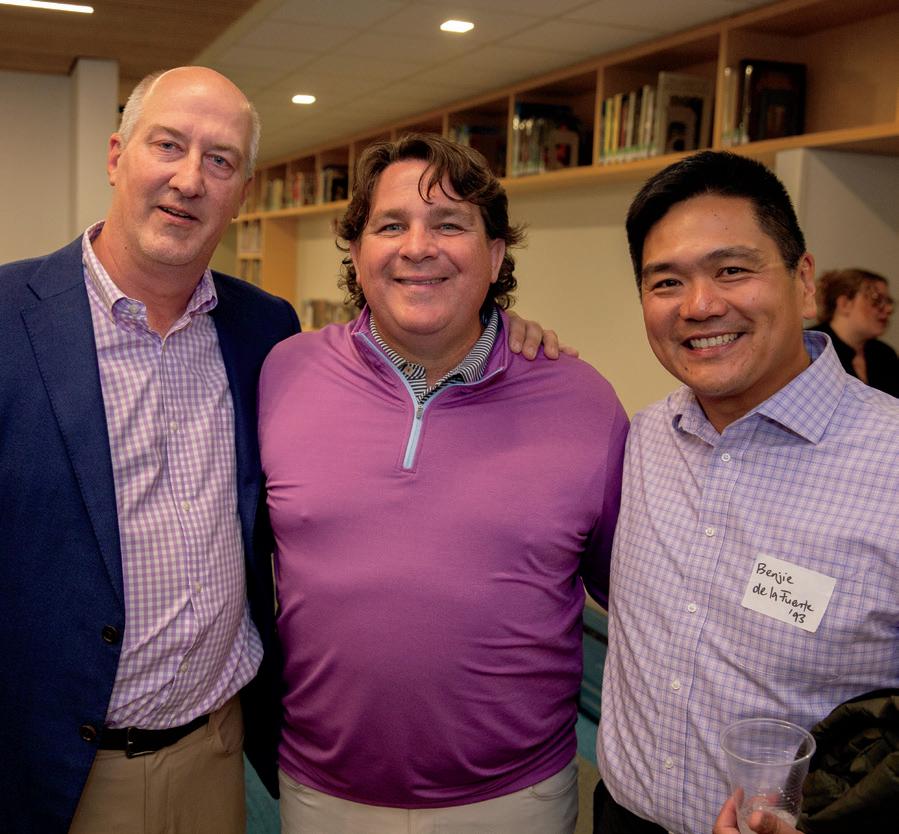

 CLASS OF 1947. Pete Henderson
CLASS OF 1962. Eleanor Wagner Cornog, Lane Jennings, Jim Howe, Jonathan Strong, Ron Cahan, Lauren Doolittle Ansaldo and Tom Geraghty
Luke Bakalar ’97, Tom Doar and Hillary Wirtz ’97
CLASS OF 1982. Lisa Patton, Elizabeth Ingram, John Whitlock, Amy Vieregg, Bob Vieregg, Steve Purze, Kymberly Marrinson, Tom Marrinson, J.T. Beatty, Jennifer Stone, Heather Whitlock and Lisa Jones
CLASS OF 2002. Back Row Bryan Cagan, Lauren Segal Ingalls, Jordan Fisher, Anand Patel, Joyce Randall, Nate Flint, Meera Sinha, Brendan Leonard, Jaime Powers Freeman, Emily Fitz-Gerald Prozeller, Brad Lohmeyer, Naomi Hattori, Evan Birnholz and Lydia Uhlir; Front Row Benjy Blenner, Michael Lehman, Kate Levine and Peter Fine
CLASS OF 1987. Joel de la Fuente, Cary Kelly, Molly Shotwell Oelerich, Bill Bach, Ari Kogut, Martin Hofmann, Lauri Reagan Harris, Dimitria Cook, Larry Williams and Fiona McDonagh Farrell
Bill Bach ’87, Cy Oelerich ’89 and Benjie de la Fuente ’93
CLASS OF 1947. Pete Henderson
CLASS OF 1962. Eleanor Wagner Cornog, Lane Jennings, Jim Howe, Jonathan Strong, Ron Cahan, Lauren Doolittle Ansaldo and Tom Geraghty
Luke Bakalar ’97, Tom Doar and Hillary Wirtz ’97
CLASS OF 1982. Lisa Patton, Elizabeth Ingram, John Whitlock, Amy Vieregg, Bob Vieregg, Steve Purze, Kymberly Marrinson, Tom Marrinson, J.T. Beatty, Jennifer Stone, Heather Whitlock and Lisa Jones
CLASS OF 2002. Back Row Bryan Cagan, Lauren Segal Ingalls, Jordan Fisher, Anand Patel, Joyce Randall, Nate Flint, Meera Sinha, Brendan Leonard, Jaime Powers Freeman, Emily Fitz-Gerald Prozeller, Brad Lohmeyer, Naomi Hattori, Evan Birnholz and Lydia Uhlir; Front Row Benjy Blenner, Michael Lehman, Kate Levine and Peter Fine
CLASS OF 1987. Joel de la Fuente, Cary Kelly, Molly Shotwell Oelerich, Bill Bach, Ari Kogut, Martin Hofmann, Lauri Reagan Harris, Dimitria Cook, Larry Williams and Fiona McDonagh Farrell
Bill Bach ’87, Cy Oelerich ’89 and Benjie de la Fuente ’93


